- Skip to primary navigation
- Skip to main content
- Skip to primary sidebar
Teaching Expertise
- Classroom Ideas
- Teacher’s Life
- Deals & Shopping
- Privacy Policy

42 Engaging English Activities For High School
December 27, 2023 // by Jill Webb
Are you an English teacher looking for learning games and activities to help enliven your English language arts teaching? We know that sometimes teenage students can easily lose interest. So, don’t be a boring teacher—bring a few unique ideas into your lessons to keep them invested! Below is a list of fun and creative activities for high school students. It includes a variety of English language learning experiences—from poetry to writing and more! If you’re ready to engage your students while helping them increase their language skills, read on!
1. Paint Chip Poetry
This is a fun activity that’s easy to understand and set up. This game will challenge your students to use paint names to create beautiful pieces of poetry. A mix of paint chips, poetry prompts, and “variation cards” to keep things interesting makes for a unique way for your kids to experiment with words and poetry. It’s also great to add to your classroom party game stash!
Learn More: Amazon
2. Figurative Language Challenge
You already know that nothing beats repetition when it comes to helping your high schoolers grasp new concepts—but coming up with new ways to practice concepts can be time-consuming! This bundle includes simple challenges to get your students practicing different types of figurative language; it includes metaphors, similes, alliteration, and more. Editable worksheets and slides review the concepts for your learners—then, they task them with developing their own examples. These activities are great for inclusion classes because they work in stations.
Learn More: Teachers Pay Teachers
3. Six-Word Memoirs
This writing activity sounds simple but is deceptively challenging: writing six-word memoirs. Explain to your students that briefer writing demands greater attention to each word. Then, reinforce this lesson by having them each write their own memoir—in only six words! This activity is an innovative writing challenge, a hands-on introduction to memoirs, and a surefire way to get to know your teens and help them connect with each other. Plus, you can display their final creations along with corresponding images of their choosing.
Learn More: Six-Word Memoirs
4. The Break-Up Letter
Need a clever and relatable creative writing exercise ? Try this letter-writing activity with a hilarious twist. Rather than write a typical letter, your students will be asked to write a break-up letter! These printable prompts are a perfect way to get your teens thinking about how well they explain themselves in their writing.
Learn More: Presto Plans
5. Pop Sonnets
Here’s a fun way to fill some extra time with your teens—while also reinforcing their understanding of Shakespearean language. This clever book is full of familiar pop songs—rewritten the way Shakespeare might have penned them! “Translating” lyrics they already know will help your high schoolers practice and better grasp the language in Shakespeare’s plays.
6. Listening Skills
We all know it’s important to teach young kids how to listen; it can be easy to forget that your high schoolers still need guidance and practice to be good listeners! Be sure to emphasize this essential school and life skill with your teens—this blog post gives some concrete, tangible ways to teach and encourage active listening skills. Challenge your students to honestly complete a self-assessment of their own listening skills. Then, use these exercises to work together to improve their scores!
Learn More: The Secondary English Coffee Shop
7. Reading Bingo
A lot of the activities on this list are about class and group work—but there’s no getting around the value of good old-fashioned independent reading. Gamify your teens’ reading by distributing Bingo cards. Then, offer a prize for the first student to read all the books on the card or in a certain pattern! All you need to do is edit the cards to match your readers’ level and let the competition begin!
Learn More: Spark Creativity
8. Poetry Slam
Poetry can get a bad rap in high school—help your students get more engaged by making sure they know it’s not all love poems and sonnets! A poetry slam is an ideal way to expose your teens to a new medium. Inviting your high schoolers to perform their works for the class helps build their confidence and gives them a voice. You’ll be surprised when you see the smooth-talking skills of your kids!
Learn More: Teacher of Vision
9. Truth or Dare Grammar
If you need an easy lesson plan to review grammar, look no further. This fun game for your teenage learners will help get them invested in grammatical skills! You—and your kids—already know how to play truth or dare. This editable version is grammar-themed and school-appropriate. It’s a perfect activity to pull out at the end of the day when you still want to reinforce your kids’ learning.
10. Book Spine Poems
Have you heard of book spine poetry? It’s exactly what it sounds like; your students can arrange the text they find on book spines to craft surprisingly insightful poems! All you really need is a collection of books, but these simple worksheets will help your kids organize their work without having to carry around a stack of books. If you don’t have enough books on hand for everyone, never fear—turn this into an online game and allow them to “hunt” for titles online!
11. Soccer Ball Questions
You don’t need to be in the hot seat with questioning skills when teaching a lesson! Make one of these Socratic soccer balls—just add question prompts to a regular soccer ball. When it’s time to get your teens to practice their Socratic questioning skills, all you need to do is have them roll the ball and pose a question based on the first prompt they see.
Learn More: Building Bo o k Love
12. Black-Out Poetry
Here’s another great activity for your lower-intermediate learners—this black-out activity will challenge your students to use a page of a book to create a poem by blacking out specific words. Surprisingly, the rigid constraints are a creative way to help your teens who may struggle to find inspiration or with writer’s block. If you have early finishers, ask them to find fun images to pair with their fresh poem.
Learn More: Arapahoe Libraries
13. Review Game
A quiz challenge is a great way to review all the material for key lessons. In this fun game your learners will play a “Let’s Make a Deal” game—based on the popular game show. You’ll act as the game show host and make deals with the teams. This downloadable resource includes editable elements so you can customize the game and prizes for your own classroom.
Learn More: The Hungry Teacher Blog
14. Balderdash
Balderdash is a class board game for a reason. This small-group game will get your high schoolers laughing as they try to trick each other with made-up definitions for uncommon words. It’s a fun, unexpected way to teach new vocabulary while getting your students thinking critically and creatively! You can use a regular version of the game or just create your own using online resources.
Learn More: Boardgame Geek
16. NYT Crossword
A classic—and much beloved—game in the US is the New York Times daily crossword! Did you know there’s also a student version? Printing off one of the puzzles is a great, no-prep language exercise for your more advanced English classes.
Learn More: The New York Times
17. Inklewriter
Inklewriter is an innovative tool that can be used to get your students working individually on their creative writing. The free app makes use of interactive writing—sort of like a classic Choose-Your-Own-Adventure story made high-tech. The prompts and questions will guide your teens while still challenging them to flex their creative muscles as they create their own unique stories.
Learn More: Inkle Writer
18. Book Raffle
A book raffle tradition will help to get your lower-level class invested in reading—especially if your students don’t have many of their own books. All you’ll be doing is inviting your kids to compete for the chance to read specific books; creating excitement around a fundamental language activity in the process—independent reading! To get started, simply select a few books—they can be new or ones already in your class—and introduce them all to your learners. Then, your readers can enter their names in draws to win reading rights to their favorites. Once you have a few book raffles under your belt, feel free to modify the process to make it work for you and your teens!
Learn More: Brown Bag Teacher
19. Writing Prompts
Writing prompts are a classic classroom tool to jumpstart creative writing. Provide your students with this list of enticing prompts that are sure to help them produce literary genius. To get them started, you can let them pick their own from the list or assign them at random. Either way, you’ll have a low-prep way to get great results from your high school writers.
Learn More: Small World
20. Vocab-Zee
This language-themed twist on the classic game of Yahtzee is a great rainy-day activity or sub plan for your class. Put your students in groups and provide them with copies of the game instructions. Then, they’ll take turns rolling the dice and performing vocabulary-based actions based on their roll.
Learn More: Go Sadlier
21. Body Biographies
Help your pupils become masters of character analysis by assigning these eye-catching body biographies. Prompt your young writers to examine the different characteristics of each character—both tangible and intangible—and use them to create a character analysis. The visual aspect of the posters makes this activity more engaging than a written description and encourages your kids to search for different elements of character roles in the text. Not only will your students love doing this, but you’ll also be able to display their body biographies for reference.
Learn More: Study All Knight
22. Podcast Pairings
Consider pairing relevant literary podcasts with your classroom texts/discussions. Introducing a different medium into your teaching toolbox is an excellent way to change up your methods and better engage auditory learners. These podcasts are sure to give your students different perspectives on the topics and ideas that are introduced and discussed in your classroom texts.
Learn More: Building Book Love
23. Keyhole Book Scene
This is a clever visual way to emphasize the importance of different characters’ points of view. Having your students create a keyhole book scene gives you the opportunity to check your students’ understanding and comprehension of a story. Ask your learners to illustrate a scene from one of the texts they are reading—from the perspective of someone looking into the room through a keyhole. You can base the assignment on a specific character’s point of view or let your kids choose the perspective themselves. They should be encouraged to include different text elements and imagery to show what exactly the specific book scene “looked like” in their minds.
Learn More: The Room Mom
24. Crime Stories
Have you ever considered engaging your high school literacy students with creepy crime stories? Your teens can pick a real-life criminal and use their investigative skills to determine motives and other crime components. Then, have them choose a medium—blog, podcast, research paper, etc.—to present their perspective. The real-world aspect makes these narratives particularly compelling—and your learners will be so engaged in the crimes that they won’t realize how much hard work and learning they’re actually doing!
Learn More: Besp o ke ELA
25. Song Lyrics to Teach Paraphrasing
What teenager doesn’t love music? Here’s a great way to use this to your advantage! Print off lyrics to popular songs that your students will love. Then, challenge your kids to go through the lyrics and attempt to paraphrase what the song is saying, using their own words. This will help them get a better understanding of what their favorite songs are about as well as give them practice in their rewording skills.
Learn More: Mondays Made Easy
27. Selfie Fingerprint Poem
Poetry can be a tricky topic to introduce—and a particularly hard one to get your high schoolers excited about. With this fun fingerprint poem, your students can use colors and stanzas to create a poem that represents themselves and is as unique as their fingerprints. This is a great way to get your students excited about introducing themselves and things that they consider to be important.
29. Funny Short Story Study
Looking for something to break up the heavier literary units you have planned this year? This diverse bundle of hilarious short stories is perfect for teaching your students short and sweet literary concepts such as sarcasm, irony, foreshadowing, etc.
Learn More: Hopefully Home
30. Thought Bubble
Do your students need help delving into the thoughts of the characters you’re reading about? This simple thought bubble exercise will get your high schoolers engaged in deeper-level thinking. All they have to do is imagine what a character in a book, a short story, or even an image is thinking. Then, they can write it in a thought bubble on a sticky note. Getting into the habit of considering characters’ inner thoughts will encourage your readers to pay more attention to the text and make stronger connections with the stories.
Learn More: The Thinker Builder
31. Escape Rooms
Make learning fun for your high school English students by incorporating escape room activities in your classroom! You can download an escape room kit online that incorporates concepts from books your students are reading in class—or design your own! An escape room is an interactive way to encourage teamwork among your kids and enhance their understanding and application of the texts you’ve covered.
Learn More: Teach Nouvelle
33. The What If Game
The what if game is sure to get your students’ creative juices flowing! This group activity is fun and easy to set up. You’ll start by dividing your learners into groups of four to five, giving every group three cups—one for characters, one for settings, and one for actions. The groups will begin by brainstorming examples for each category and placing them in the cups. Then the real fun begins! Have your kids take turns drawing papers, one from each cup, and combining them in “What if?” questions. The last step is to use their what if question as a story prompt, being sure to fully explore the character, setting, and action they’ve drawn. Your high schoolers will enjoy the mix of group brainstorming and individual writing—and produce their own literary masterpieces in no time!
Learn More: Bespoke Classroom
34. Hexagonal Thinking
Hexagonal thinking is another dynamic group brainstorming activity—and a great way to help your students think critically about texts and make broader connections. After reading through a story with your class, separate your students into groups. Then, give each group a series of blank paper hexagons and have them fill in various themes, characters, quotes, and even simple drawings. Once they’re done, task your kids with working together to arrange the hexagons in a web—in a layout based on logical connections between the cards.
Learn More: Now Spark Creativity
35. Mock Trials
Help your students examine a text through mock trials. After reading through a story, pick a student to be the prosecutor (or a group of students to be a team of prosecutors) and a student to be the defendant (or team of defendants). Give your kids time and tips for drafting their arguments, and then select a jury from their classmates. When everyone is ready, it’s time for the trial! You can be the judge, critiquing your students’ logic and powers of persuasion. Your teens will have so much fun playing their roles that they won’t even notice the preparation and research involved!
Learn More: Now Spark Creativity
36. Graphic Essay
Looking to shake up your students’ essays? Graphic essays are a clever way to introduce visual elements into a traditional writing assignment. Your students will use pictures and symbols to convey certain portions of the story. It’s a helpful way to engage visual learners and encourage all your kids to think and express themselves in new ways. They’ll appreciate the chance to inject their work with their own creativity—and the break from normal essay writing!
Learn More: Living in the Layers
37. Elements of Fiction Stations
Get your class up and moving around the room with these informative stations that teach the basic elements of fiction. At each station, your learners will delve deeper into elements of fiction such as setting, conflict, characters, point of view, and plot structure. You can have your kids visit these stations during certain time periods or even different class periods.
Learn More: Hey Natayle
38. Figurative Language Tasting
Who doesn’t love to eat tasty snacks while learning? Get your students actively involved in your delicious and savory lesson using a few snacks. Explain to your kids that the objective of this lesson is to practice using different figurative language elements to describe both the taste and feelings of snacks. Then, let the fun begin! Distribute the snacks to your young gourmets—along with prompts that challenge them to describe the tastes using various types of figurative language. It’s sure to help your high schoolers develop a taste for descriptive writing!
Learn More: It’s Lit Teaching
39. Explode the Moment
Are your kids having trouble expanding their thoughts and ideas during writing time? With this activity, your students will be challenged to expand or “explode” the moment they are writing about. For example, if your learner writes “The park was fun,” they’ll be prompted to explain the entire moment at the park, using sensory imagery. This is a relatable method to encourage your high schoolers to consider the “who, what, where, when” portions of their writing.
Learn More: Raise the Bar Reading
40. Figurative Language Sort
Even though this activity was created with younger children in mind, that doesn’t mean your high school students won’t be engaged and excited to participate. You’ll need to prepare for this activity by collecting some interesting pictures and writing sentences about them using different types of figurative language that you’ve studied in class. To begin, give your high schoolers (individually or in a small group) one of the pictures, along with the related sentences. Then, task them with categorizing the sentences based on the type of figurative language. Lastly, encourage those who finish quickly to come up with their own examples for each category!
Learn More: Teaching with a Mountain View
41. Movement in the Classroom
One way to make learning especially memorable for your students—and re-energize them if they need it—is to get them moving and actively participating in the engaging lesson. This doesn’t have to be complicated or require a lot of prep; you can find simple ways to add movement to work you’re already doing. For example, don’t just give your high schoolers a list of discussion questions; print out the questions and place them around your classroom. This will get your kids up and moving as they talk to each other!
Learn More: Building Book Love
42. Literary Puzzle Pieces
Sometimes a simple visual can give your students a new perspective on their work. Help them understand literary themes by comparing them to jigsaw puzzles—drive the point home by having them create their own paper puzzle pieces as they discuss the themes in your texts. First, put your high schoolers in small groups and give each group large paper puzzle pieces. Explain that each puzzle piece represents an element in your book; as they fill in the pieces they’ll be “solving the puzzle” of understanding your text. You can use this activity in different ways depending on the needs of your class, combining group discussion with independent work. It’s an ideal, hands-on discussion prompt to help your kids better grasp the subject material.
Learn More: Learning in Room 213
404 Not found
- Free Resources
- Project Ideas
- Login/Register Remember Me Register

If you’re looking for a fun group project for 4 or more kids, wacky abstract word art activity is just the ticket. Offering writing practice and grammar review, this isn’t your average art project.
Kids practice building sentences with different parts of speech, then create paintings of the silly mad-lib sentences they come up with. In an unexpected fun twist, at the end they get to rip up their paintings and arrange them into wild and unique abstract collages.
Autobiographies
In this fun project, you ask the students to detail their life history in an interesting tone. To avoid monotone, ask them to only include those events in life which they consider adventurous or unforgettable.
Ask them to highlight emotions rather than timeline.
You can add a twist to the exercise by asking them to write their ideal future life in an epilogue.
This project will focus on verbal communication skills.
Ask the students to select a book or excerpt from a book to read. You can assign a genre to keep the communication streamlined.
Students can take turns to give a short review of their reading together with their viewpoints about it. They can talk about the moral values of the characters or change endings or events to discuss if the plot becomes more entertaining with these changes.
Check out these ideas on how to run a successful Book Club !
Class Magazine

This is a perfect project for all classes in middle and high school. You can take it to the next level by asking the whole school to start a competition for the best class magazine.
You can ask your class to select a theme of environmental, health, literary, or societal topic.
Then ask them to gather all skills; idea-generation, writing, design, and presentation. You will get the most benefits if you make it mandatory for every student to produce content for one page of the magazine. (You can include the advertisement activity within the activity of class magazine.)
Comic Strip
This is another extensive project that will not only win the hearts of your students but also allow you to assess their creative capabilities.
Ask them to illustrate interesting events from their lives, or imagination, in the form of comic strips.
ALSO READ: SPEAKING ACTIVITIES FOR ANY LANGUAGE CLASS
This activity is similar to the comic activity given above. The only difference is the increased detail that is required in drama writing. An absence of images adds the obligation on the students to describe scenes and expressions.
Again, students can describe any life event from their reality or imagination.
You can later ask the students to act on the best dramas to improve their verbal and non-verbal communication.
Paper Mache Activity

In this messy yet super fun project, students make paper mache futuristic Earths or other imaginary planets as described in science fiction.
This was my cross-curricular activity based off of our Literature reading of Do Androids Dream of Electric Sheep? and a unit topic in English about the environment and recycling. Of course, you can do paper mache for any lesson or unit that you have!
This article gives you the step-by-step instruction on how to do paper mache in the classroom!
Editorial/ Fan Letter
Editorial is one of English project ideas most suitable for high-schoolers while fan letters work for learners from all English expertise levels.
Ask your high-schoolers to analyze a societal issue that is close to their heart. Next, they need to define the problem from the viewpoint of aggrieved parties. Ask them to write out the problem and get it published in a local or national newspaper.
(Be ready to proofread and edit the piece before they send it to relevant personnel.)
Younger students can write fan letters to their best actors, authors, and singers.
This is another English project which will combine societal, and practical, understanding with English learning. In this project, the students will learn problem-solving skills.
Ask them to understand a societal or scientific problem. Once they have understood and defined this issue, they have to provide a solution to this problem.
In the end, they have to present their solution together with the need which gave rise to it in front of the class. (You may want them to include a video presentation with visual effects .)

This activity is one of my students’ favorite s not only because it’s fun but also because it facilitates their learning. I tried this project on two literature readings I had before (The Prince and the Pauper by Mark Twain and Robinson Crusoe by Daniel Defoe) and both achieved the same fantastic end.
In this project, students are tasked to illustrate the setting or a specific part of the book in the form of a three-dimensional miniature scene. Students will pick a favorite scene from the story they are reading and decide how they want to represent it using the materials given (above) and a variety of design strategies.
This writing exercise contains the most fun among all the given projects. You will excite their creativity as well as their inner critic.
Start by inquiring about the literary work which fascinates or inspires them most.
Ask them if they can add humor to that piece. Let them edit a single character or scene or if they want they can give a humorous outlook to the whole plot.
Fables
This open-ended English writing project will ask the students to select one event in their life. This event should be intriguing as well as contain a life lesson.
Then, they have to retell this piece in third person pronoun. Ask them to keep the tone conversational as well as engaging.
In the end, ask them to write a conclusive moral of the story.
POPULAR: 5 Project-based Learning for High School English
Self-Portrait Project

These self-portrait ideas were part of a short project that went really with my middle school ESL class so I thought I’d share them with you.
My students were able to come up with three products in one activity: a mind map, a self-portrait and an essay. The unit topic was about “Identity” or “Personality” but I guess this will work for general descriptive adjectives lesson as well.
Charts
If you want to include futuristic touch to your English lessons, include a thing or two from STEM subjects. One great way is to ask them to explain or detail a mathematical chart. (You can come up with variations in this original plan. For example, you can ask future businessmen to interpret graphics related to market studies.)
See, if they have enough vocabulary and concepts to comprehend and convey the message to their fellows.
Fictional Pen-Pals
Just like fan letters, this activity asks the students to write letters to their favorite characters in fictional and non-fictional worlds.
Ask them to pinpoint the era, region, settings they like most in a given novel or historical account. Next, they would show interest in one of its characters and the reason for this interest.
In the end, they need to write a letter to this character praising or advising him/her regarding his/her role in the piece. (You can reply on behalf of that character if you think the point made by the student inspires further dialogue.)
Book Trailer Project

Book Trailer Project is a digital storytelling activity for middle school or high school students after they finish reading a book. Students need to take the key idea from the book to create a short video that persuades people to check out a book they have read.
Doing the book trailer project requires students to summarize, synthesize and analyze the book and put that analysis in their trailer. Furthermore, having students create book trailers is a great way to incorporate technology in the classroom and encourage reading. Thus, book trailer project is a great alternative to boring book report assignments, and can easily be done individually or in groups.
So these are some of creative English project ideas you can use in your English class to prompt your students to express their creativity and language skills. These are fun, practical, and learning-inducing.
Are you on Pinterest? Save this post!

EN101 Author
Related posts.

Cultivating Growth Mindset: Problem-Solving Activities for Students

Activity Ideas for Teaching English as a Foreign Language

10 Backyard Games to Keep Your Kid Active This Summer

Make Learning ESL Vocabulary Fun with these 10 Interactive Websites

Practical Classroom Management Tips for Teachers
Leave a comment.
You must be logged in to post a comment.
Privacy Policy

22 Creative English Activities For Students in High School

Top 12 Ultimate Secret to Happy Marriage

What is an Anti Inflammatory Diet: Food to Eat, and Avoid

1st Oscar Award: Unveiling Hollywood’s Glittering Beginnings

What Foods Neutralize Stomach Acid Immediately!

What is a flat white coffee? Google Doodle celebrates the beverage

Oscar 2024 Winners: The Academy Winners, Red Carpet & Highlights

Top 15 Reasons Fashion is Important and Essential

15 Home Remedies for Period Cramps Relief

International Women’s Day 2024: Inspire Inclusion
Breeds of chicken that will lay lots of egg for you.

Top 100 Unique Dog Names For Your Canine Companion

Leap Day 2024: The Story of Growing Up with a Unique Birthday
- Terms & Conditions
- Privacy Policy

Manicure and Pedicure for Men

Different Dress Tie Knots: How to Tie and the Occasion for Each

How to Wear Black Shoes With Blue Trousers For Men

Creativity At The Workplace: Examples and Benefits

Open Pores on Cheeks – How To Close and Get Rid of Quickly

How to Style Denim Jacket with Any Outfit in 2024

Apple Cider Vinegar: Best Time To Drink And Uses.

The Health Benefits Of Chamomile Tea: What Is It Good For?

Health Benefits of Cactus: What Are Its Benefits

15 Top Tips to Lower Cholesterol Naturally

Benefits of Drinking Hot Water For The Body

Causes of Diarrhea in Adults | Symptoms and Treatment.

Domestic Violence and Abuse | Getting Help and Healing
Effects of menopause on the female body.

Creativity is Intelligence Having Fun! Albert Einstein

List of Summer Olympic Sports: Dive Into The Thrills of Paris 2024

84 Inspirational Quotes for New Beginnings: Embrace A Fresh Start

Paris Olympics Opening Ceremony: Unity Ignites The Seine River!

56 Beautiful Good Night Quotes For Her Beautiful Sleep

Best Neighborhoods for Families in Los Angeles

Social Media Addiction: What It Is, Signs, and What to Do About It

The 12 Best Resorts in Bali, Indonesia (With Prices)

Art Galleries: Top 15 World’s Best Museums and Galleries

24 Amazing Things to Do in Marrakech, Morocco

20 Best AI Movies for Both AI and Movie Fans 2024

15 Extraordinary Generative AI tools – Updated List 2024

Google Bard vs ChatGPT: Which is Better? What is the Difference 2024

Why is Python So Popular? 15 Reasons Why Python is the Best

Top 5 best AI tools for Designers 2024

HTML Coding For Beginners: Build Your First Website Easily!

Top 10 Best Hosting Brands you can trust 2024.

Top 14 Best Free Ai Logo Generators 2024

The 2024 Best Free AI PowerPoint generator
- Business & Career
- Entertainment
- Real Estate
- Relationships
Beyond textbooks: Fuel student passion with innovative and joyful English activities.

Creative English Activities For Students: Tired of textbooks leaving your students snoring? Ditch the dull and ignite a fire of English learning with these creative activities! From rewriting classic stories to creating comic strips, these ideas will have your students laughing, engaged, and mastering the language in no time. So, grab your imagination and get ready to transform your classroom into a language playground!
Let’s see the first Ten Creative English Activities For Students:
Table of Contents
#1 Creative English Activity for Students – Hangman
Enhance vocabulary and spelling skills by guessing words.
- Provide clues for players to guess letters.
- Encourage collaboration and strategic thinking.

Conduct surveys to gather and analyze data on various topics. Surveys are a good activity to use with advanced students or with larger groups of learners. Students can use surveys to ask questions in English
- Design survey questions.
- Collect, analyze, and present survey results.
#3 Creative English Activity for Students – Alphabet Relay
Reinforce alphabet recognition and teamwork skills.
- Divide students into teams.
- Each team races to recite the alphabet in order.
#4 Board Race

Foster quick thinking and knowledge recall.
- Divide the board into sections with different topics.
- Students race to answer questions or complete tasks.
#5 Categories
Enhance vocabulary and quick thinking skills.
- Choose a category (e.g., animals, countries, foods).
- Students take turns naming items within the category.
#6 Creative English Activity for Students – Creative Writing
Spark imagination and storytelling skills.
- Provide prompts or story starters.
- Encourage students to write creatively and share their stories.

Develop critical thinking and argumentation skills.
- Assign topics and teams for debates.
- Research, prepare arguments, and engage in structured debates.
#8 Creative English Activity for Students – Role-playing
Encourage empathy and communication skills.
- Assign roles or scenarios for students to act out.
- Promote improvisation and creative problem-solving.
#9 Literary Magazine Publication

Collaborate to produce a literary magazine featuring original poetry, short stories, and artwork from students, showcasing creativity and fostering a sense of community.
- Solicit submissions, curate content, and design layouts for publication.
#10 Shakespearean Parody Plays
Rewrite scenes from Shakespearean plays with a modern twist, incorporating contemporary language and settings, fostering creativity and understanding of classic literature.
- Adapt and perform scenes in a comedic or dramatic manner.
More Creative English Activities For Students in High School

#11 Creative English Activity for Students – Mystery Mission
Solve hidden riddles around the classroom for teamwork and a hidden treasure.
- Hide riddles leading to a prize chest.
- Students solve the riddles in teams to find the next clue.
#12 Songwriting Showdown
Craft historical figure ballads in groups to express understanding musically.
- Research assigned figures and write catchy lyrics with historical details.
- Collaborate on melodies and choruses, then perform for the class.
#13 Creative English Activity for Students – News Flash!

Collaboratively produce a school newspaper to develop writing, communication, and design skills.
- Assign roles like reporters, editors, and designers.
- Cover school events, conduct interviews, and design the layout.
#14 Comic Capers
Create comic strips featuring favorite literary characters using imagination and humor.
- Use blank templates for students to draw characters in funny situations.
- Include dialogue bubbles and sound effects, then display finished strips.
#15 Movie Magic
Reenact book scenes as short films in groups to deepen comprehension and collaboration.
Choose a book and divide scenes for filming.
Write simple scripts, gather props, and film creatively using cameras or phones.
#16 Creative English Activity for Students – Time Travel Trek

Write h istorical figure correspondence letters to promote research and empathy.
- Research two contrasting figures and write letters from their perspectives.
- Respond with a letter from the other figure’s viewpoint.
#17 Debate Club Duel
Engage in structured debates on current issues to hone critical thinking skills.
- Research a controversial topic, form teams for opposing sides, and debate respectfully using evidence.
#18 Board Game Bonanza
Design novel-based board games in teams to analyze and recreate narratives.
- Choose a novel, brainstorm elements, and design the board, rules, and mechanics.
- Playtest and provide feedback on each other’s creations.
#19 Creative English Activity for Students – Mad Libs Mania
Fill story blanks with random words to reinforce grammar and have creative writing fun.
- Use Mad Libs templates with blank spaces for different parts of speech.
- Students provide random words without knowing the context, then read the completed stories aloud.
#20 Recipe Remix

Reimagine traditional recipes as poems to practice creative and descriptive language.
- Choose a recipe and guide students to use vivid descriptions for ingredients, textures, and cooking techniques.
- Incorporate figurative language for a poetic effect.
#21 Character Dossiers
Create detailed character profiles for literary figures, delving into their motivations, traits, and development throughout a story:
Analyze character arcs and relationships through written profiles and group discussions.
#22 Creative English Activity for Students – Literary Tea Parties
Host themed literary tea parties where students dress up as characters from books, engage in discussions about literature, and enjoy tea and snacks, promoting socialization and appreciation for literature:
- Plan themed decorations, activities, and discussion topics related to chosen books or authors.
Creative English Activities for Adults
Expand your understanding of language and explore new ways to express yourself through these engaging activities. From lively discussions to creative expression, these options cater to different interests and skill levels.
Dive into book discussion groups. Host discussions about books, short stories, or thought-provoking articles.
- Share insights and interpretations.
- Debate different perspectives.
Join writing workshops. Explore writing prompts and exercises to improve your writing skills and unleash your creativity.

- Experiment with different writing styles.
- Give and receive constructive feedback.
Enjoy poetry readings. Share and discuss favorite poems or even your own writing with fellow enthusiasts.

- Analyze poetic techniques and devices.
- Perform and interpret poems expressively.
Connect through language exchange programs. Pair up with other students or international learners to practice speaking and writing in English together.
- Improve English fluency.
- Learn about different cultures.
English Activities for Kids
Make learning English fun and engaging for young children with these interactive activities! Whether it’s searching for hidden treasures or acting out stories, these activities encourage exploration, creativity, and language development while fostering a love for learning.
Embark on an alphabet scavenger hunt! Children search for objects in their environment that begin with each letter of the alphabet, aiding letter recognition and vocabulary development.
Try story sequencing with picture cards! Children arrange picture cards representing a story in the correct order, boosting comprehension and encouraging them to retell the story in their own words.
Play rhyming games! Kids participate in word games or sing familiar nursery rhymes, developing their phonemic awareness (the ability to hear and manipulate sounds in words).
Let’s put on puppet shows! Children design their own puppets and act out short plays or stories. This sparks their imagination, builds confidence, and promotes oral language skills.
Creative English Activities For Students – FAQ
How to teach english to young learners: 4 fun methods to try.
- Turn Lessons into Songs. Every English learner, both native and not, is familiar with, at the very least, one classic jingle. …
- Encourage Mnemonic Devices to Memorize Grammar Rules. …
- Include Games. …
- Review Vocabulary Through Role Playing.
How can I make my English class more fun?
What is the game that helps you learn english, what activity is useful for learning english, how do you engage students in an english lesson, how do you gamify an english lesson.
- The story, plot, setting, characters, and role-play. The first step to gamifying your classroom is deciding on the topic or theme. …
- Goals, badges, progress bars and leaderboards. …
- Competition, cooperation and challenges. …
- Rewards, points and second chances. …
- Choice. …
Related Posts
Who is Sir Bobby Charlton? | A Biography of Triumph and Success
10 Best Note Taking Apps to Organize Your Thoughts and Note
10 Python Programs For Practice: Can You Teach Yourself Python?

2023 Full list of Visa Free countries For Nigerians


Complete List Of Japan Passport Visa Free Countries 2023

10 Simple Ways on How to Cure Motion Sickness Permanently

Ankle Chains And Waist Beads: Fashion Or Fetish?

How NOT To Be A Boring Partner

How To Make Money Using Your Smartphone 2021

Copyright © 2023 Lifestyle Metro. Owned and Managed by Digital Marketing Skill LLC
- Health & Wellness
- Fashion & Beauty
- Food & Drinks
404 Not found

50 Creative Writing Prompts for Secondary ELA: Teaching Creative Writing in Middle and High School

Creative writing prompts are a great way to get students’ imaginations flowing and to help them develop their writing skills. Having fun and engaging prompts is a key element in teaching creative writing. These prompts can take many forms, from simple prompts that ask students to describe a character or setting, to more complex prompts that challenge students to explore a particular theme or idea.
You can use these prompts in your classroom in a number of ways. They can be used for micro writing assignments; this would be perfect for a bell ringer. They can also be used for collaborative writing, or even for a complete writing assignment.
Many of these creative writing prompts will work perfectly with my Narrative Writing Unit , which is tailored to students in grades 7-10!
Here are 50 creative writing prompts for secondary ELA:
- Write a short story about a character who discovers a hidden room in their house.
- Write a poem about the changing of the seasons.
- Write a journal entry from the perspective of a tree.
- Write a story about a character who travels to a faraway land.
- Write a poem about a particular emotion (e.g. love, anger, fear)
- Write a diary entry from the perspective of a character who is stuck in a time loop.
- Write a story about a character who discovers a secret about their family.
- Write a poem about the beauty of nature.
- Write a story about a character who has a magical ability.
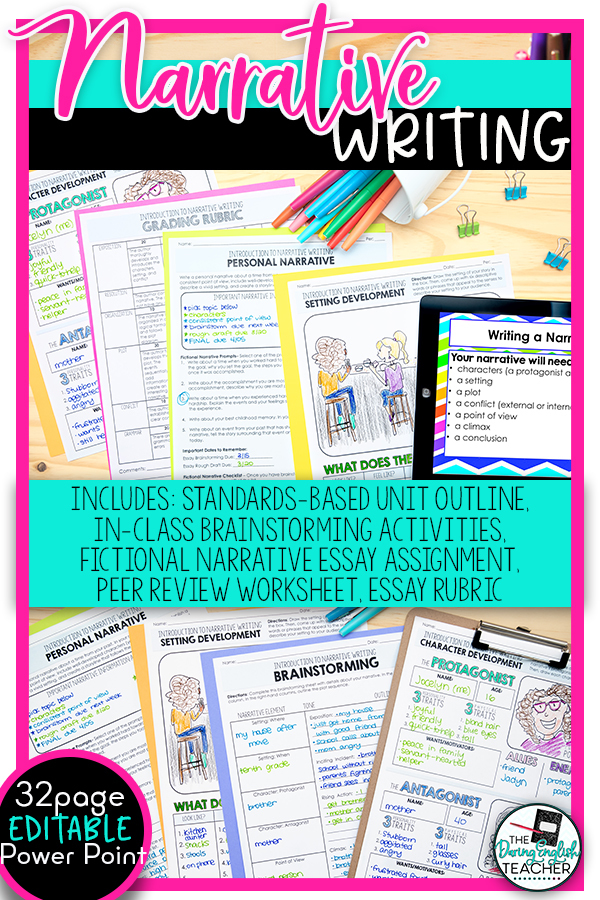
- Write a story about a character who is forced to confront their greatest fear.
- Write a poem about friendship.
- Write a story about a character who finds a mysterious object.
- Write a diary entry from the perspective of a character who is lost in a forest.
- Write a story about a character who has to make a difficult decision.
- Write a poem about the ocean.
- Write a story about a character who discovers a hidden talent.
- Write a diary entry from the perspective of a character who is living in a post-apocalyptic world.
- Write a story about a character who is transported to another dimension.
- Write a poem about the power of words.
- Write a story about a character who has to solve a mystery.
- Write a diary entry from the perspective of a character who is stuck in a dream.
- Write a story about a character who has to confront their inner demons.
- Write a poem about the passage of time.
- Write a story about a character who has to make a difficult choice between two paths.
- Write a diary entry from the perspective of a character who is living in a future society.
- Write a story about a character who has to overcome a great obstacle.
- Write a poem about your favorite season.
- Write a story about a character who must choose between two paths.
- Write a poem about a significant moment in your life.
- Write a story about a character who is dealing with a major change.
- Write a poem about your hometown.
- Write a story about a character who is trying to overcome a fear.
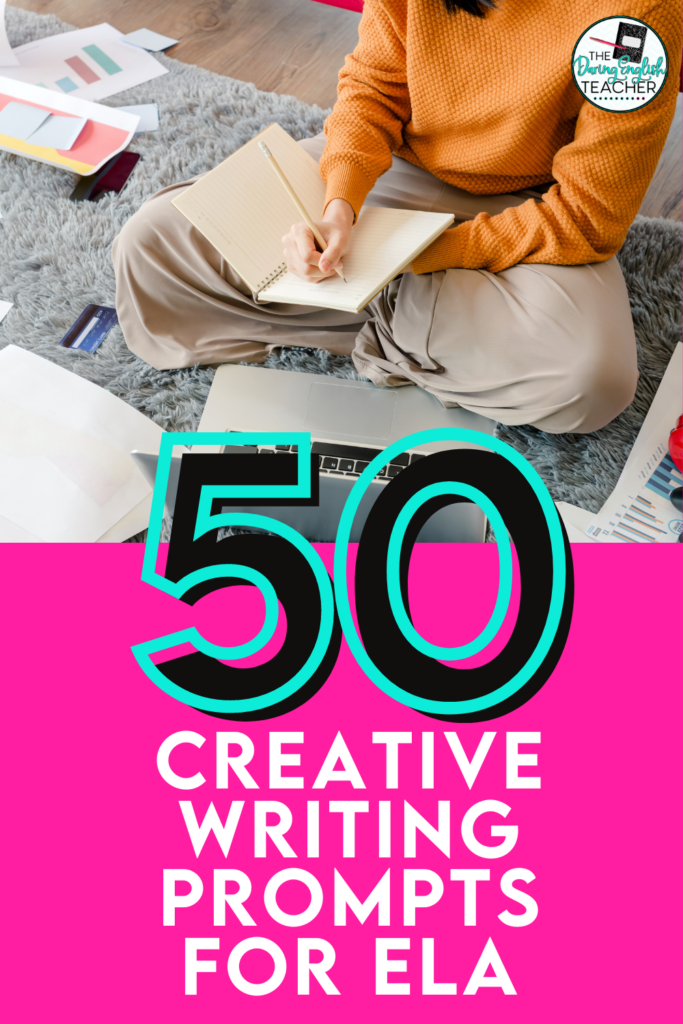
- Write a poem about your favorite memory.
- Write a story about a character who is trying to solve a mystery.
- Write a poem about your favorite person.
- Write a poem about a dream you had.
- Write a story about a character who has to face their worst nightmare.
- Write a poem about your favorite time of day.
- Write a story about a character who has to make a choice between two people they love.
- Write a poem about your favorite hobby.
- Write a story about a character who discovers a secret about themselves.
- Write a poem about your favorite food.
- Write a story about a character who must save someone they care about.
- Write a story about a character who must travel to a new and unfamiliar place.
- Write a story about a character who must confront their past.
Looking for Resources for Teaching Creative Writing?
Check out my Narrative Writing Unit ! This unit includes everything you need to teach creative writing in your classroom. With materials for both a personal and a fictional narrative, this ELA instructional unit helps you guide your students through the entire writing process!
Leave a Reply Cancel reply
Your email address will not be published. Required fields are marked *
Save my name, email, and website in this browser for the next time I comment.

SUBSCRIBE NOW
- CORE CURRICULUM
- LITERACY > CORE CURRICULUM > Into Literature, 6-12" data-element-type="header nav submenu" title="Into Literature, 6-12" aria-label="Into Literature, 6-12"> Into Literature, 6-12
- LITERACY > CORE CURRICULUM > Into Reading, K-6" data-element-type="header nav submenu" title="Into Reading, K-6" aria-label="Into Reading, K-6"> Into Reading, K-6
- INTERVENTION
- LITERACY > INTERVENTION > English 3D, 4-12" data-element-type="header nav submenu" title="English 3D, 4-12" aria-label="English 3D, 4-12"> English 3D, 4-12
- LITERACY > INTERVENTION > Read 180, 3-12" data-element-type="header nav submenu" title="Read 180, 3-12" aria-label="Read 180, 3-12"> Read 180, 3-12
- LITERACY > READERS > Hero Academy Leveled Libraries, PreK-4" data-element-type="header nav submenu" title="Hero Academy Leveled Libraries, PreK-4" aria-label="Hero Academy Leveled Libraries, PreK-4"> Hero Academy Leveled Libraries, PreK-4
- LITERACY > READERS > HMH Reads Digital Library, K-5" data-element-type="header nav submenu" title="HMH Reads Digital Library, K-5" aria-label="HMH Reads Digital Library, K-5"> HMH Reads Digital Library, K-5
- LITERACY > READERS > inFact Leveled Libraries, K-5" data-element-type="header nav submenu" title="inFact Leveled Libraries, K-5" aria-label="inFact Leveled Libraries, K-5"> inFact Leveled Libraries, K-5
- LITERACY > READERS > Rigby PM, K-5" data-element-type="header nav submenu" title="Rigby PM, K-5" aria-label="Rigby PM, K-5"> Rigby PM, K-5
- LITERACY > READERS > Science & Engineering Leveled Readers, K-5" data-element-type="header nav submenu" title="Science & Engineering Leveled Readers, K-5" aria-label="Science & Engineering Leveled Readers, K-5"> Science & Engineering Leveled Readers, K-5
- SUPPLEMENTAL
- LITERACY > SUPPLEMENTAL > A Chance in the World SEL, 8-12" data-element-type="header nav submenu" title="A Chance in the World SEL, 8-12" aria-label="A Chance in the World SEL, 8-12"> A Chance in the World SEL, 8-12
- LITERACY > SUPPLEMENTAL > Amira Learning, K-6" data-element-type="header nav submenu" title="Amira Learning, K-6" aria-label="Amira Learning, K-6"> Amira Learning, K-6
- LITERACY > SUPPLEMENTAL > Classcraft, K-8" data-element-type="header nav submenu" title="Classcraft, K-8" aria-label="Classcraft, K-8"> Classcraft, K-8
- LITERACY > SUPPLEMENTAL > JillE Literacy, K-3" data-element-type="header nav submenu" title="JillE Literacy, K-3" aria-label="JillE Literacy, K-3"> JillE Literacy, K-3
- LITERACY > SUPPLEMENTAL > Waggle, K-8" data-element-type="header nav submenu" title="Waggle, K-8" aria-label="Waggle, K-8"> Waggle, K-8
- LITERACY > SUPPLEMENTAL > Writable, 3-12" data-element-type="header nav submenu" title="Writable, 3-12" aria-label="Writable, 3-12"> Writable, 3-12
- LITERACY > SUPPLEMENTAL > ASSESSMENT" data-element-type="header nav submenu" title="ASSESSMENT" aria-label="ASSESSMENT"> ASSESSMENT
- MATH > CORE CURRICULUM > Arriba las Matematicas, K-8" data-element-type="header nav submenu" title="Arriba las Matematicas, K-8" aria-label="Arriba las Matematicas, K-8"> Arriba las Matematicas, K-8
- MATH > CORE CURRICULUM > Go Math!, K-6" data-element-type="header nav submenu" title="Go Math!, K-6" aria-label="Go Math!, K-6"> Go Math!, K-6
- MATH > CORE CURRICULUM > Into Algebra 1, Geometry, Algebra 2, 8-12" data-element-type="header nav submenu" title="Into Algebra 1, Geometry, Algebra 2, 8-12" aria-label="Into Algebra 1, Geometry, Algebra 2, 8-12"> Into Algebra 1, Geometry, Algebra 2, 8-12
- MATH > CORE CURRICULUM > Into Math, K-8" data-element-type="header nav submenu" title="Into Math, K-8" aria-label="Into Math, K-8"> Into Math, K-8
- MATH > CORE CURRICULUM > Math Expressions, PreK-6" data-element-type="header nav submenu" title="Math Expressions, PreK-6" aria-label="Math Expressions, PreK-6"> Math Expressions, PreK-6
- MATH > CORE CURRICULUM > Math in Focus, K-8" data-element-type="header nav submenu" title="Math in Focus, K-8" aria-label="Math in Focus, K-8"> Math in Focus, K-8
- MATH > SUPPLEMENTAL > Classcraft, K-8" data-element-type="header nav submenu" title="Classcraft, K-8" aria-label="Classcraft, K-8"> Classcraft, K-8
- MATH > SUPPLEMENTAL > Waggle, K-8" data-element-type="header nav submenu" title="Waggle, K-8" aria-label="Waggle, K-8"> Waggle, K-8
- MATH > INTERVENTION > Math 180, 5-12" data-element-type="header nav submenu" title="Math 180, 5-12" aria-label="Math 180, 5-12"> Math 180, 5-12
- SCIENCE > CORE CURRICULUM > Into Science, K-5" data-element-type="header nav submenu" title="Into Science, K-5" aria-label="Into Science, K-5"> Into Science, K-5
- SCIENCE > CORE CURRICULUM > Into Science, 6-8" data-element-type="header nav submenu" title="Into Science, 6-8" aria-label="Into Science, 6-8"> Into Science, 6-8
- SCIENCE > CORE CURRICULUM > Science Dimensions, K-12" data-element-type="header nav submenu" title="Science Dimensions, K-12" aria-label="Science Dimensions, K-12"> Science Dimensions, K-12
- SCIENCE > READERS > inFact Leveled Readers, K-5" data-element-type="header nav submenu" title="inFact Leveled Readers, K-5" aria-label="inFact Leveled Readers, K-5"> inFact Leveled Readers, K-5
- SCIENCE > READERS > Science & Engineering Leveled Readers, K-5" data-element-type="header nav submenu" title="Science & Engineering Leveled Readers, K-5" aria-label="Science & Engineering Leveled Readers, K-5"> Science & Engineering Leveled Readers, K-5
- SCIENCE > READERS > ScienceSaurus, K-8" data-element-type="header nav submenu" title="ScienceSaurus, K-8" aria-label="ScienceSaurus, K-8"> ScienceSaurus, K-8
- SOCIAL STUDIES > CORE CURRICULUM > HMH Social Studies, 6-12" data-element-type="header nav submenu" title="HMH Social Studies, 6-12" aria-label="HMH Social Studies, 6-12"> HMH Social Studies, 6-12
- SOCIAL STUDIES > SUPPLEMENTAL > Writable" data-element-type="header nav submenu" title="Writable" aria-label="Writable"> Writable
- For Teachers
- PROFESSIONAL DEVELOPMENT > For Teachers > Coachly" data-element-type="header nav submenu" title="Coachly" aria-label="Coachly"> Coachly
- PROFESSIONAL DEVELOPMENT > For Teachers > Teacher's Corner" data-element-type="header nav submenu" title="Teacher's Corner" aria-label="Teacher's Corner"> Teacher's Corner
- PROFESSIONAL DEVELOPMENT > For Teachers > Live Online Courses" data-element-type="header nav submenu" title="Live Online Courses" aria-label="Live Online Courses"> Live Online Courses
- For Leaders
- PROFESSIONAL DEVELOPMENT > For Leaders > The Center for Model Schools (formerly ICLE)" data-element-type="header nav submenu" title="The Center for Model Schools (formerly ICLE)" aria-label="The Center for Model Schools (formerly ICLE)"> The Center for Model Schools (formerly ICLE)
- MORE > undefined > Assessment" data-element-type="header nav submenu" title="Assessment" aria-label="Assessment"> Assessment
- MORE > undefined > Early Learning" data-element-type="header nav submenu" title="Early Learning" aria-label="Early Learning"> Early Learning
- MORE > undefined > English Language Development" data-element-type="header nav submenu" title="English Language Development" aria-label="English Language Development"> English Language Development
- MORE > undefined > Homeschool" data-element-type="header nav submenu" title="Homeschool" aria-label="Homeschool"> Homeschool
- MORE > undefined > Intervention" data-element-type="header nav submenu" title="Intervention" aria-label="Intervention"> Intervention
- MORE > undefined > Literacy" data-element-type="header nav submenu" title="Literacy" aria-label="Literacy"> Literacy
- MORE > undefined > Mathematics" data-element-type="header nav submenu" title="Mathematics" aria-label="Mathematics"> Mathematics
- MORE > undefined > Professional Development" data-element-type="header nav submenu" title="Professional Development" aria-label="Professional Development"> Professional Development
- MORE > undefined > Science" data-element-type="header nav submenu" title="Science" aria-label="Science"> Science
- MORE > undefined > undefined" data-element-type="header nav submenu">
- MORE > undefined > Social and Emotional Learning" data-element-type="header nav submenu" title="Social and Emotional Learning" aria-label="Social and Emotional Learning"> Social and Emotional Learning
- MORE > undefined > Social Studies" data-element-type="header nav submenu" title="Social Studies" aria-label="Social Studies"> Social Studies
- MORE > undefined > Special Education" data-element-type="header nav submenu" title="Special Education" aria-label="Special Education"> Special Education
- MORE > undefined > Summer School" data-element-type="header nav submenu" title="Summer School" aria-label="Summer School"> Summer School
- BROWSE RESOURCES
- BROWSE RESOURCES > Classroom Activities" data-element-type="header nav submenu" title="Classroom Activities" aria-label="Classroom Activities"> Classroom Activities
- BROWSE RESOURCES > Customer Success Stories" data-element-type="header nav submenu" title="Customer Success Stories" aria-label="Customer Success Stories"> Customer Success Stories
- BROWSE RESOURCES > Digital Samples" data-element-type="header nav submenu" title="Digital Samples" aria-label="Digital Samples"> Digital Samples
- BROWSE RESOURCES > Events" data-element-type="header nav submenu" title="Events" aria-label="Events"> Events
- BROWSE RESOURCES > Grants & Funding" data-element-type="header nav submenu" title="Grants & Funding" aria-label="Grants & Funding"> Grants & Funding
- BROWSE RESOURCES > International" data-element-type="header nav submenu" title="International" aria-label="International"> International
- BROWSE RESOURCES > Research Library" data-element-type="header nav submenu" title="Research Library" aria-label="Research Library"> Research Library
- BROWSE RESOURCES > Shaped - HMH Blog" data-element-type="header nav submenu" title="Shaped - HMH Blog" aria-label="Shaped - HMH Blog"> Shaped - HMH Blog
- BROWSE RESOURCES > Webinars" data-element-type="header nav submenu" title="Webinars" aria-label="Webinars"> Webinars
- CUSTOMER SUPPORT
- CUSTOMER SUPPORT > Contact Sales" data-element-type="header nav submenu" title="Contact Sales" aria-label="Contact Sales"> Contact Sales
- CUSTOMER SUPPORT > Customer Service & Technical Support Portal" data-element-type="header nav submenu" title="Customer Service & Technical Support Portal" aria-label="Customer Service & Technical Support Portal"> Customer Service & Technical Support Portal
- CUSTOMER SUPPORT > Platform Login" data-element-type="header nav submenu" title="Platform Login" aria-label="Platform Login"> Platform Login
- Learn about us
- Learn about us > About" data-element-type="header nav submenu" title="About" aria-label="About"> About
- Learn about us > Diversity, Equity, and Inclusion" data-element-type="header nav submenu" title="Diversity, Equity, and Inclusion" aria-label="Diversity, Equity, and Inclusion"> Diversity, Equity, and Inclusion
- Learn about us > Environmental, Social, and Governance" data-element-type="header nav submenu" title="Environmental, Social, and Governance" aria-label="Environmental, Social, and Governance"> Environmental, Social, and Governance
- Learn about us > News Announcements" data-element-type="header nav submenu" title="News Announcements" aria-label="News Announcements"> News Announcements
- Learn about us > Our Legacy" data-element-type="header nav submenu" title="Our Legacy" aria-label="Our Legacy"> Our Legacy
- Learn about us > Social Responsibility" data-element-type="header nav submenu" title="Social Responsibility" aria-label="Social Responsibility"> Social Responsibility
- Learn about us > Supplier Diversity" data-element-type="header nav submenu" title="Supplier Diversity" aria-label="Supplier Diversity"> Supplier Diversity
- Join Us > Careers" data-element-type="header nav submenu" title="Careers" aria-label="Careers"> Careers
- Join Us > Educator Input Panel" data-element-type="header nav submenu" title="Educator Input Panel" aria-label="Educator Input Panel"> Educator Input Panel
- Join Us > Suppliers and Vendors" data-element-type="header nav submenu" title="Suppliers and Vendors" aria-label="Suppliers and Vendors"> Suppliers and Vendors
- Divisions > Center for Model Schools (formerly ICLE)" data-element-type="header nav submenu" title="Center for Model Schools (formerly ICLE)" aria-label="Center for Model Schools (formerly ICLE)"> Center for Model Schools (formerly ICLE)
- Divisions > Heinemann" data-element-type="header nav submenu" title="Heinemann" aria-label="Heinemann"> Heinemann
- Divisions > NWEA" data-element-type="header nav submenu" title="NWEA" aria-label="NWEA"> NWEA
- Platform Login
SOCIAL STUDIES
PROFESSIONAL DEVELOPMENT
Activities & Lessons
Free High School English Language Arts Activities

To help your learners discover their own writing styles and embrace reading, check out the fun high school language arts activities below. Support students' voices with hands-on English lessons on how to analyze poems, podcasts, and arguments, complete with videos, downloadable worksheets, and more.

5 Social-Emotional Learning Activities for High School Students
These five social-emotional learning activities for high school students are based on CASEL's core SEL competencies. This lesson plan will help mold your students into independent and meaningful contributors to society.
January 29, 2021

29 Back-to-School Writing Prompts for Middle and High School
School's back in session, which means it's time for a fresh batch of writing prompts for the new year. Have your high school or middle school students try these Back-to-School prompts this fall.
Ali Habashi
August 10, 2021

Mayan Pyramids vs. Egyptian Pyramids Lesson Plan Idea
Looking to include ELA instruction in your social studies classroom? This Mayan pyramids vs. Egyptian pyramids lesson plan idea has students discuss the similarities and differences between the two types of structures through writing an essay.
Shaped Staff
August 5, 2021

25 Valentine's Day Writing Prompts and Ideas
No matter what your middle school or high school class is reading, these writing prompts about love will get them ready for Valentine's Day.
January 21, 2021

8 Black History Month Writing Prompts
Introduce students to Black innovators with these Black History Month writing prompts and guide them into a particular type of text, such as personal narrative, informative, or persuasive.
Perry Hollins
December 22, 2020

ELA Halloween Activities for Middle School and High School Students
Get your ELA class into the spirit with these fun Halloween activities for middle school and high school students, and learn from a few masters of horror how to really make those spines tingle and those bones shake.
Brenda Iasevoli
October 20, 2020

How to Write for TV: Virtual Collaboration and the Blank Page
Writing for television is certainly one of the more collaborative forms of writing. But collaboration is only the first step of the process, since the goal of The Writers Room is for writers to come away with an episodic assignment to complete.
Duane Capizzi
August 17, 2020

Literacy at Work: The Writers Room with Duane Capizzi
Have your students explore the exciting world of TV writing with a free lesson plan and insights from producer, writer, and Carmen Sandiego showrunner Duane Capizzi.

Great Summer Reads with Carol Jago: Never Give Up, Grades 9–12
Though the characters in these stories face challenges and obstacles, they never stop trying to do the right thing.

Great Summer Reads with Carol Jago: Stories You Won't Forget, Grades 9–12
These stories will probably stick with you the rest of your life—the characters and what they experience are just that unforgettable!
August 7, 2020

Great Summer Reads with Carol Jago: Dystopian Tales, Grades 9–12
Dystopian novels—often set in the future—depict undesirable or frightening societies where the citizens suffer from restrictions and/or injustices.
August 4, 2020

Literacy at Work: How to Write a Rap with Dr. Chris Emdin
Teach your students how to write a rap with Dr. Chris Emdin using this rap lesson plan, complete with a writing template, rubric, and teacher guide.
July 28, 2020

Great Summer Reads with Carol Jago: Friends and Family Matter, Grades 9–12
Though we may sometimes have differences of opinion with our friends or family members, they are often the ones we rely on to see us through difficult times.
July 27, 2020

Great Summer Reads with Carol Jago: Graphic Books for Grades 9–12
Graphic novels are hugely popular with readers of all ages. They capture our attention and keep us turning pages compulsively.
July 20, 2020

Great Summer Reads with Carol Jago: Did You Know? for Grades 9-12
This week’s suggested titles all fall into the nonfiction category, but they are anything but dull! If you like learning about real people and the real world, these are for you.
July 13, 2020

Great Summer Reads with Carol Jago: Fantasy Series for Grades 9-12
Escaping our own reality by diving into a fantastical world can be an exciting adventure and a therapeutic release.
July 7, 2020

Great Summer Reads With Carol Jago: Take a Book to the Movies! for Grades 9-12
When books are so engaging, filmmakers inevitably want to try adapting them for the big screen. Notice the changes they have made or have had to make as you read and watch.
June 29, 2020

Forgotten Stories of the Oregon Trail: Native American Oral History
Download a free Social Studies lesson plan and student activity about Native American Oral History on the Oregon Trail.
June 23, 2020

Great Summer Reads with Carol Jago: Into Space! for Grades 9-12
Visit Mars, tour the galaxy, and befriend curious species in this week’s great summer reads.
June 22, 2020

Grades 9–12 ELA Activity Set 10: Write Two-Sentence Stories and More
Have high schoolers find inspiration for stories in everyday objects or events and craft advice columns with these downloadable activities for at-home learning.
June 8, 2020

What’s on Your Mind? A Flexible SEL Freewrite
Help students in Grades 3–12 tap into what they're feeling with an informal writing activity.
Janna Sakson
June 5, 2020

Forgotten Stories of the Oregon Trail: Writing History
Students will learn from reading diary entries written on the Oregon Trail how such writings preserve history and bring the past to life.
Glenn Greenberg
June 4, 2020
Grades 9–12 ELA Activity Set 9: Write an Unnecessary Sequel and More
High schoolers can sharpen their writing skills with activities including a reflective essay on the past school year and a playlist for a book they read.
June 2, 2020

Grades 9–12 ELA Activity Set 8: Synthesize Information and More
For this week's activities, students can create a how-to video, use research to defend their stance on an issue, and respond to summer writing prompts.
May 26, 2020

Grades 9–12 ELA Activity Set 7: Memorize and Recite a Poem and More
With these downloadable activities, high schoolers will memorize and recite a poem, take notes as they read a novel, and memorialize a book in memes.
May 18, 2020
Grades 9–12 ELA Activity Set 6: Analyze a Podcast and More
Have your students explore haiku, analyze a podcast, and practice identifying literary terms with these downloadable activities for high schoolers.
May 11, 2020

Grades 9–12 ELA Activity Set 5: Teaching Metaphor by Carol Jago and More
High schoolers can sharpen their writing, language, critical thinking, and reading skills with these instructional resources.
May 5, 2020

Literacy at Work: Writing a Personality Feature with Esther Wojcicki
Esther Wojcicki shares her lesson on conducting an interview and writing a personality feature—an intriguing, creative article about the interviewee.
April 30, 2020

Fun At-Home Lesson for ELA: Write a Personality Feature and Other Activities
Teach students in Grades 3-12 how to conduct interviews and write compelling personality features with these insights from Esther Wojcicki.
Esther Wojcicki

Grades 9–12 ELA Activity Set 4: Create a Sketchnote and More
Activities including creating a sketchnote, writing an ode to an everyday item, and analyzing the theme of a short story.
April 28, 2020

Grades 9–12 ELA Activity Set 3: Evaluate a News Article and More
Have high schoolers continue learning from home by evaluating a news article for reliability, maintaining a dialectical journal, and responding to daily dinner prompts.
April 20, 2020

Grades 9–12 ELA Activity Set 2: Analyze a Poem and More
Have high schoolers analyze a poem, summarize an informational text, and write effective arguments with this week's downloadables activities.
April 13, 2020
Grades 9–12 ELA Activity Set 1: Ripped from the Headlines and More
Have high school students analyze news stories, poems, and short stories with these instructional resources designed for remote learning.
April 9, 2020
View more language arts teaching ideas for high school . Or, c heck out our full list of free learning activities for all grades and all subjects.
- Grades 9-12
- Activities & Lessons
Related Reading

13 Mother’s Day Celebration Ideas in School
Marcela Grillo Writer, Girls Write Now
March 12, 2024

Read 180: Frequently Asked Questions
VP Product Management, Supplemental & Intervention Solutions, HMH
March 8, 2024

What Is Phonics in Reading?
Dr. Shane Templeton Foundation Professor Emeritus, Literacy Studies, University of Nevada, Reno; Into Reading Program Author

10 Warm-Up Activities For High School English
Welcome, fellow adventurers of the mind, to a world of linguistic whimsy and grammatical games! As a high school student, you are probably familiar with the dread of walking into an early morning class and having to dive right into the lesson without any sort of preparation. But fear not, just like bell ringers, with the right warm-up activities, you can start your English class off on the right foot and set the tone for a successful and engaging lesson.
In this wondrous world of linguistic lunacy, we will explore various activities that will test your critical thinking, problem-solving, and communication skills. From unraveling scrambled sentences to creating alphabet stories, from guessing games to storytelling marathons, we will traverse through a landscape of language, where words come alive, and creativity reigns supreme.
So, whether you’re a seasoned wordsmith or a budding linguist, whether you love the sound of your own voice or prefer to listen and learn, there’s something here for everyone. Let’s dive into the depths of language, and emerge victorious as masters of the written and spoken word. Are you ready to let your linguistic prowess shine? Let’s begin!
High-energy warm-up activities for high school English
1. word association.

Let’s get our creative juices flowing with a fun game of word association! We’ll start with a word and take turns saying words that are associated with it. Who knows where this game will take us?
In this activity, start by writing a word on the board and have students take turns saying a word that is associated with the previous word. For example, if the first word is “cat,” the next student might say “dog,” and the next might say “pet,” and so on. Encourage students to be creative and think outside the box.
As a variation, you could also play the game with categories, such as “things you find in a kitchen” or “types of animals.” This game will allow students to enhance their vocabulary, and hence, can be a suitable SAT Prep Activity .
2. Alphabet Story

Get ready to put your storytelling skills to the test with Alphabet Story! We’ll start with the letter A and go around the room, each adding a sentence that starts with the next letter of the alphabet. Are you up for the challenge?
This activity is a fun way to encourage students to practice their storytelling skills. Begin with the letter A, and have the first student start with a sentence that begins with that letter. For example, “Allison was walking through the park when she saw a strange creature.”
The next student would continue with the letter B, “Before she could get a closer look, the creature darted off into the bushes,” and so on. You could also make it more challenging by adding a rule that each sentence has to be a certain number of words or have a specific theme.
3. Pictionary

It’s time to let our inner artists shine with a game of Pictionary! One person will draw while the rest of the team tries to guess what they’re drawing. Who will be the best artist in the room?
In this classic game, divide students into teams and have one student from each team draw a picture of a word or phrase while the rest of the team tries to guess what it is. For example, if the word is “ocean,” the student might draw waves, a beach, or sea creatures. This game encourages creativity and teamwork and can be a fun way to start a lesson on descriptive writing.
4. Sentence Scramble

Let’s put our critical thinking skills to the test with Sentence Scramble! I’ll write a sentence on the board but scramble the words out of order. Can you work together to put it back in the correct order?
This activity can be a great way to help students understand grammar rules and practice critical thinking and problem-solving skills. You can write a sentence on the board, but scramble the words out of order, and then have students work together to put the sentence back in the correct order. This can be a fun and engaging way to reinforce parts of speech, sentence structure, and other grammar concepts.

Get ready to flex your persuasive muscles with a debate! You’ll work with a partner or small group to argue for or against a topic. Can you convince the other side to see things your way?
This activity can be a great way to help students develop critical thinking, communication skills, and personality, as well as the ability to respectfully disagree with others. You can assign students to break into pairs or small groups and debate a topic of your choice, or you can let them choose their own topics.
They can be related to politics , fashion, lifestyle, health, etc. Encourage students to research their positions and present their arguments in a clear and persuasive manner. This can be a great way to build confidence and encourage students to think critically about important issues.
6. One Word at a Time

Let’s work together to create a story with just one word at a time! We’ll go around the room, each adding one word to the story. Who knows where our imagination will take us?
This activity can be a fun and engaging way to get students thinking creatively and working together. You can start the story with a sentence, and then have each student add one word at a time, going around the circle until the story is complete.
This can be a great way to reinforce vocabulary and grammar concepts, such as sentence structure, parts of speech, and more. To make it more challenging, you can limit the number of words each student can add, or set a theme for the story.
7. 20 Questions

It’s time to put your detective skills to the test with 20 Questions! You’ll work together to guess a place, or thing or solve a mystery by asking yes or no questions. Can you narrow down your options and solve the mystery?
This classic guessing game can be a great way to encourage critical thinking and deductive reasoning skills in your students. You can choose any place, thing, or mystery for the students to guess, and they can ask yes or no questions to try to narrow down their options. This activity can also be a fun way to reinforce vocabulary and grammar concepts, such as synonyms and antonyms.
8. Who Am I?

Let’s see if you can guess who you are with a game of Who Am I? You’ll ask yes or no questions to figure out which famous person or character you are. Can you crack the code and discover your identity?
This activity can be a great way to get students thinking creatively and working together. You can choose any famous person or character for the students to guess, and they can ask yes or no questions to try to figure out who they are.
This activity can be especially effective in reinforcing vocabulary and grammar concepts related to adjectives, as students will need to ask questions that describe the person or character.
9. Mad Libs

Get ready to get creative with Mad Libs! We’ll fill in the blanks of a story with our own words and see what hilarious and wacky stories we can come up with.
This classic fill-in-the-blank game can be a great way to encourage creativity and reinforce vocabulary and grammar concepts. You can provide students with a story or passage with keywords removed, and then have them fill in the blanks with their own words. This can be a fun way to practice using parts of speech correctly, and can also lead to some hilarious and creative stories.
10. Tongue Twisters

It’s time to practice your pronunciation with Tongue Twisters! We’ll try to say these tricky phrases as fast and accurately as possible. Can you become a tongue twister master?
This activity can be a great way to help students develop their pronunciation skills and work on enunciation. You can choose any tongue twister for the students to practice, and they can take turns saying it out loud until they can say it clearly and accurately. This activity can also be used to reinforce vocabulary and grammar concepts related to pronunciation and phonetics.
Warm-up activities are an essential part of any high school class, be it math, English, or history. They can help students start the day on a positive note, build community and camaraderie, and set the tone for the rest of the class. By incorporating creative and engaging warm-up activities, high school English teachers can help their students develop critical thinking skills, improve their writing and communication abilities, and foster a love of literature and language.
These activities don’t have to be complicated or time-consuming, but they should be relevant, interesting, and challenging enough to capture the attention of high schoolers. With the right mix of fun and educational activities, teachers can create a dynamic and exciting learning environment that helps students reach their full potential. So, don’t underestimate the power of a good warm-up activity – it can make all the difference in a successful high school English class.

Sananda Bhattacharya, Chief Editor of TheHighSchooler, is dedicated to enhancing operations and growth. With degrees in Literature and Asian Studies from Presidency University, Kolkata, she leverages her educational and innovative background to shape TheHighSchooler into a pivotal resource hub. Providing valuable insights, practical activities, and guidance on school life, graduation, scholarships, and more, Sananda’s leadership enriches the journey of high school students.
Explore a plethora of invaluable resources and insights tailored for high schoolers at TheHighSchooler, under the guidance of Sananda Bhattacharya’s expertise. You can follow her on Linkedin
Leave a Comment Cancel reply
Save my name, email, and website in this browser for the next time I comment.
12 Fun ESL Speaking Activities for Teens or Adults
Every language teacher knows that speaking is a core skill to teach and practice, but sometimes it can be challenging coming up with creative or engaging ESL speaking activities and games. You can use them to improve the community feeling inside the classroom , too.
Let’s dive into nine quick, easy, and fun ESL speaking activities for teenagers and adults you can integrate into your lessons or use in speaking clubs.
They are designed to be high-quality and enjoyable – and mostly suitable for online lessons, too.
Join our mailing list to receive a free ESL teaching resource every week.
Click to Join
They don’t need much preparation, but will get your students talking and help them to hone their conversational skills without even thinking about it.
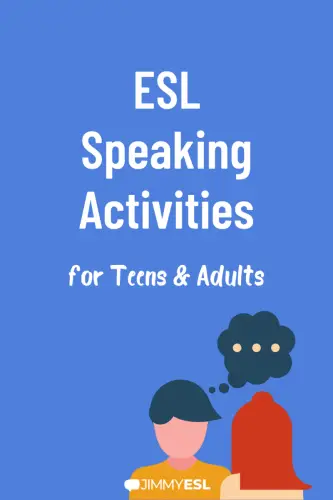
1. Interview Pop
2. word racing, 3. guess who or what i am, 4. would you rather…, 5. how-to presentation, 6. living memory, 7. video talk, 8. talk about your weekend, 9. timed discussion, 10. debating club, 11. taboo words, 12. story chain.
Student level: Pre-Intermediate to Advanced Type of Lesson: Group or Individual
This is a great one for students to have fun and be creative. Put students in pairs, or you could also carry this one out in a one-one lesson.
Students choose one person they want to interview. It can be anybody of their choice, and the person doesn’t necessarily have to be alive still.
I tell students to choose someone they know a lot about or who they admire because then they’ll have more material to talk about when the speaking part of the activity comes around.
Give each student a list of ten to fifteen verbs. (Can be the same list or different) See the example:
Each student has to choose five verbs from their list.
They make a different question using one of their five verbs in each question; these questions are made for the person they want to interview.
Each question will have a different verb.
For example, let’s say a student chooses Barack Obama. They have to make five interview questions for Barack Obama, each question using a different verb from their list.
Here are some examples:
- How did you decide you want to become president?
- Did you want to continue being president after your term finished?
- What did you love about being the president?
- What would you change about the USA?
- What do you consider to be your greatest accomplishment as president?
While I usually just come up with the verbs myself, you can also find some verb lists online, along with a list of people for your students to choose from.
While the students are making their questions, go through the class and help students fix the grammatical mistakes.
This is a great activity if you are practicing question formation as a grammar topic with your students.
The students then give their partner the questions that they wrote and then assume the role of the person they wanted to interview, while their partner asks them the questions they just made.
So this means that each student answers the questions from the perspective of the person they wanted to interview, as their partner asks them the questions.
Go around and listen for mistakes.
You could also then have students report to the class the person their partner chose and how they responded to the questions.
Student level: Pre-Intermediate to Advanced Type of Lesson: Group
A very interactive and high-energy ESL speaking activity. Many students get so into it and excited that they won’t even notice they are speaking in a foreign language and won’t even have time to think about making mistakes.
All you need to prepare for the game is to write down 15-20 vocabulary terms you want to practice with your students, each term is written on a different small slip of paper. Give a stack of these slips to each group.
You can also let the students write down the vocabulary (for example on the last topic they’ve learned) but then some words might be double and they also might not think of the words you want them to practice.
Divide your students into groups of three or four and explain the rules of the game.
One player from the first group starts. This student then has one minute to explain or define as many words written on their slips to their own group as they can, without saying the word they have on the card.
They want their group to guess as many words as possible in one minute.
Each time the members of the group guess a word, they put the card down, which gets them a point, and then they take a new card and repeat the same thing.
Once the minute is over, the next group takes their turn.
After the minute is up, each group counts their points and the group with the most points wins that round.
If you have time to play more rounds, after all, words are guessed, put them back in the basket and let them play again, although this time they can only use one word to explain the word on the card, for example, a synonym or a word they associate with the word on the card.
An example might be that if the word on the card is ‘handcuff’ then they say the word ‘police’ and the other students have to guess the word ‘handcuff’.
Students only get one guess. Once a student guesses, the student must move on to the next card, whether the word was guessed correctly or not.
In the last round, they act out or pantomime the words on their cards.
Here’s a list with even more fun ESL vocabulary games for adults and kids.
While there are many other good vocabulary-charades type games that can be done with both younger and older students, this one has been my favorite.
Student level: Pre-Intermediate to Upper-Intermediate Type of Lesson: Group
This is a very simple but effective activity with no preparation needed and can be played in two versions.
It’s usually more suitable for lower-level students but can also be used in intermediate or upper-intermediate students, especially for the other variation of the activity described below.
In version one, one student thinks of a person – it could be someone in the class or a famous person, someone that everyone is likely to know – and the rest of the class asks them yes or no questions about the person until they can guess who it is.
The student who guesses the person with the least amount of questions wins.
In version two, one student goes in front of the door, while the rest of the class decides on a person. Then the student comes back in and has to ask the class yes or no questions until they can guess who the person is.
Another variation of this game is to put students in groups and describe themselves from the perspective of an object, and the other students must guess what that object is in the quickest time possible.
Each student in the group writes down an object and then speaks from the perspective of that object as if they were actually that object.
For example, if one student chooses ‘handcuffs’ they would say something like:
- “The police put me around somebody’s wrists when they break the law.”
- “I have two round rings with chains connected them.”
- “I am on a person on their way to prison.”
Students shouldn’t do any gesturing or acting on this one because that will give it away. The student who is able to guess the most objects correctly wins.
The reason I like this one more is that the students have to get a little bit more creative about expressing their ideas and they also tend to have more fun with this one.
Student level: Intermediate to Advanced Type of Lesson: Group or Individual
This is a great way to practice ‘would’ in the conditional form.
There’s a lot of different ways you can organize this one. One of the easiest ways is to just come up with some of your own ideas (5-10 should be enough), type them out, and cut them up into cards.
Go around the class and have a student draw a card, read it aloud, and then call on another student to answer it.
The goal is to make the “Would you rather” questions funny, crazy, interesting, or controversial. Think about what kind of questions you think would be fun to discuss if you were learning a foreign language.
Bookmark our list of 110 “would you rather” questions, and you will never run out of great questions to discuss.
Here are a few examples:
- Would you rather give up your mobile phone or your pet?
- Would you rather have $50,000 that is legal or $150,000 that is illegal?
- Would you rather be the funniest person in the room or the most intelligent?
- Would you rather have your first child when you are 19 years old or when you are 45?
As stated before, you can make up your own. If you are doing a specific topic for your lesson, then you can try to make them as closely related to the topic as possible.
For example, if the topic for your lesson is Meet the World’s Oldest Ice Hockey Player , then you might want to prepare some ‘would you rather’ questions about age or about hockey:
- Would you rather stop aging at 17 or 35?
- Would you rather date someone ten years older or ten younger?
- Would you rather be a famous football player or a famous hockey player?
Give each group or pair of students the same card and have each of them state their opinion about the topic on the card.
You can give them a few minutes to take notes on their opinion and what they want to say before starting. Then students go around and say their opinion and support their argument.
This is one is sure to bring some good conversations and even laughs in your class.
You can also teach phrases on how to express opinions, such as:
- “In my opinion…”
- “I believe that…”
- “In my eyes…”
- “From my point of view…”
In addition to this, you could also assign students to make their own “Would you rather…” topics for the class or other groups. Make sure they keep them appropriate!
Help facilitate the conversations and ask follow-up questions while students are speaking.
This activity is great for a number of reasons: it’s simple to assign and explain, effective for students to develop speaking, and fun because it’s on a topic they’re interested in.
It’s also practical because they’re teaching the class how to do something or how something works.
Basically, all you need to do for ESL speaking activities like this one is have students choose some topic. It can be any appropriate topic according to their wishes.
Then they give a five-minute presentation on that How-to topic.
In order to get students cooperating together, you could also put them in pairs and have them decide on and organize the speech together.
Here are some of the ones my students have done before and they turned out to be great:
- How to cook [a food]
- How to play [a sport]
- How to travel cheap
- How to do a magic trick
- How to live healthily
There are some great tips you can share with your students on giving a presentation in a foreign language.
Have students prepare the speech at home or during the lesson, and then have them present their topic during the next lesson.
You could take notes on their speaking or pronunciation mistakes while they present and go over them after the presentation.
Student level: Pre-Intermediate Type of Lesson: Group
This is a game based on the classic board game “memory” designed for lower-level students.
Two students go out of the room (Student A and Student B). The rest of the class gets together in pairs.
If you have an uneven number of students, one group can be in three.
Each pair chooses a word according to the learning objective.
For example, if your students are learning about food, then in pairs they will mutually agree on a meal or a food they both like. Then the two students come back into the classroom and these two students play against each other to gain points.
To gain points, Student A starts off and asks any student in the class “What do you like eating?” and that student answers “I like eating…”, and then Student A asks another student what they like to eat.
If the second student likes the same thing, then Student A gets one point. Then Student B goes and tries to match the pairs based on the food they mutually chose together.
This is a fun game to practice vocabulary and simple phrases.
You can make the game more interactive if students make gestures and movement demonstrating the type of food. For example, they gesture peeling a banana if the food they chose is ‘banana’.
Other good questions are:
- What is your favorite subject?
- What do you like doing in your free time?
- What time is it?
Student level: Pre-Intermediate to Advanced Type of Lesson: Group or Individual
Find a YouTube video topic that you think would be interesting for your students. I would choose a relatively short video (two to five minutes), or something like a TedTalk.
Make some preview discussion questions about the topic presented in the video, go through them with students before watching, and then watch the video together.
You can then have some questions prepared based on the video content and some post-discussion activities while going through some of the important vocabulary terms from the video.
Students tend to love working with videos and there are so many good ones out there nowadays.
Using video is effective because it brings the outside world to your students, and they can generate some great discussions in class, inspiring students to speak their mind and share their opinions and ideas.
Browse our full archive of ESL resources and printables.
Student level: Beginner to Intermediate Type of Lesson: Group
This activity is a better choice if your students are happy talking but maybe are a bit nervous speaking in front of a class:
Split the class into pairs.
Students need to discuss their weekend with their partner.
Use only English!
You need to be observant with this type of activity. Keep an eye on each student’s talk time.
If you are finding some students are much more talkative than their partners, maybe set a time limit for how long each student can talk for before switching. This ensures that everyone gets a fair chance to practise.
Information gap activities are great to practice conversation; get more ideas here.
This is another simple yet great activity for building confidence in speaking!
Give the student a topic card, for instance, “Talk about your favorite place.” or “What’s your favorite band or artist?”
The student has a certain amount of time to prepare some ideas for what they will say.
The student then has to talk about that topic for a chosen amount of time.
When starting out with this activity, make sure to give more time for preparation and less time for the presentation. 5 minutes of preparation time and 1 minute of the presentation should be plenty.
With time, you can reduce the preparation time or increase the presentation time.
Prepare a list of controversial topics, and two opposing views about each topic.
Split your students into pairs or small groups (each with an even number of students). Split each groups into two parties. Assign a topic to each group: each party has to hold an opposite view.
Give them some time to prepare arguments for their standpoint. 5 to 10 Minutes should be enough.
Then let each group debate their topic in front of the class. One party starts voicing their first argument, then the other answers.
Each statement shouldn’t exceed 30 seconds – use a stopwatch with a countdown, so students know when they have to stop.
The debate is over after a set time – for example 5 minutes – or when the parties stated all their arguments.
After each debate, the whole class votes which party was more convincing and won the debate.
If it’s an individual lesson, you and the student play the opposite parties – no final vote then.
Make sure to prepare topics according to the fluency level of your students. The topics can be rather serious and controversial, or fun and weird.
Here are a couple of examples:
Current and serious topics:
- Classroom instruction vs. Homeschooling
- Self-driving cars: smart or dangerous
- Buy local vs. buy online
- Death sentence: yes or no
- iOS vs. Android
Fun and weird topics:
- Vanilla vs. chocolate ice-cream
- Get up early vs. go to bed late
- Have no kids vs. have 5 kids
- Travel to Mars vs. to the earth’s core
- Sommer vs. Winter
Student level: Beginner to Intermediate Type of Lesson: Group
Finally, and absolute classic activity. Split your students into groups, each with at least 3 three students.
Prepare a list of words. For each word, think about 3-5 words which can be used to describe the original word. These can be synonyms, adjectives or any kind of related terms.
- Weather – rain, cloud, sun, forecast, outside
- hungry – food, stomach, eat, restaurant, thirsty
- to run – fast, quick, walk, race, legs
Write the words on cards.
Now, one student has to take one card and explain the word to the other in their group. Here’s the catch: He must not use one of the words on the card (also, no parts or variations of the words.). He must not use gestures, facial expressions or voices. He has to circumscribe the word using other verbal expressions.
The rest of the group have to guess the word. Set a time for each round, like one minute. One group has to guess as many words as possible within that time; each guess is one point.
When the explaining student uses one of the taboo words (or other taboo means), he has to skip the current word and continue with the next card.
Count the points after each round. Then, the next group has its turn. The game is over, when each student in each group had their turn to explain words. Sum up the points; the group with the most wins.
Other possible game modes: Let the groups guess one word alternating, and set a 30 seconds time limit for each guess. Or let a student explain a word to the whole class, and who guesses it first, gets a point.
Student level: Intermediate to Advanced Type of Lesson: Group
This activity does not only help students develop their speaking and listening skills, it also fosters critical thinking skills, creativity, and imagination.
Here’s how it works:
- Divide the group into small teams of 3–4 people each.
- Give each team a starting sentence, such as “Once upon a time, in a land far, far away.”
- Set a time limit, such as 5 minutes.
- Each team must take turns adding one sentence to the story, building from the previous sentence.
- The team that completes the most coherent story within the time limit wins.
- To make it more challenging, you can also include a specific vocabulary theme for the story, such as “animals” or “travel”, or you can include a twist, such as “the story must be a horror story”.
- After the activity, teams present their story to the class.
- Encourage the class to ask questions about the story to the teams.
6 thoughts on “12 Fun ESL Speaking Activities for Teens or Adults”
Thank you so much! Some of the suggestions I have already used with my students, but I did get new tips too! will try them out.
Great ideas to get my hgh school students speaking. Thanks so much
Great… These activities are really interesting ones and are helping me a lot. Thank You So Much for Uploading….
Great activities! Greeting from Mexico.
Thank you! This is very clearly written with a lot of additional ideas. Useful! :)
Thanks so much for sharing. Lots of new ideas for me.
Leave a Comment Cancel Reply
Your email address will not be published. Required fields are marked *
- Grades 6-12
- School Leaders
FREE Scientific Method Posters 😍🧪
10 Creative Writing Activities That Help Students Tell Their Stories
Lower the stakes and help them get started.

“I don’t have a story. There’s nothing interesting about my life!” Sound familiar? I don’t know a teacher who hasn’t heard students say this. When we ask our students to write about themselves, they get stuck. We know how important it is for them to tell their own stories. It’s how we explore our identities and keep our histories and cultures alive. It can even be dangerous when we don’t tell our stories (check out this Ted Talk given by novelist Chimamanda Ngozi Adichie and share it with your students for more on that). Storytelling is essential for every subject, not just English Language Arts; students dive deeper and engage when they practice thinking about how their own stories intersect with historical events, civic engagement, and the real-world implications of STEM. These 10 creative writing activities can work in every subject you teach:
Here are 10 of our favorite story telling activities that inspire students:
1. write an “i am from” poem.

Students read the poem “I am From” by George Ella Lyon. Then, they draft a poem about their own identity in the same format Lyon used. Finally, students create a video to publish their poems. We love this one because the mentor text gives a clear structure and example that students can follow. But the end result is truly unique, just like their story.
2. Design a social media post to share an important memory

How can you use your unique perspective to tell a story? We want our students to learn that they are truly unique and have stories that only they can tell that other people want to hear or could relate to or learn from. In this activity, students watch two Pixar-in-a-Box videos on Khan Academy to learn about storytelling and perspective. Then, they identify an interesting or poignant memory and design a social media post.
3. Create an image using a line to chart an emotional journey
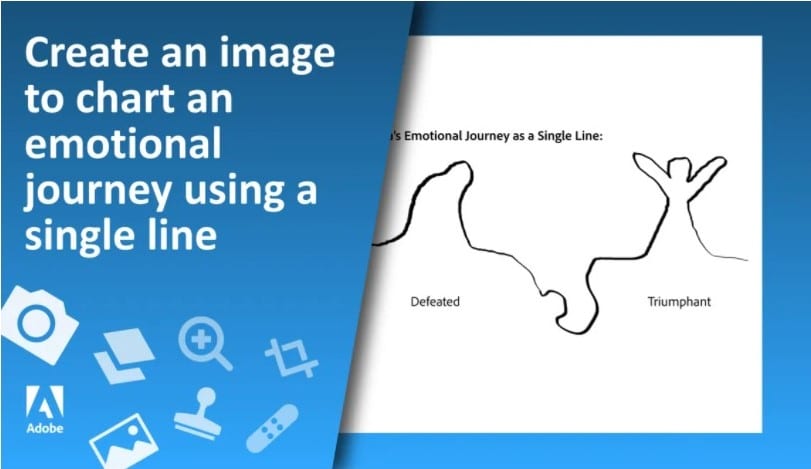
How do you show emotion using a single line? In this activity, students watch a Pixar in a Box video on Khan Academy to learn about how lines communicate character, emotion, and tension. Then they experiment with these aspects as they write their story. We love using this for pre-writing and to help students explore their story arc. Also, for students who love to draw or learn visually, this can help them get started telling their story and show them that there are many different ways to tell a story.
4. Tell the story behind your name

Sharing the story behind our name is a way to tell a story about ourselves, our culture, and our family history. And if there isn’t a story behind it, we can talk about how we feel about it and describe what it sounds like. In this activity, students use video to introduce themselves to their classmates by discussing the origin of their name. This project asks students to connect their names (and identities) to their personal and familial histories and to larger historical forces. If you’re looking for a mentor text that pairs well with this one, try “My Name” by Sandra Cisneros .
5. Develop a visual character sketch
Give students the time to create a character sketch of themselves. This will help them see how they fit into their story. In this lesson, students create a visual character sketch. They’ll treat themselves like a character and learn to see themselves objectively.
6. Create a webpage to outline the story of your movie

Building a story spine is a great way to show students how to put the parts of their story in an order that makes sense. It’s an exercise in making choices about structure. We like this activity because it gives students a chance to see different examples of structure in storytelling. Then, they consider the question: how can you use structure to set your story up for success? Finally, they design and illustrate an outline for their story.
7. Respond to a variety of writing prompts
Sometimes our students get stuck because they aren’t inspired or need a different entry point into telling their story. Give them a lot of writing prompts that they can choose from. Pass out paper and pencils. Set a timer for fifteen minutes. Then, write 3-4 writing prompts on the board. Encourage students to free-write and not worry about whether their ideas are good or right. Some of our favorite prompts to encourage students to tell their story are:
- I don’t know why I remember…
- What’s your favorite place and why?
- What objects tell the story of your life?
- What might surprise someone to learn about you?
8. Create a self-portrait exploring identity and self-expression
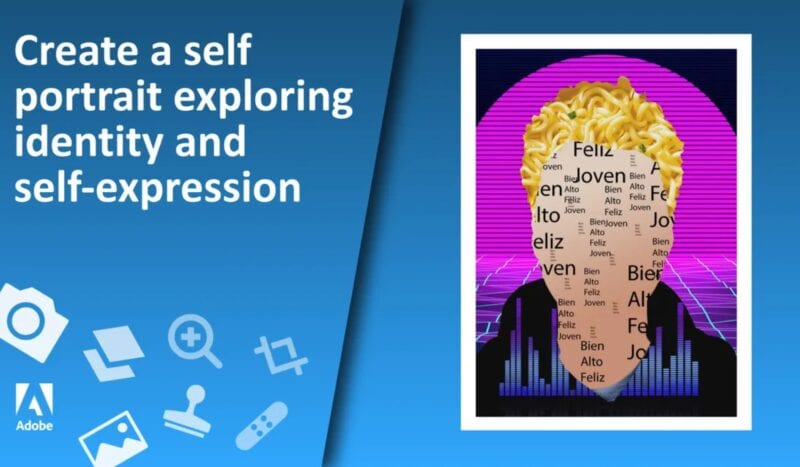
Part of what makes writing your own story so difficult for students is that they are just building their identity. In this activity, students explore how they and others define their identity. What role does identity play in determining how they are perceived and treated by others? What remains hidden and what is shown publicly?
9. Film a video to share an important story from your life

Encourage students to think about how to tell the story of a day they faced their fears. Students consider the question: How can you use different shot types to tell your story? They watch a video from Pixar in a Box on Khan Academy to learn about different camera shots and their use in storytelling. Then, they use Adobe Spark Post or Photoshop and choose three moments from their story to make into shots. We love using this to help students think about pace and perspective. Sometimes what we leave out of our story is just as important as what we include.
10. Try wild writing
Laurie Powers created a process where you read a poem and then select two lines from it. Students start their own writing with one of those lines. Anytime that they get stuck, they repeat their jump-off line again. This is a standalone activity or a daily writing warm-up, and it works with any poem. We love how it lowers the stakes. Can’t think of anything to write? Repeat the jump-off line and start again. Here are some of our favorite jump-off lines:
- The truth is…
- Some people say…
- Here’s what I forgot to tell you…
- Some questions have no answers…
- Here’s what I’m afraid to write about…
You Might Also Like
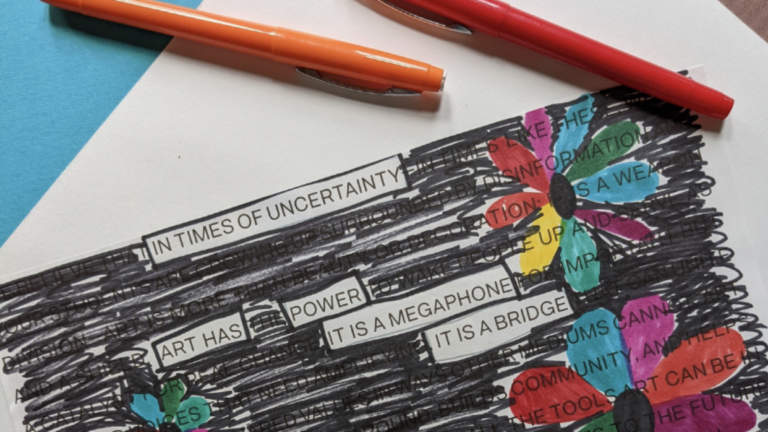
What Is Blackout Poetry? (Plus Examples and Ideas)
Blackout Poetry for the (easy) ELA win! Continue Reading
Copyright © 2023. All rights reserved. 5335 Gate Parkway, Jacksonville, FL 32256

Creative Writing Unit for High School Students
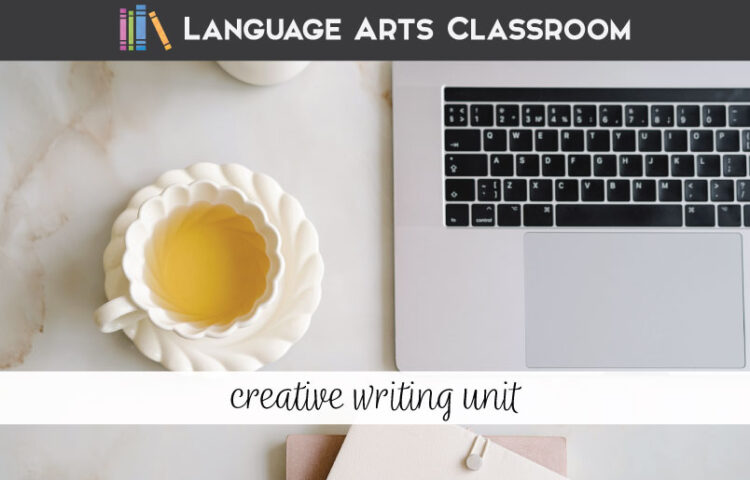
My creative writing unit for high school students allows for adaptations and for fun! With plenty of creative writing activities, you’ll have flexibility.
If you are looking for a creative writing unit, I have ideas for you. When I taught middle school, I sprinkled such activities throughout the school year. As a high school teacher, though, I taught an entire creative writing course. With no textbook and very little established activities, I largely worked from a blank slate.
Which. . . turned out well. I love teaching creative writing!
ELA Specific Classes
Older students often can choose electives for their ELA classes, and Creative Writing is a popular class. I’ve condensed my ideas into one post, so I organized the ideas by creative nonfiction and fiction writing and added pictures to organize this information for you.
EDIT: This post about my creative writing unit for high school writers has exploded and is about three times as long as a normal blog post. If you’d like to skip around to get inspiration for teaching creative writing, you can use the pictures and headings as guidance.
ANOTHER NOTE: I attempted to outline the days I spend on each topic, but several factors went into my estimates. First, each class differs in what they enjoy and what they dislike. If a class dislikes a specific topic, we will wrap it up and move on. If a class has fun with an assignment or needs more time to work, the days might vary.
What are the key elements of a creative writing unit?
Key elements of a creative writing unit include introducing different writing genres, teaching basic writing techniques, encouraging imagination and creativity, providing writing prompts and exercises, offering constructive feedback and revision opportunities, and fostering a supportive writing community.
How can we organize such activities?
Starting with creative nonfiction has worked for my classes, small pieces like paragraphs. I believe the success is because young writers can write what they know about. Then we can switch to fiction for the second quarter. Again, the days spent on each assignment varies, and I honestly do not stress about creative nonfiction being nine weeks and fiction being nine weeks.
All of the material listed below is in my newly updated Creative Writing Bundle . The pieces are sold separately, but that creative writing unit includes bonus material and a discount.
Ok, settle in! Here are my ideas about teaching creative writing with high school students.

First Week of School for a Creative Writing Unit
The first day of school , we complete activities that build awareness into the classroom environment about “creativity.” Do not shy away from setting a foundation of support and understanding as you engage with young writers. During my first creative writing classes, I neglected to spend time establishing expectations and community. The following semester, the time invested early paid off with engaged students later.
Those first days, we also discuss:
- Published vs. private writing. I tell writers they may share whatever they like with me and the class. As a community of writers, we will share with each other. Most of our writing will be public, but some will be private.
- A community of writers. Writing and sharing ideas requires maturity and acceptance. Not everyone will agree is largely my motto (about negotiables, not human rights), and I stress with students that they may read and provide feedback with topics in which they do not agree.
- Routines. Writers write. That sentence might sound silly, but some people believe that humans are born with a skill to write or they are not. Writing well takes practice. The practice can be short and unconnected to a larger product. I typically begin each week with a quick writing prompt , and we share our responses, which of course, builds that community of writers.
Whatever you are teaching—a creative writing unit or a creative writing class—spend some time establishing your expectations and goals with your students. Laying a foundation is never a waste of time! In fact, I believe so much in the power of the first week of a creative writing class that I have a blog post devoted to the concept.
Time: 2-3 days
First weeks: creative nonfiction
Creative nonfiction seems to be the genre of our time. Memoirs, essays, and hermit-crab essays flood bookstores and journals.
When students read captions on social media, profiles of their favorite artists, or long Threads, they are reading creative nonfiction. Not only should students be able to dissect this form of writing, but they should also be able to write in our society’s preferred genre.
Below, I’ve outlined creative nonfiction activities that work with teenagers.

Nonfiction Narrative Writing
Writing narratives (and meeting those standards) are trickier with older students. As a teacher, I struggle: Students will often tell me deep, meaningful, and personal parts of their lives, and I am supposed to grade those writings!
When students write a narrative , I address this situation immediately. Share with writers that their narrative ideas are strong (I believe that to be the truth!), and that in no way are we grading their ideas. Rather, we want their excellent narratives to be communicated in the best light; therefore, we will provide guidance about the structures of narrative writing.
The topic for a nonfiction narrative varies. Often, students write about themselves as learners or as community members. Framing students in a positive way allows them to explore their strengths in life and to build confidence as writers.
Time: 7-9 days

Object Essay
An object essay might sound like a “blah” type of assignment, but the simplicity allows students to push past their normal experiences. An object essay is simple, so they can experiment with their writing.
What object? I have assigned this essay several ways. For instance, I have brought in a very plain object (like a rock) and had students explain it. I like this approach because students can work together to discover the best descriptions.
Another way, my preferred way, is to allow students to choose the object. Students write about a coffee cup, water bottle, car keys, or bus pass. When students choose, the essays are richer with meaning.
Neither approach disappoints me, though! With a plain object, students must stretch themselves to be creative. Judge what your class needs and get students writing!
Time: 3-4 days

How-to Paper
No, not a “how to make a peanut butter and jelly sandwich” paper. A fun and meaningful how-to paper can encourage classes as they see themselves as experts.
What I like about a how-to paper is students get to be the expert in their paper. Finding a used vehicle to buy? Shopping for a formal event? Saving money? Cleaning a closet? Selling at consignment stores? Each writer has an area in which they shine, and a how-to paper allows them to share their knowledge with others. They write about “behind the scenes” or little known secrets.
Of all the creative writing activities, I assign the how-to paper early. It builds confidence in young writers.
Time: 5 days

Sell this Apple
Why an apple? When I wanted students to creatively sell something, I searched for something they could all have in common but sell in different ways. I wanted classes to have one object but to witness the multiple approaches for advertising. Apples (which I could also afford to bring to class) fit nicely.
What do students sell when they “sell an apple”?
- Dips for apples.
- Apples for preschool snacks.
- Charcuterie apple boards.
- Apple crisp.
- Red and green apple rainbows.
Basically, students can create a marketing plan for multiple age groups and other demographics. For instance, they can write a blog post about safety in cutting pieces for young children (and complete some research in the process). They can then “promote” a local apple orchard or fruit stand.
Another advertisement is an apple pie recipe for a Thanksgiving brochure for a supermarket.
When I gave students something simple, like an apple, they ran with the idea. Then, we can share our ideas for selling apples.

A profile is difficult to write, so this assignment is normally my last assignment of the quarter. Before we switch to writing fiction, we apply all our concepts learned to writing a profile.
Profiles are more than summaries of the person. Writers must take an angle and articulate the person’s traits utilizing Showing vs. Telling. Of all creative writing assignments, the profile, might be the most difficult. I place it in the middle of the semester so that writers understand our goals in class but are not tired from the end of the semester.
Time: 10-12 days
Final weeks: fiction
Fantasy, historical fiction, mystery, romance: Students consume a variety of fiction via books, movies, and shows. Fictional creative writing activities invite young writers into worlds they already consume.
Below, I’ve outlined some that work with teenagers.

Alternative Point-of-View
Grab some googly eyes or some construction paper and send students loose. (A few guidelines help. Should students remove the googly eyes from the principal’s office door?) Have them adhere the eyes to an inanimate object to make a “being” who learns a lesson. They should snap a picture and write a quick story about the learned lesson.
What type of lesson? Perhaps an apple with a bruise learns that it still has value and is loved with blemishes. Maybe a fire extinguisher realizes that its purpose is important even if it isn’t fancy.
Honestly, the creativity with the googly eyes adhered to inanimate objects is so simple, but it always is my favorite event of the semester. I officially call it the “ alternative point-of-view ” activity, but “googly eyes” is how my writers remember it.
Time: 2 days

Create a Superhero with a Template
A superhero does not need to wear a cape or fancy shoes. Rather, in this creative writing activity, students build a superhero from a normal individual. When I created the activity, I envisioned students writing about a librarian or volunteer, but students often write about a grandparent (adorable).
Since students enjoy graphic novels, I wanted students to experience making a graphic novel. The colorful sheets allow students to add their ideas and words to pages that fit their messages.
After students create a comic book, they will also write a brief marketing campaign for a target audience. Learning about who would buy their graphic novel typically leads them to parents and librarians which should lead students to discover the importance of reading. The advertising campaign additionally serves as a reflective component for the initial activity.

Product Review
Product reviews and question/answer sections are a genre all their own. SO! Have students write reviews and questions/answers for goofy products . Students will find a product and write several reviews and questions/answers.
This quick activity lends itself to extension activities. Once, a teacher emailed me and said her school bought some of the goofy products for a sort of “sharing” day with the school. Since students have access to pictures of the item, you can make a “catalog” for the class out of a Canva presentation and share it with them and your colleagues.
Here are a few examples:
- Banana slicer .
- Horse head .
- Wolf shirt.
Aside from the alternative point-of-view activity, the product reviews remain my personal favorite part of a creative writing unit. Writers find random products and write goofy workups that they share with the class.
Time: 3 days

Character Creation
Creating a well-rounded and interesting character requires prep work. The brainstorming part of the writing process, the pre-writing? We spend lots of time in that area as we create fleshed out characters.
I like to start with a multiple-choice activity. We begin my imagining the main character. Next, students take a “quiz” as the character. How does the character eat? What sort of movies does the character enjoy? hate? After the multiple-choice activity, they can derive what those pieces explain about their characters. Finally, they can begin to brainstorm how those pieces will develop in their story.

Flash Fiction
Flash fiction is a simple, short story. Writers might cheer when they hear I expect a 300-word story, but often, they discover it is a challenging assignment from class. A large part of a creative writing unit is giving students a variety of lengths so they can practice their skills under different circumstances.

Historical Fiction
Historical fiction is a popular genre, and classes are familiar with many popular historical fiction books. I find it helpful to have several books displayed to inspire students. Additionally, I read from the books to demonstrate dialogue, pacing, theme, and more.
Since my historical fiction activity takes at least two weeks to accomplish, we work on that tough standard for narrative writing. To that end, these activities target the hardest components:
- Pacing within a narrative.
- Developing a theme .
- Building imagery .
- Creating external conflicts in a story.
- Establishing a setting .
First, I used pictures to inspire students, to get them brainstorming. Second, I created those activities to solve a problem that all writers (no matter the age!) have: Telling vs. Showing. I found that my writers would add dialogue that was heavy on explanation, too “world building” for their narrative. The story sounded forced, so I took a step back with them and introduced mini-activities for practicing those skills.
Third, the above creative writing activities can EASILY be assignments independently for short and fun assignments. I teach them with historical fiction because that activity is at the end of the semester when my expectations are higher, and because students enjoy writing historical fiction so they are invested.
But! You can easily add them to another narrative activity.
Time: 10-12 days

A clean tabloid! Tabloids are largely replaced by online social sharing creators, so they are fun to review with students. Students might not be familiar with tabloids at the grocery store checkout, but they are familiar with catchy headlines. They will be completely ready to write a tabloid !
To ensure a clean tabloid, I ask students to write about a children’s show, something scandalous happening from a cartoon. The results are hysterical.
Time: 4 days

Children’s Book
I have two introductory activities for the children’s book. One, students answer questions about a mentor text (another children’s book). Two, students evaluate the language of a specific book to start them in their brainstorming.
My students write their children’s book as a final activity in class as it requires all the elements of creative writing. When a school requires me to give a final exam, students write a reflection piece on their children’s books. If you are looking for a finale for your creative writing unit, a children’s book is a satisfying ending as students have a memorable piece.
Time 10-12 weeks
Final note on creative writing activities and bundle
I intended for this post to inspire you and give you ideas for teaching either a creative writing unit or a creative writing class in ELA. My first time through teaching creative writing, I worried that my lessons would flop and that students would not find their groove with me. I found success, but with modifications, I formed a cohesive semester.
The first time through, I did not frontload information and expectations. (Spending time at the start of class is my biggest message! Please establish groundwork with students!) I also did not provide concrete enough guidelines so students understood the differences between the assignments. After a few semesters, I developed my creative writing unit . With a variety of activities and an appropriate amount of structure, I found success, and I hope you do too.
Subscribe to our mailing list to receive updates about new blog posts, freebies, and teaching resources!
Marketing Permissions We will send you emails, but we will never sell your address.
You can change your mind at any time by clicking the unsubscribe link in the footer of any email you receive from us, or by contacting us at [email protected] . We will treat your information with respect. For more information about our privacy practices please visit our website. By clicking below, you agree that we may process your information in accordance with these terms.
We use Mailchimp as our marketing platform. By clicking below to subscribe, you acknowledge that your information will be transferred to Mailchimp for processing. Learn more about Mailchimp’s privacy practices here.
*This post contains affiliate links. You can read my complete disclosures .
creative writing creative writing activities
Samantha in Secondary
7 Independent Reading Assessments for High School English
November 6, 2020 by Samantha H.
As a high school English teacher, a robust independent reading program has always been a staple of my classroom and coming up with unique independent reading assessments to make sure students have actually read was always a difficult task. Allowing students to have a say in their reading is an incredibly motivating tool. Students are much more likely to be engaged in class if they are interested in the text. This leaves teachers with a problem. If we are letting students choose their own novels, how do we know they actually read ? Here are some ideas for assessing choice reading for your secondary students!
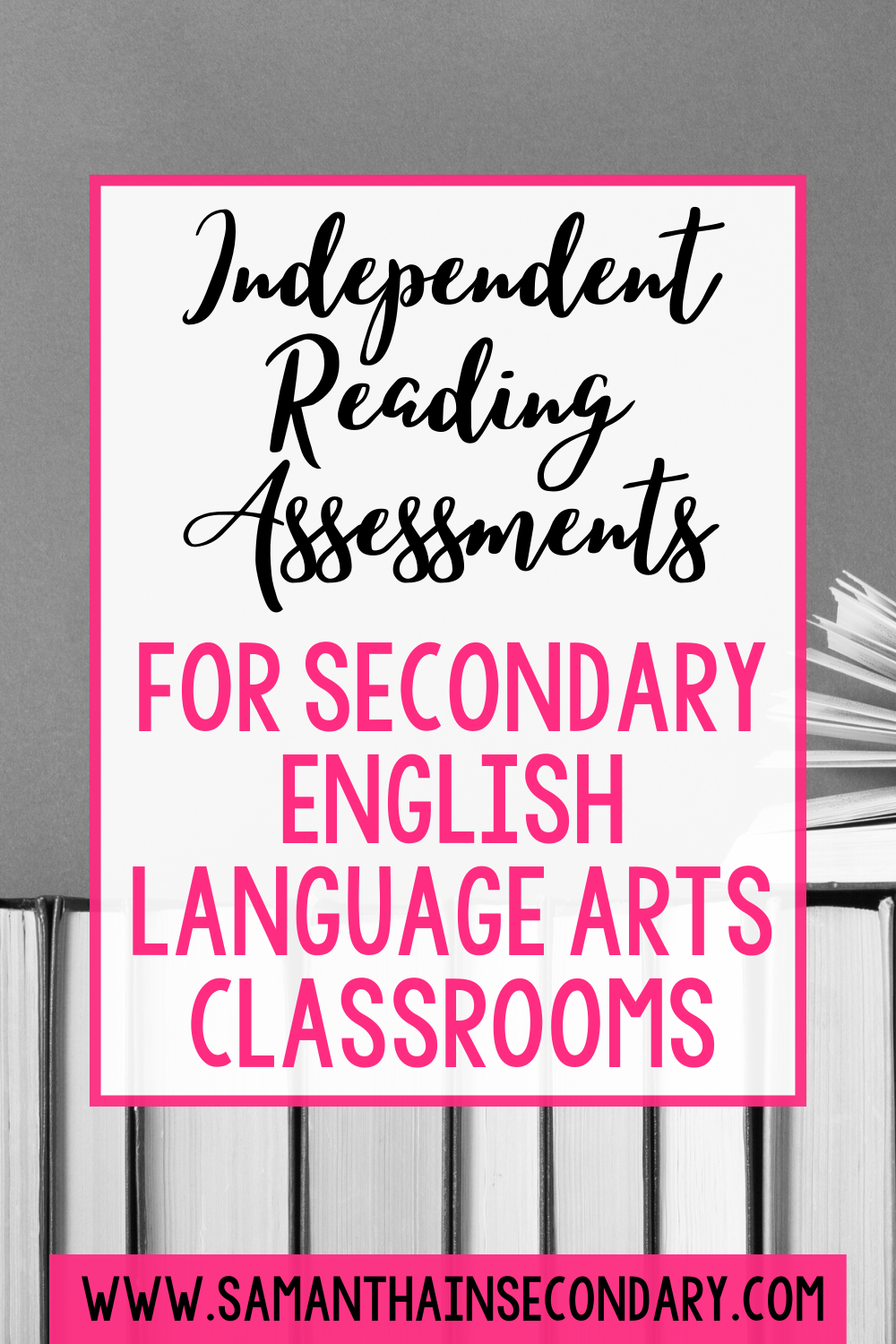
#1: One Pagers
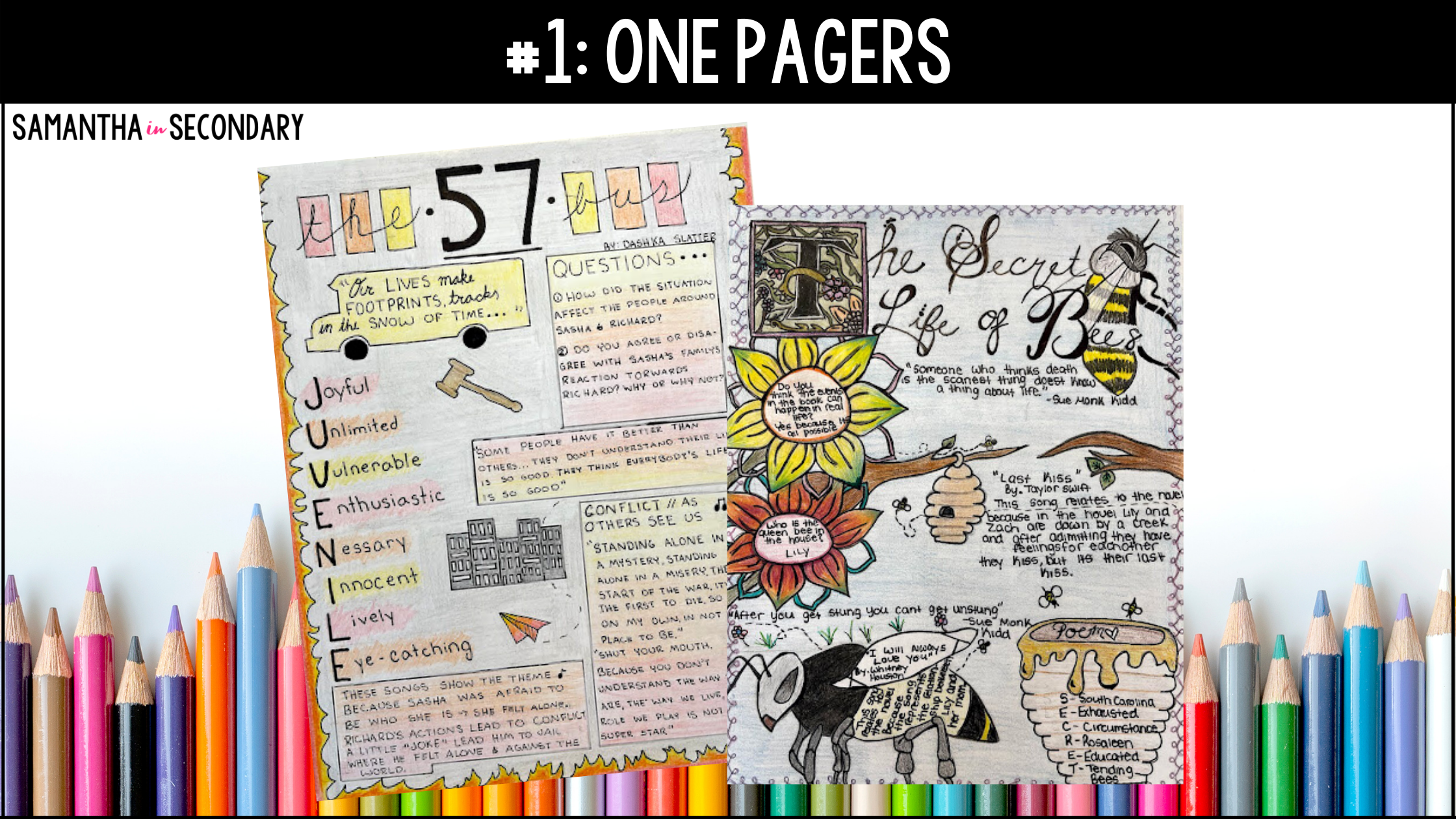
One Pagers are a popular form of independent reading assessment because they allow students to be creative and no two are alike. This makes it very hard for students to fabricate their knowledge because most of the included activities require students to analyze what they have read. This can include choosing theme songs for characters, illustrating a scene from the novel, or picking quotes that show the theme. The sky is the limit when coming up with the activities for your students to complete to fill their page.
One Pagers can easily be adapted for distance, 1:1, or hybrid learning if that is how you are teaching as well.
For more information about One Pagers, click here to see an in-depth blog post on the topic.
For a ready-made template with instructions, examples, and rubrics ready to go, click here to see my resource.
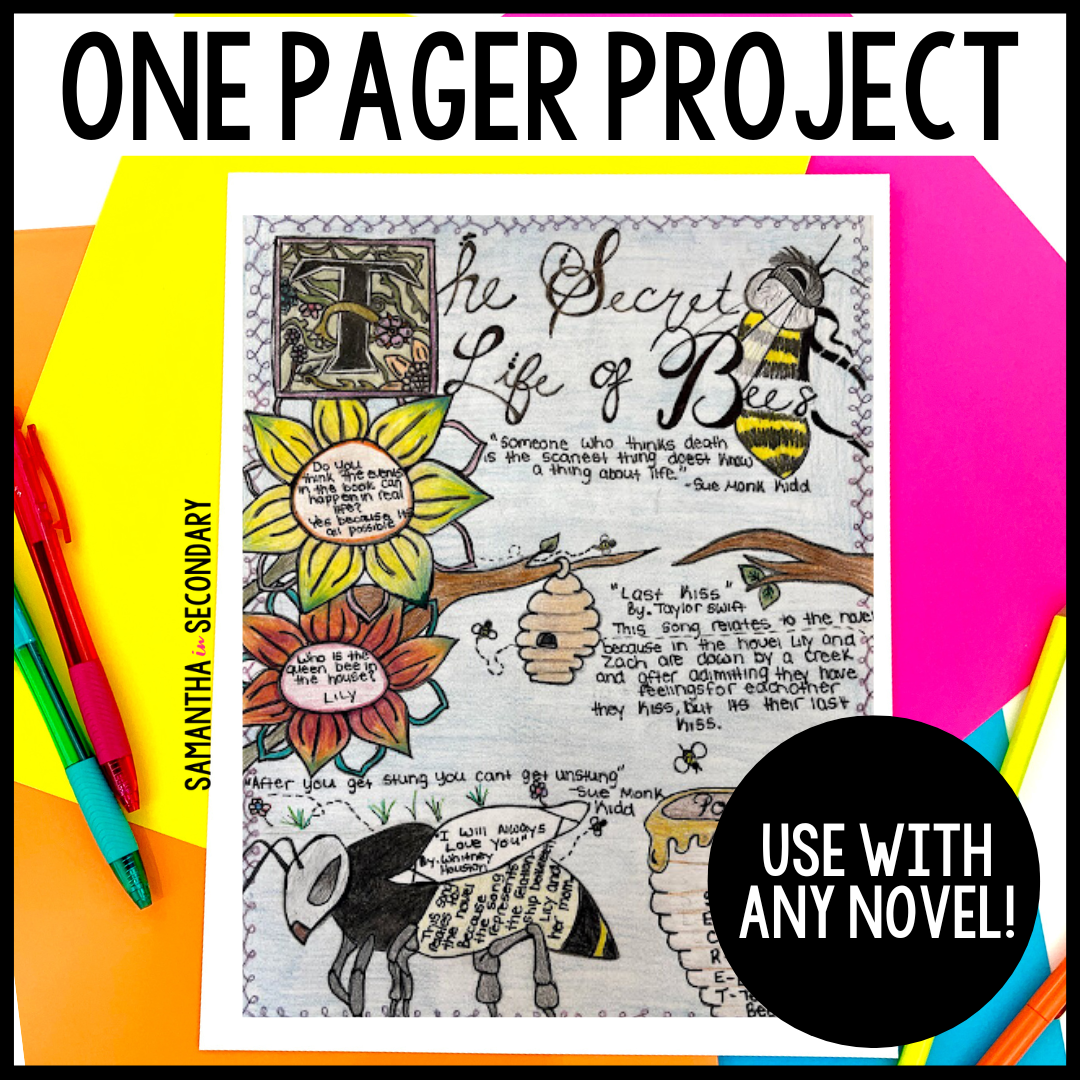
#2: Response to Literature Activities
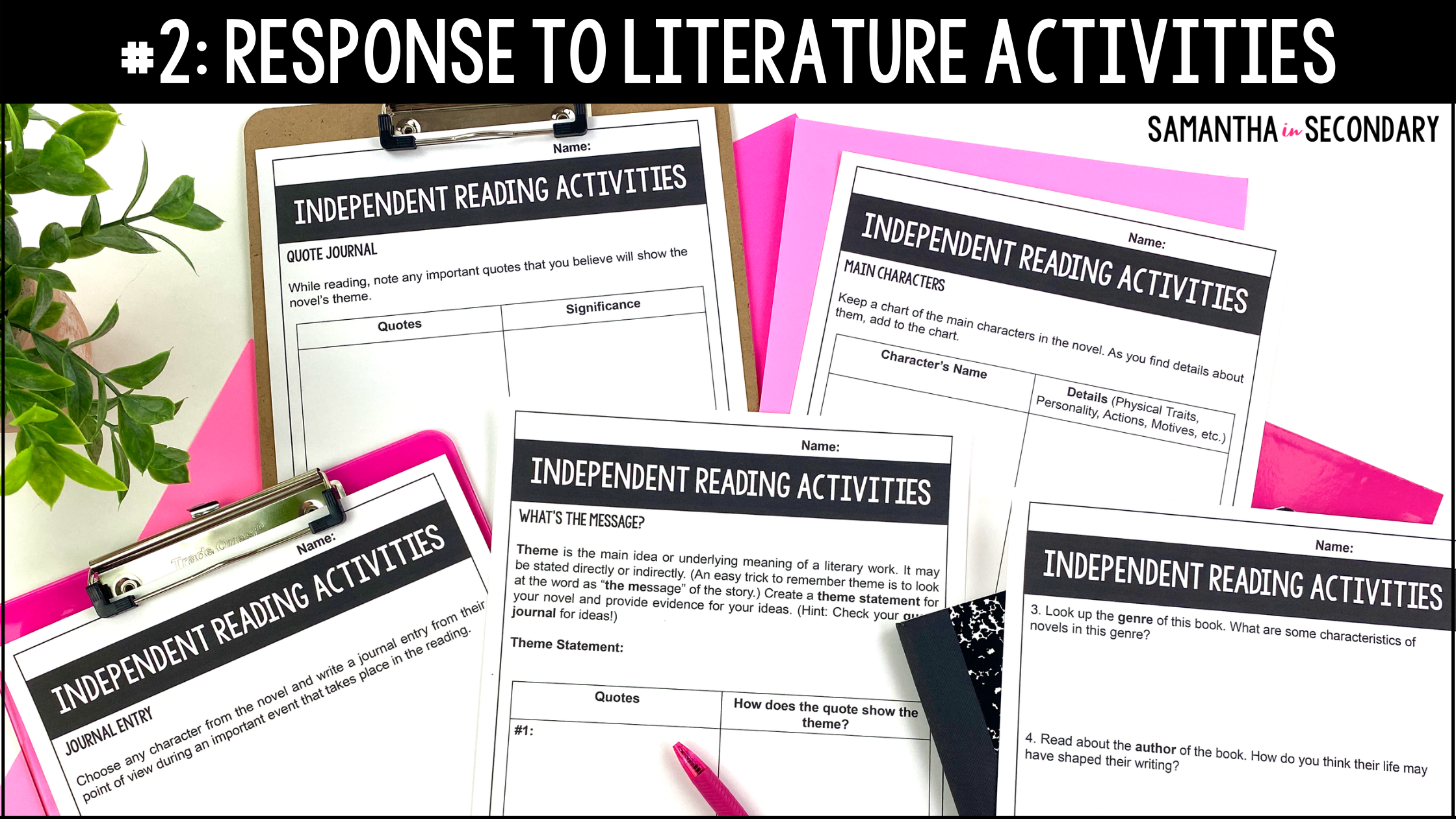
Response to Literature activities make powerful independent reading assessments because they have students engaging with the text before, during, and after reading. The possibilities are endless as far as coming up with ideas that can work for any novel. Here are just a few:
- Before Reading : Set context, activate prior knowledge, make predictions, develop questions, study the time period, investigate the author, etc.
- During Reading : These activities can include anything from doodle notetaking , close reading , and more. AdLit has an impressive list of ideas on their website as well.
- After Reading : Use this blog post for 7 great ideas!
I created a resource for my own students and decided it was worth listing in my shop and sharing with all of you. Independent Reading Activities for Any Novel includes a variety of activities that allow students to demonstrate their learning. The activities are split into the three categories: before, during, and after reading. There are ten activities total and they’re completely done which means NO prep for you.
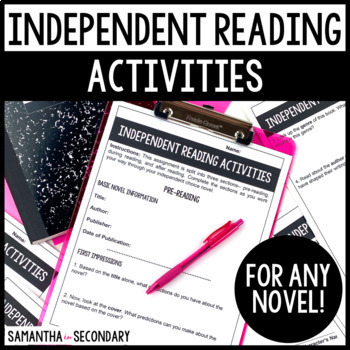
#3: Book Flat Lays
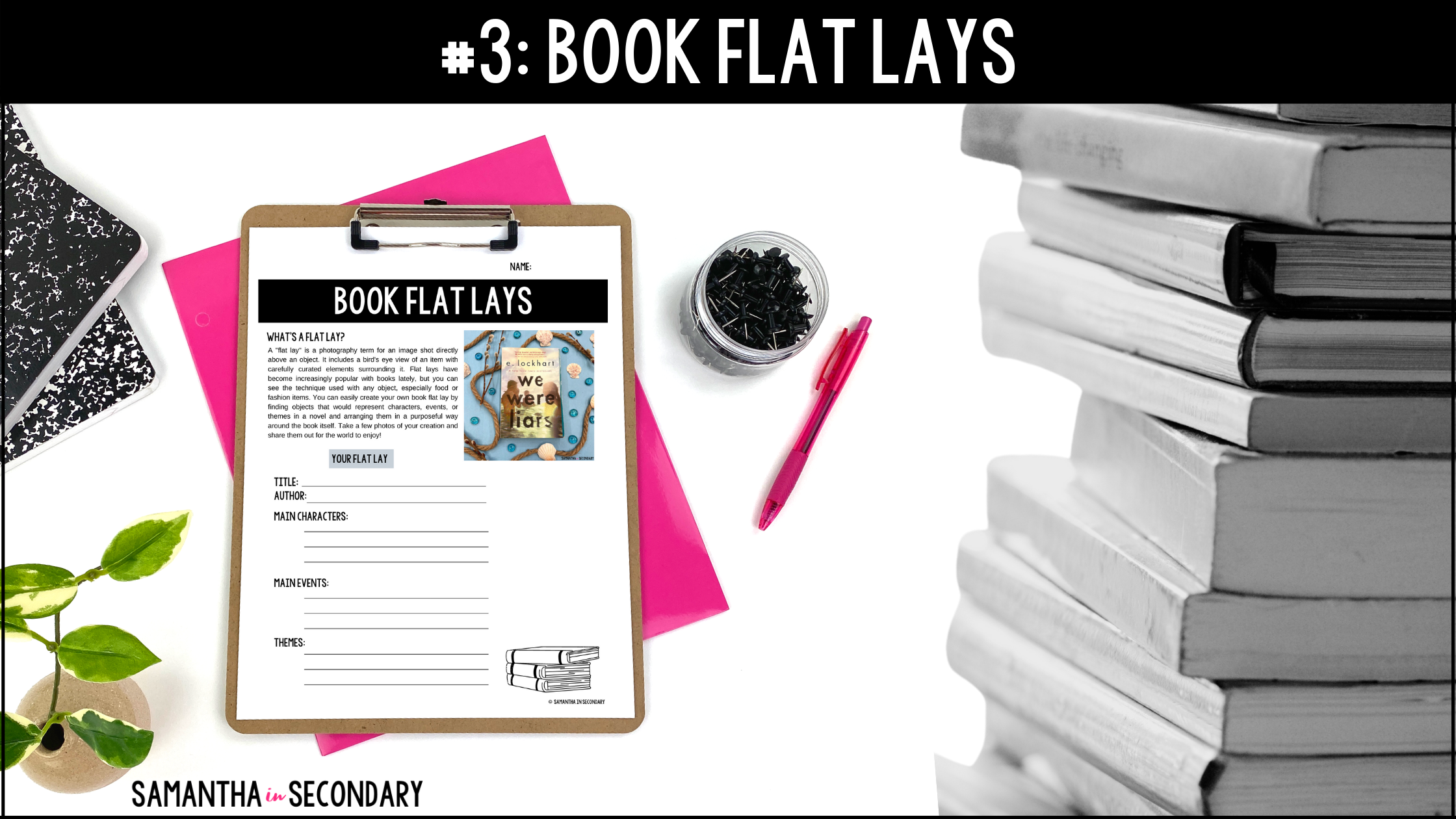
One of my more recent favorite independent reading assessments has been Book Flat Lays. You’ve probably seen these on social media and I thought they were so clever that I decided to bring them into my classroom. This type of reading project requires students to think critically about elements in the novel and stage a photo of the book with props that show different aspects of the book. Again, this is another project that is very hard to fake, so if a student didn’t read, it’s almost always very clear.
For a full blog post on Book Flat Lays, click here to read through my entire process. This project is always a crowd pleaser and one that students talk about long after the cameras are put away.
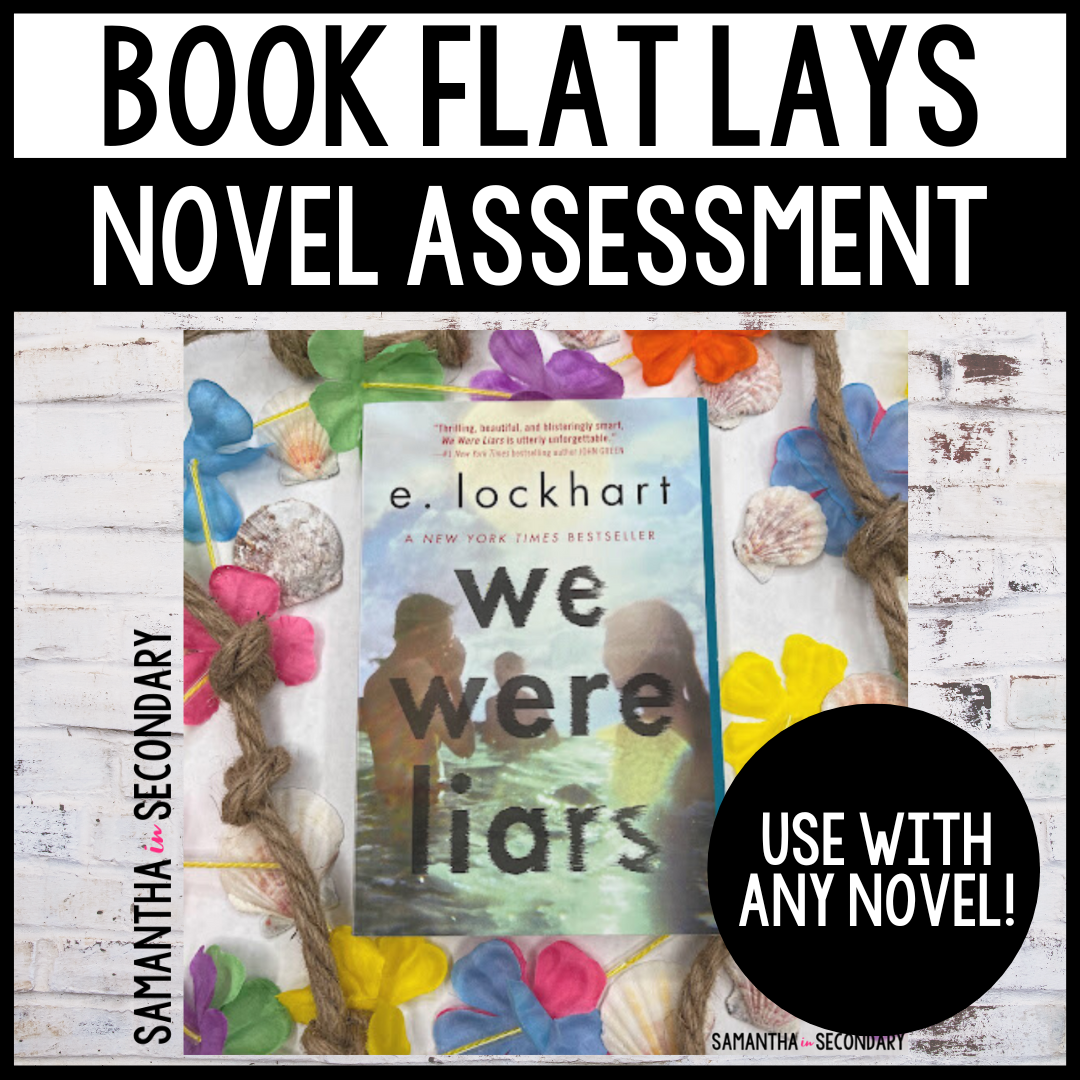
#4: Literary Field Trips
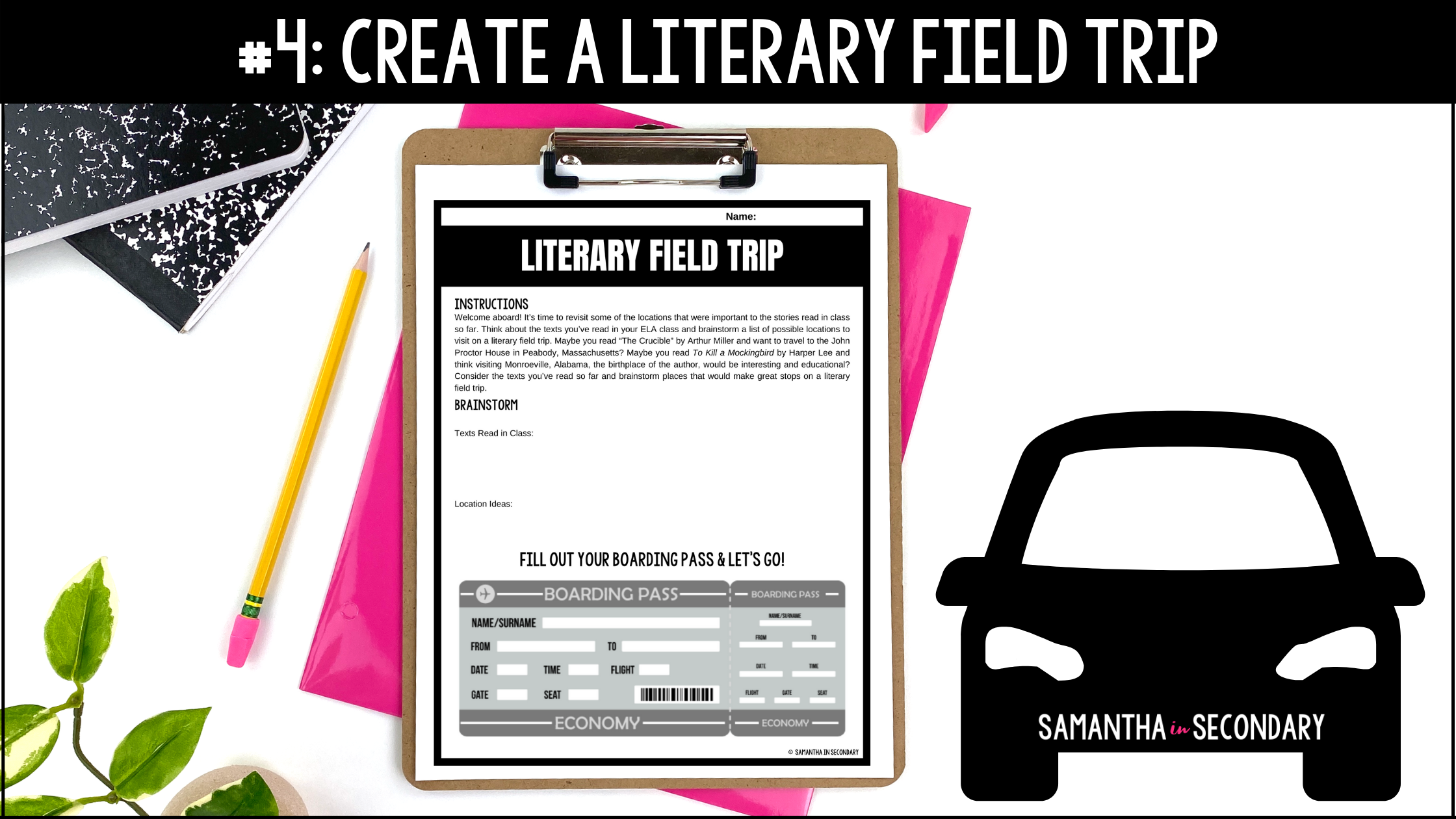
One of my favorite ideas for independent reading assessments is to have your students create a literary field trip. This works especially well if your students are reading historical fiction or books that are based on a real place. (It even works for nonfiction as well!)
The gist of the project is that students research various places from a text. So, if students were reading Born a Crime by Trevor Noah , they could make a list of locations in South Africa to research and create their field trip on. It’s a really clever way to incorporate multiple skills into one project.
To check out my pre-made version with everything you need to introduce this project today, click here .
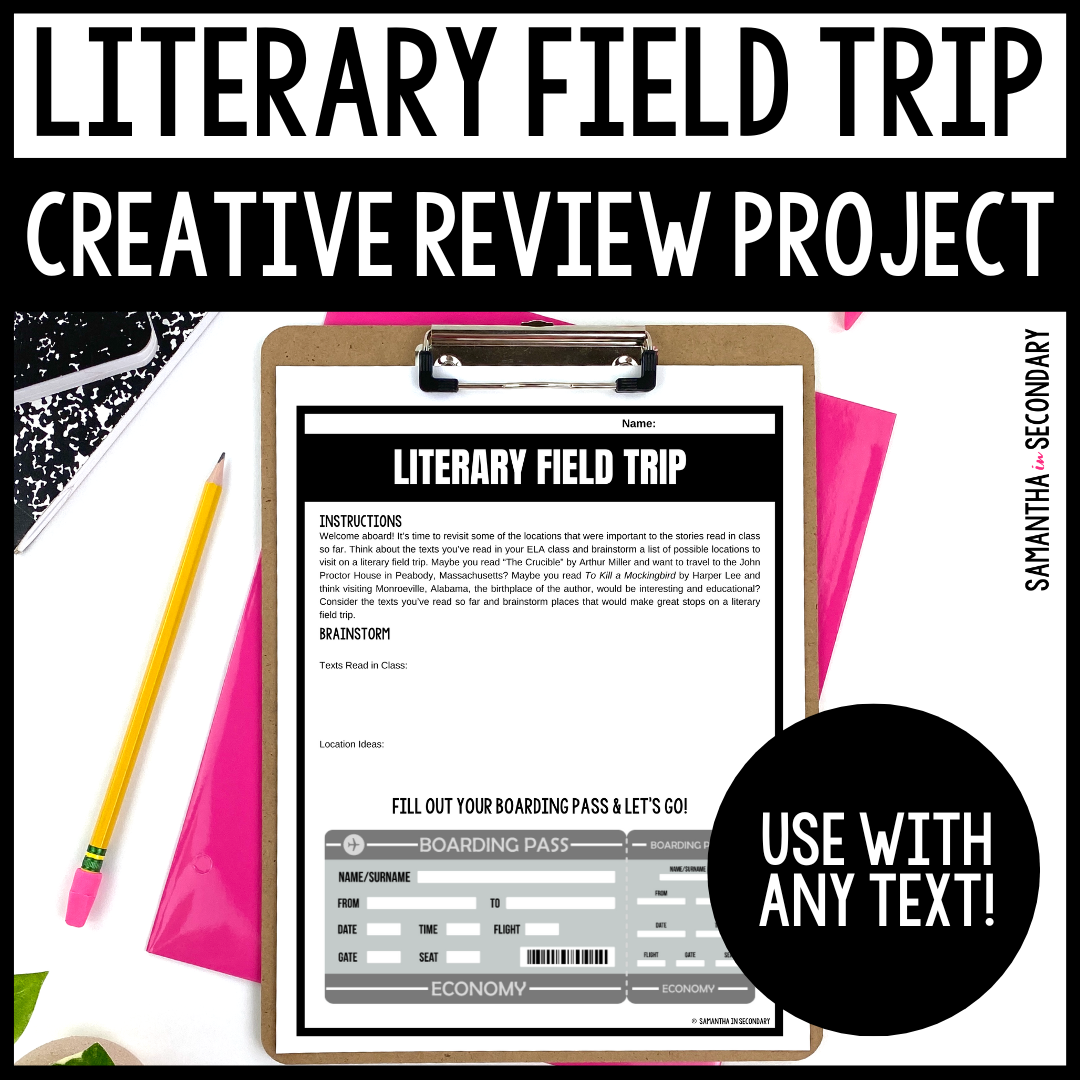
#5: Literary Quote Books
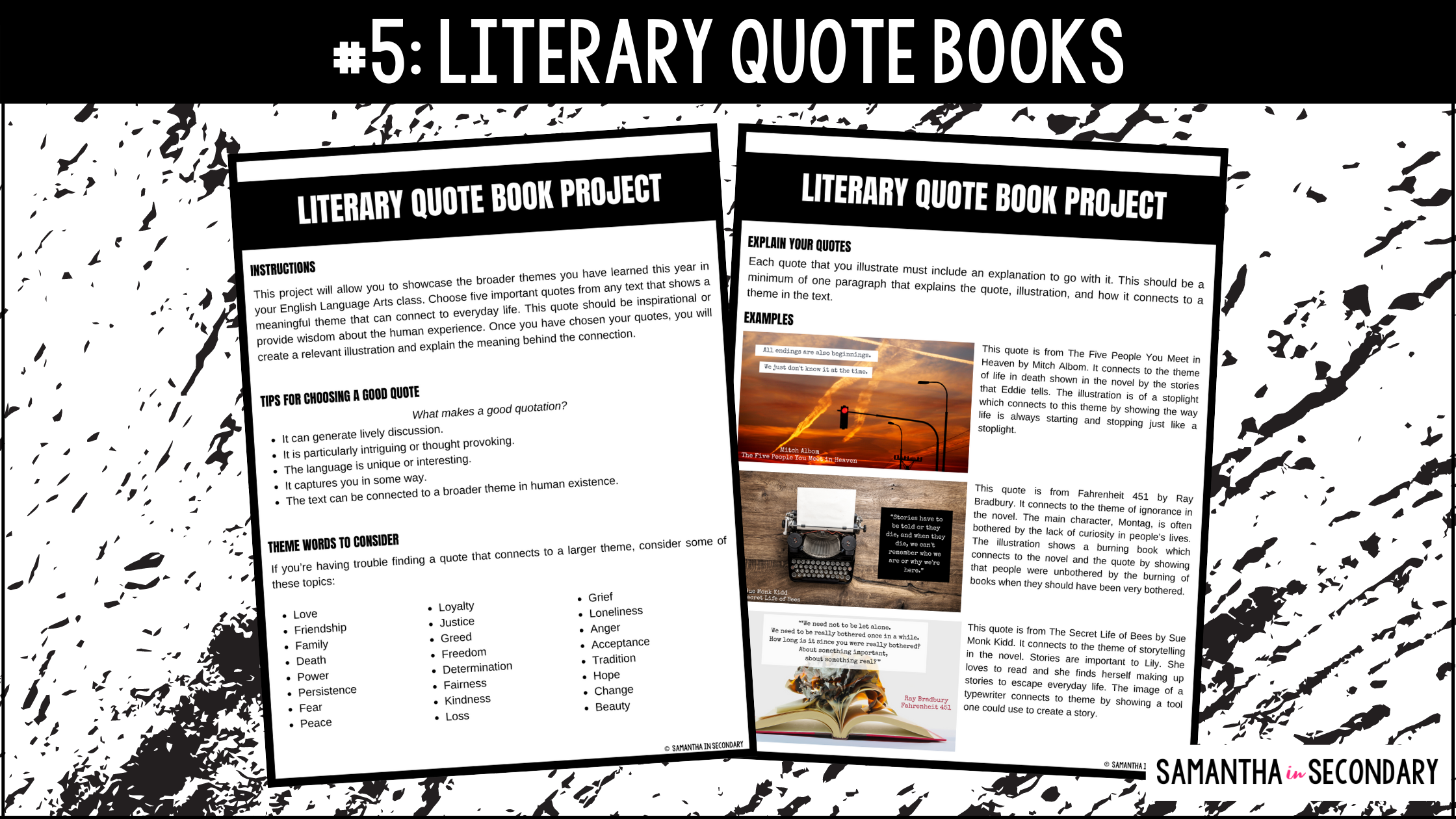
I got the idea for Literary Quote Books while scrolling social media one evening. I thought, “What if we have students choose the most meaningful quotes from any novel they’ve read and curate a book out of them then explain how they connect to the theme?” This was the basis for the idea, but it took off from there.
Truly, this can be a really flexible project for all types of learners. Students who are more artistic can draw a quote book out. Students who like to create digitally can use a program like Canva to design their quotes. (You could even have them create a social media carousel with them.) I’ve even had students who wanted to create and stage photos of the quotes or make them on large pieces of paper.
The possibilities really are endless with this idea. Since it incorporates close reading and theme analysis, the rigor is there no matter how the information is presented.
To check out my full resource, click here or the image below.
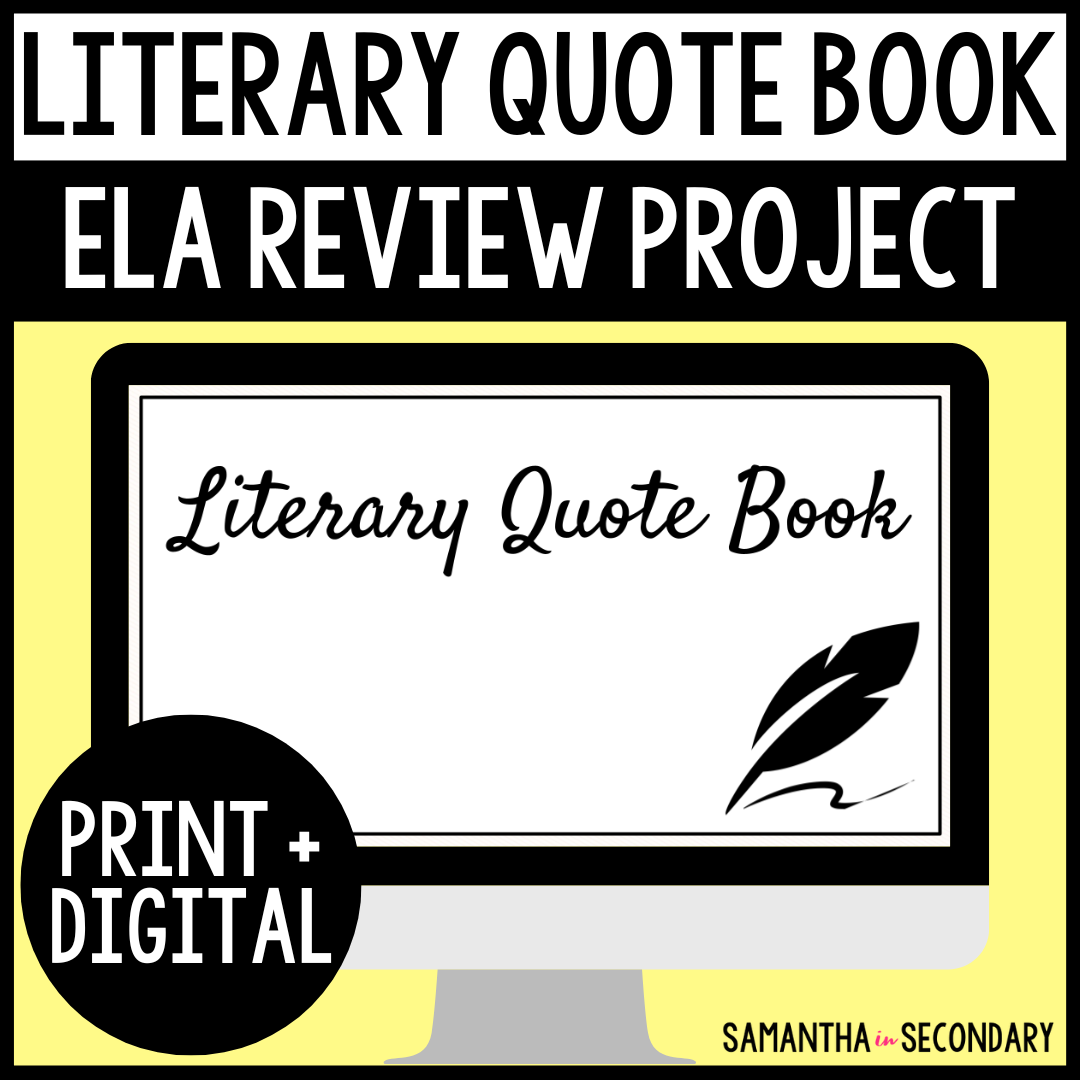
#6: Mood Boards
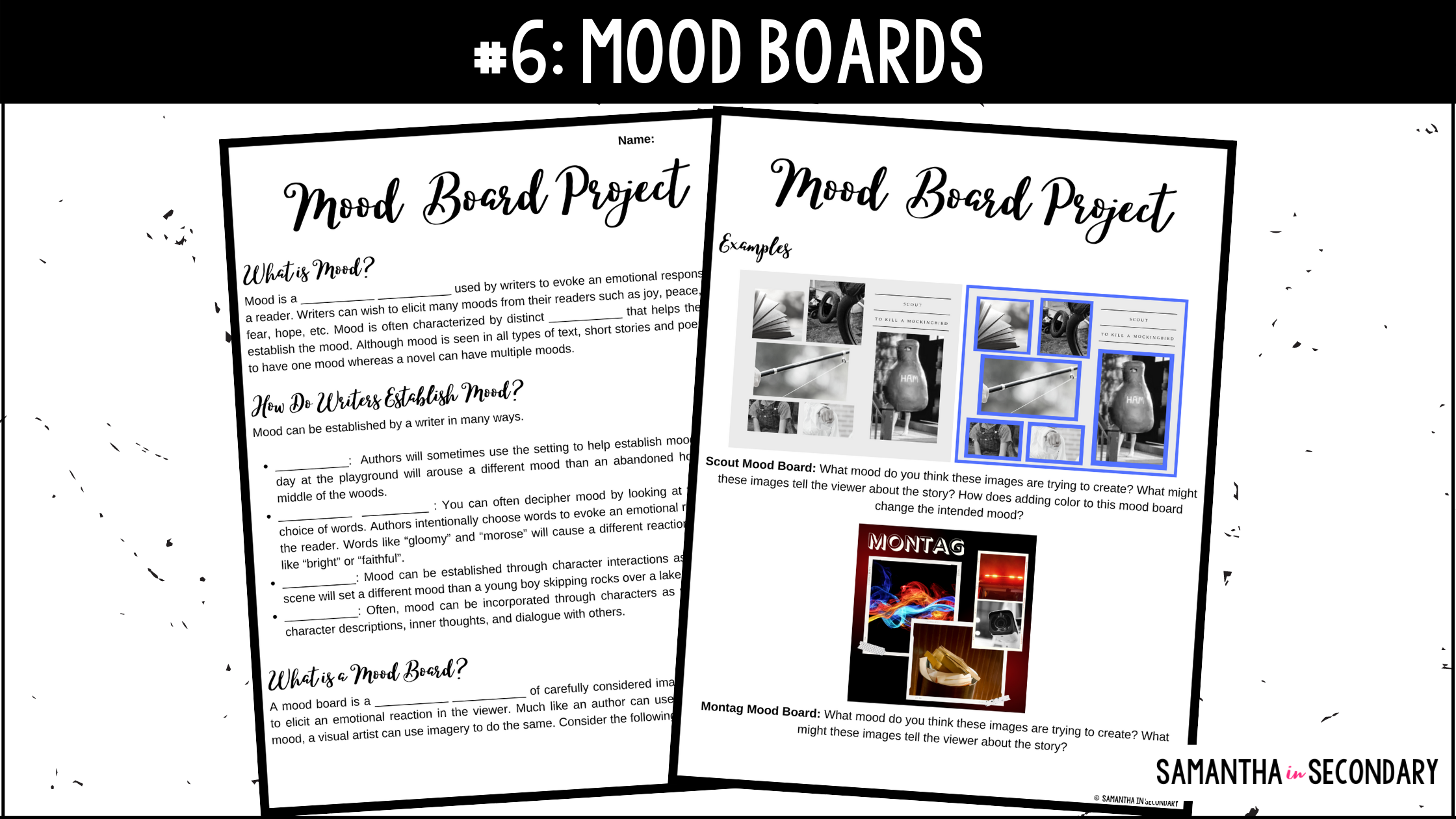
A Mood Board is a visual representation of carefully selected images that seek to elicit an emotional response from a viewer. Creating a mood board to represent a book requires a lot of analysis and critical thinking from our students.
I love having students put together mood boards because, again, it combines a lot of 21st century skills like spatial design, technology use, close reading, etc.
Check out my full blog post on Mood Boards here and see my ready-to-go resource in my shop right here .
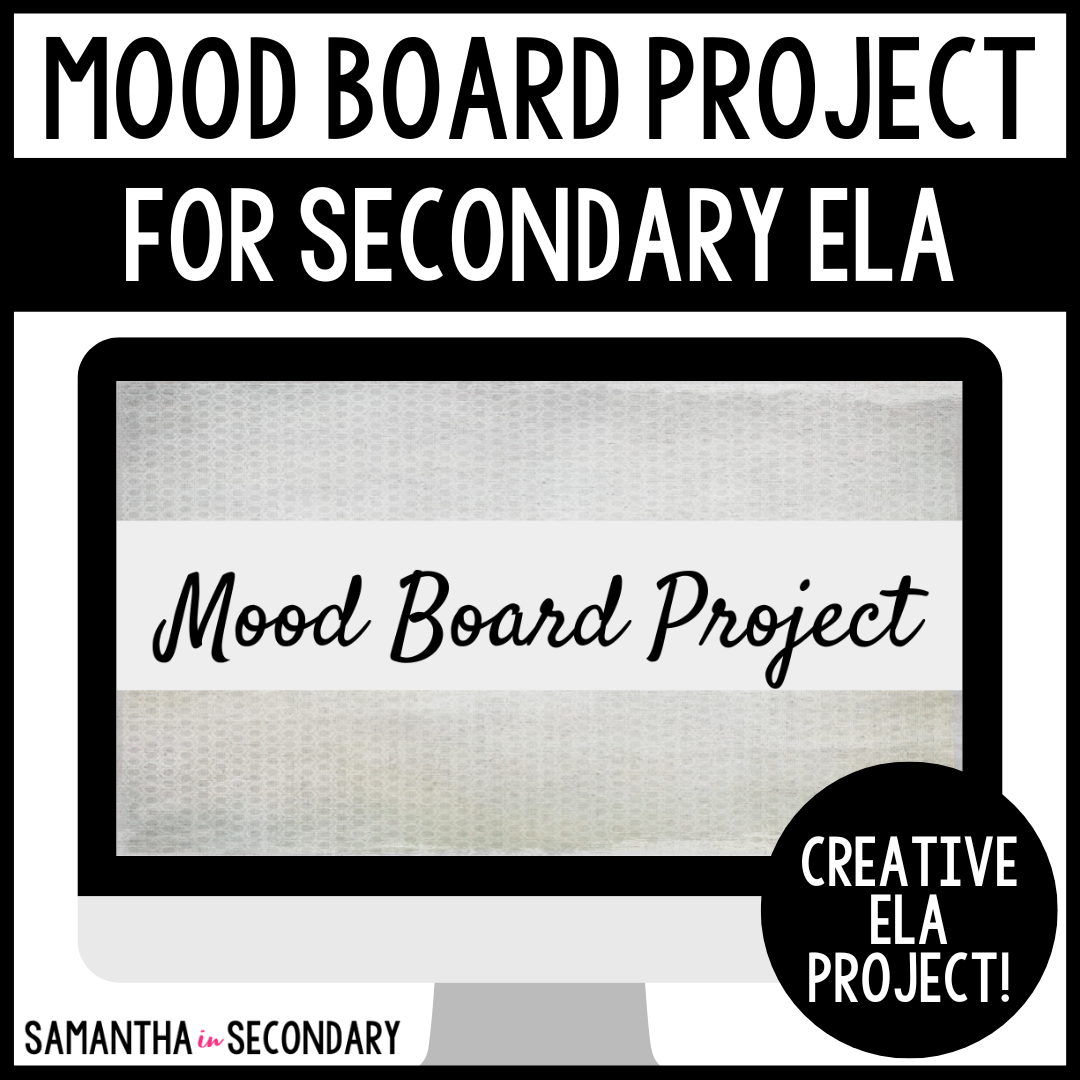
#7: Independent Reading Choice Board
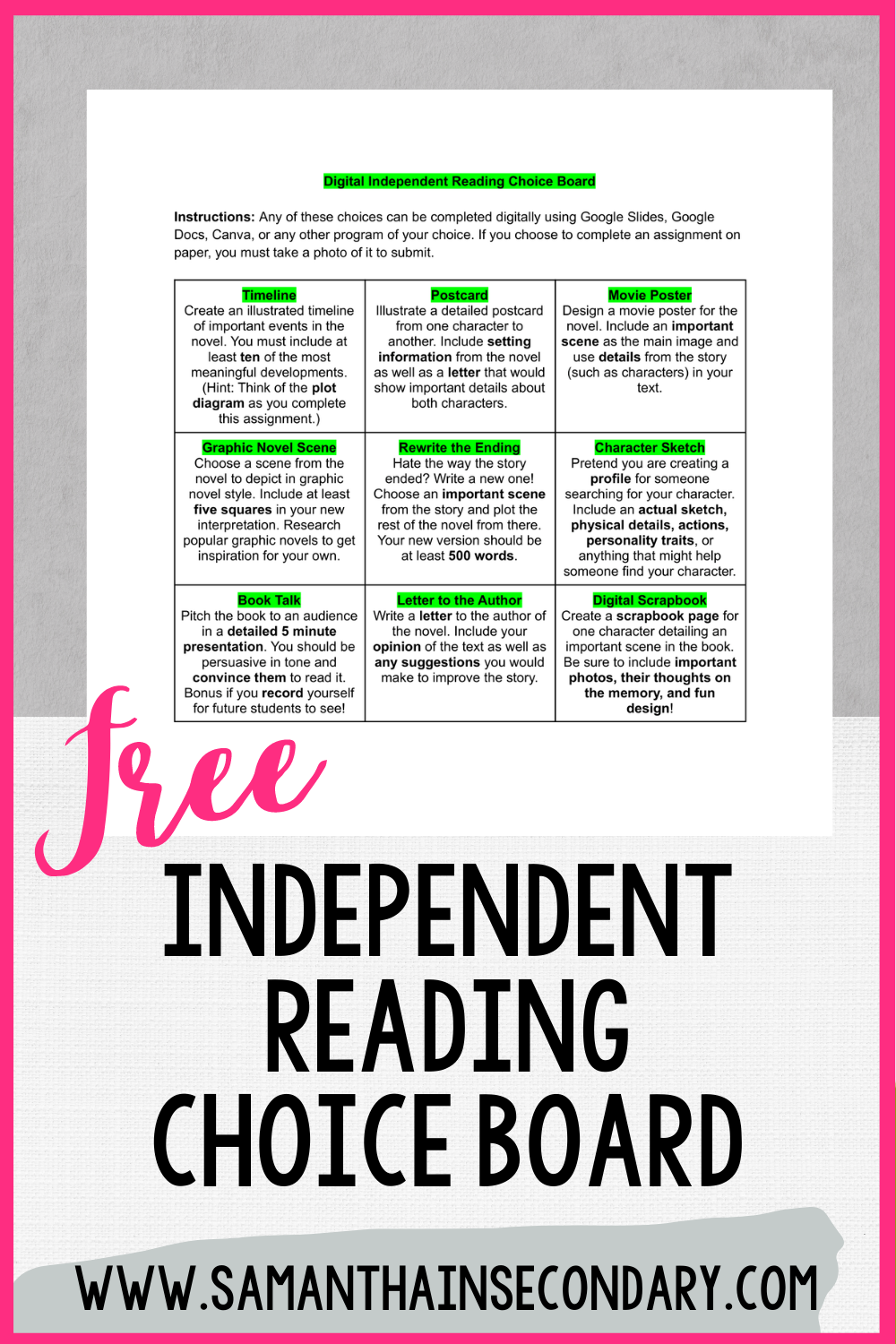
Just like choice reading, students love a good choice board to pick their own assessment. I have an editable Independent Reading Choice Board already done for you. Subscribe to my newsletter below and the template will be delivered straight to your inbox!
Get the Bundle and SAVE!
Download my full Independent Reading Unit Bundle and save 20% on ONE FULL INDEPENDENT READING UNIT . From start to finish, this unit is fully stocked with engaging activities and everything you need to run an organized, meaningful choice reading unit. Check it out here !
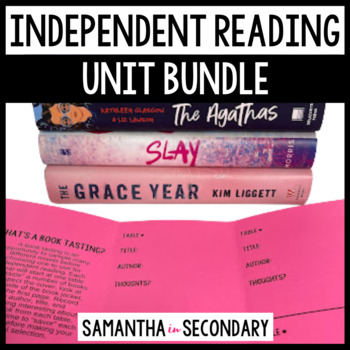
Giving students the gift of engaging literature makes for lifelong readers. I hope you’ll consider giving your students choice in their reading picks. I know that any of these assessments will help you manage the task in an authentic, engaging way.
Happy teaching!

Subscribe to the newsletter to keep up to date on all things Samantha in Secondary.
🎉 Our next novel writing master class starts in – ! Claim your spot →
BEST HIGH SCHOOL WRITING PROMPTS
Join (probably?) the world's largest writing contest. Flex those creative muscles with weekly writing prompts.
Showing 103 prompts reset
Set your story at a wedding reception, where a group of high school friends are meeting for the first time in years., write a story about an unconventional teacher., what was the last daydream that you dreamt while in class (be honest.) turn that into a short story..
High School
Write a story inspired by your favorite Tiktok reel.
You're trapped on a version of groundhog day... and the day that keeps looping for you is the day right before summer break starts..

Introducing Prompted , a new magazine written by you!
🏆 Featuring 12 prize-winning stories from our community. Download it now for FREE .
Write a letter to your middle school self. What would you want them to know?
Interview your favorite fictional villain. what questions would you ask them, you have to escape from a house on fire. what are the first three things you grab why, explain a computer to someone from the 16th century., define what trust means to you., subscribe to our prompts newsletter.
Never miss a prompt! Get curated writing inspiration delivered to your inbox each week.
Write a letter describing yourself and your modern life to a pen pal who lives in the year 1905.
What's your first memory describe it on paper using all five senses., write a guidebook for someone from outer space who is visiting your neighborhood for the first time., re-write a famous fairy tale from the villain's perspective., would you rather be able to change the past or change the future why, write about a time when you did something without thinking it through., if i were a superhero, i would..., describe the color blue to someone who's never seen it before., write a story that takes place completely in the dark., write an essay about technology, and the role that it plays in your life., win $250 in our short story competition 🏆.
We'll send you 5 prompts each week. Respond with your short story and you could win $250!
Contest #242 LIVE
Enter our weekly contest.
This week's theme: Fine Art
Prize money
Contest entries, closes at 23:59 - mar 22, 2024 est, recent contests ✍️.
#241 – Et Tu, Brute?
#240 – In the Wind
#239 – Fabulism with Shaelin Bishop
#238 – Aposiopesis
Recent winners 🏆
Jonathan Page – read
Gem Cassia – read
Weronika L – read
Eliza Levin – read
Leaderboard 🥇
#1 Zilla Babbitt
32341 points
#2 Deidra Whitt Lovegren
28631 points
#3 Abigail Airuedomwinya
22411 points
#4 Graham Kinross
14323 points
#5 Scout Tahoe
13193 points
#6 Chris Campbell
10903 points
#7 Thom With An H
10585 points
#8 Rayhan Hidayat
10210 points
#9 Michał Przywara
9844 points
#10 Deborah Mercer
9602 points
The best writing prompts for high school
Ah, high school. The birthplace of future geniuses, the setting of a million Young Adult books — and the cutting ground of many a brilliant young author. Writing in the classroom is often the best outlet of creativity for kids, and what better way to get your students excited about it than through creative writing prompts for high school students?
Whether you use journal prompts or story ideas to kickstart your high school student’s imagination, writing prompts are sure to help broaden their thinking, sharpen their writing skills, record their thoughts, and get them to engage with the world around them.
If you're looking to cut to the chase, here's a top ten list of writing prompts for high school students:
- In the form of diary/ journal entries, write about someone who's just experienced a big "first."
- Just then, your phone rings. It's your friend and they have some interesting news...
- Write a short story where the protagonist has a doppelgänger.
- Write a story about a misunderstanding.
- Write a story about a strange family tradition, with at least two characters from the family narrating in the course of the story.
- Write a story about someone who would be described, above all else, as: kind.
- Write a story that centers on an Instagram post.
- Write a story that spans a month during which everything changes.
- Write about a group of people determined to win an award for making the biggest cookie ever.
- Write about someone going to extreme lengths to return an overdue library book.
If you have a high school student who’s interested in becoming an author, check out our free resources on the topic:
Develop a Writing Routine (free course) — Any high schooler who’s serious about becoming a published author should know that writing a book doesn’t just take talent. 90% of the process is sitting in front of a blank piece of paper, and having the drive and commitment to put words to paper. That’s why we created this free course, which shows people of any age how to develop a writing routine that works for you. It’s never too early to start the process today!
Want to encourage your high school students to start writing? Check out Reedsy’s weekly short story contest , for the chance of winning $250! You can also check out our list of writing contests or our directory of literary magazines for more opportunities to submit your story.
NEW VIDEO COURSE 🎉
How to Write a Novel
Join Tom Bromley for a writing master class and finish your first draft in 3 months . Learn more →
Explore more writing prompt ideas:
Adults Writing Prompts ⭢
Adventure Writing Prompts ⭢
Angst Writing Prompts ⭢
Character Writing Prompts ⭢
Christmas Writing Prompts ⭢
Dark Writing Prompts ⭢
Dialogue Writing Prompts ⭢
Dramatic Writing Prompts ⭢
Dystopian Writing Prompts ⭢
Fall Writing Prompts ⭢
Fantasy Writing Prompts ⭢
Fiction Writing Prompts ⭢
Fluff Writing Prompts ⭢
Funny Writing Prompts ⭢
Halloween Writing Prompts ⭢
High School Writing Prompts ⭢
Historical Fiction Writing Prompts ⭢
Holiday Writing Prompts ⭢
Horror Writing Prompts ⭢
Kids Writing Prompts ⭢
Middle School Writing Prompts ⭢
Mystery Writing Prompts ⭢
Narrative Writing Prompts ⭢
Nonfiction Writing Prompts ⭢
Novel Writing Prompts ⭢
Poetry Writing Prompts ⭢
Romance Writing Prompts ⭢
Sad Writing Prompts ⭢
Science Fiction Writing Prompts ⭢
Short Story Writing Prompts ⭢
Spring Writing Prompts ⭢
Summer Writing Prompts ⭢
Teens Writing Prompts ⭢
Thanksgiving Writing Prompts ⭢
Thriller and Suspense Writing Prompts ⭢
Valentine's Day Writing Prompts ⭢
Vampire Writing Prompts ⭢
Winter Writing Prompts ⭢
Oops, you need an account for that!
Log in with your social account:
Or enter your email:
You are using an outdated browser. Please upgrade your browser or activate Google Chrome Frame to improve your experience.
39 Fun ESL Games and Activities for an Exciting English Classroom
Getting playful with the English language is a great way to push your students’ creativity and show them how useful their knowledge really is.
And the best way to do that is with fun ESL games for the classroom!
There’s nothing like a room full of friendly competition and laughter to make learning more fun.
Read on below for 39 ESL group activities that will get your students engaged and practicing their English. We’ll also discuss grouping strategies for effective gameplay.
ESL Vocabulary and Spelling Games
1. vocabulary showcase game show, 2. how’s yours, 3. fly swat, 4. shiritori showdown, 6. jeopardy, 7. backdraw, esl listening games, 10. flash art, 11. find someone who…, 12. telephone, 13. song puzzle, esl games for communication and teamwork, 14. question volley, 15. my name is x, and i like x, 16. reporter, 17. secrets, 18. find a partner, 19. what sweet treat am i, esl speaking games, 20. who am i what am i, 21. question master, 22. time trials, 23. balloon truth or dare, 24. word warm ups, 25. mayor (a.k.a. don’t vote for me), 26. reading race, 27. i took a trip to the usa, esl games for creative thinking, 28. storytelling memory game, 29. two truths and a lie, 30. funny papers, 31. dictionary, 32. oral storytelling, 33. written storytelling, esl grammar games, 34. would you rather, 35. conjugation pyramid, 36. tic-tac-toe, 37. shootin’ hoops, 38. hot potato, 39. word chain, 4 ways to group your students, group by varying skill levels, group by same skill level, group by same first language, group by different first languages, why esl games are an essential part of the classroom.
Download: This blog post is available as a convenient and portable PDF that you can take anywhere. Click here to get a copy. (Download)

Best for: Big groups; communication
In the Vocabulary Showcase Game Show, students will learn new words through firsthand communication. Students must explain the chosen word to their teammate without saying the word.
All you need is a whiteboard, a timer and a list of vocab words that students already have a fairly good grasp on.
How to play:
- Review the vocabulary words if needed or desired.
- Divide the class into two teams. Team A will choose their first contestant to start the game.
- Student A from Team A will stand with their back to the whiteboard.
- The teacher writes a vocabulary word on the board and starts the clock. Two minutes per word is best practice in order to get multiple students involved.
- Once the clock starts, Team A will do their best to describe the vocabulary word. They cannot use the word or spell it out.
- If Student A guesses the correct word, Team A gets a point.
- Switch. Now Team B will send up their first member to guess a new vocabulary word. Same rules apply.
- At the end, the team with the most points wins.
Best for: Small groups; beginners
This ESL game will have students guess the object everyone is talking about by asking the eponymous question: “How’s yours?”
You don’t need anything to play this game, though it may be helpful to have some slightly more challenging words to offer your students if they’re struggling as the game leader.
- Select a student to go first (or ask for a volunteer).
- This player is sent into the hall or somewhere out of earshot.
- The teacher will be game leader first. Pick a body part, type of clothing, common person or common object and inform your students of the secret word. Possibilities might include: shoes, mouth, car, mother, teacher or ring.
- The first player comes back into the room.
- The player’s goal now is to figure out what the secret word is by asking each student, “How’s yours?” Each student should respond in just two or three words. Remind them—no pointing!
- Once the first player has an answer from each student, they must guess what the object is. Use points or rewards as desired.
- Continue by having the first player become the game leader; a new student will go into the hall and be the guesser.
Tip: Pick the shy students early so they can play more confidently after they’ve been the guesser.
The secret word is “teeth.”
When the player asks their question (“How’s yours?”), students might respond:
Best for: End of the lesson; practicing synonyms/antonyms/homonyms
This fun ESL game is a race to the board! Students will compete to be the first to find the answer and swat it with their fly swatter.
You’ll need two fly swatters, PowerPoint and a projector. You can substitute the PowerPoint/projector combo for a simple whiteboard, but just know you’ll probably have to do some rewriting throughout the game. It also helps to prepare your questions ahead of time.
- Using PowerPoint, prepare a slide with vocabulary words scattered everywhere.
- Split the class into two teams.
- If needed, inform students they can only swat one word on their turn to make sure they really think about their answer.
- In turns, each team sends up one person to the board. They are each given a fly swatter.
- Read a question/definition aloud. The first student to swat the answer on the board wins the round!
Feel free to ask the same question more than once (repetition is part of the learning process!).
Best for: Warm ups; quick thinking
The word shiritori is Japanese for “chicken’s behind.” Each student will use the last letter of the previous word to make a new one. If the timer goes off—you’re out!
It can be played in any sized group, and the only thing you need is a timer.
- Choose a student to start the game.
- Enter the time on the timer, perhaps 1-2 minutes depending on the class. Begin.
- The chosen student starts the game by saying any word they’d like.
- The next student has to say a word that begins with the last letter of the previous word.
- Play continues until the timer goes off.
- The student who failed to think of a word may have to write on the board, or elimination can continue each round until there’s one winner.
(Teacher sets the timer to 30 seconds.)
Teacher: I’ll start. Mois t .
Student 1: Umm… T owe l .
Student 2: Hmm… L ik e .
Student 3: Like. Like. Like. Umm…
(Timer beeps. Student 3 is out.)
Best for: All lesson types
Hangman is an oldie but a goodie. Students must guess the letters of the alphabet to figure out a word or phrase before the hangman’s drawing is complete.
All you need is paper and pencils—or just a whiteboard if you want to play as a class. Let students take turns picking the word and drawing the blanks. Encourage using new vocabulary words so they can practice spelling.
(I found the original drawing inappropriate for younger students, so I usually drew my stick figure on the plank of a ship over a sea of monsters. As a bonus, students loved being chosen to draw one of the sea monsters on the board before the game began!)
- The leader draws the setup and the blanks for the chosen word or phrase.
- Students take turns guessing letters of the alphabet to fill in the blanks. Correct guesses are written into place in the blanks. For each incorrect guess, the leader adds one body part of the “hangman” to the drawing.
- If the guessers get the correct word first, they win. If the picture of the person is completed first, the leader wins.
- Switch out the leader and play again!
For extra fun, watch a video clip first, then play Hangman using only words from the clip. And for extra practice, at the end of each round, ask students to talk about the definition of the uncovered word or try to use it in a sentence.
Best for: Big groups; comprehensive review; critical thinking; speaking skills; teamwork
Jeopardy is another classic English classroom game that helps students build their confidence. You’ll set it up just like the TV show: a big board with answers and points, where students will need to provide the missing question.
For Jeopardy, you’ll need PowerPoint or an internet connection with an online jeopardy board, plus a projector.
- Prepare a jeopardy board with questions on the chosen subject matter. You can do this on PowerPoint with a premade template , or use Jeopardy Labs for easy set up.
- Assign point values that align with the difficulty of each question to ensure a fair distribution of points. Don’t forget to include a “Daily Double” for extra fun!
- In class, split the students into even groups of four, five or six. Adjust the number according to the number of students in the classroom. For the ideal playing situation, there should be 4-6 groups.
- After the class has been split into groups, the first group chooses a subject and point value.
- Read the corresponding question aloud. Anyone in class can raise their hand to answer the question.
- The first hand up gets to answer. If they’re right, their group receives the points and gets to pick the next question. If they’re wrong, subtract the points from that team; another group gets a chance to answer.
- The group with the most points at the end of the game wins!
Note: You may want to select a spokesperson for each group to keep chaos to a minimum. Rotate the spokesperson every few turns so everyone gets the opportunity to speak.
Best for: Big groups; all lesson types; spelling and vocabulary skills
Backdraw is one of the most popular games in classrooms and works for any level. In this game, the students aren’t allowed to talk.
- Put the students into equal teams and line them up facing the blackboard. All the students must face the blackboard and cannot turn around.
- Inform the students that they cannot speak during the game, or their team is out.
- Give a word to the last student in each team (the student furthest from the blackboard). Usually, it’s best to write the word down and have them read it, so nobody can overhear it.
- When the teacher tells them to begin, the last student must silently write the word on the back of the student in front of them. Once they’re done, the next student then writes the word they “felt” on the student in front of them. This continues until the first student has the word.
- The first student goes to the blackboard and writes the word, spelled correctly.
- The first team to complete the task correctly is the winner.
Best for: Big groups; teambuilding; from beginner to advanced students
This game focuses heavily on spelling and team skills, and it’s a great way to cement the difficult words on your vocabulary list.
- Divide the students into teams. The number of teams doesn’t matter.
- Approach the first team and give them a word to spell. The following steps should be conducted with each team, one at a time. The other students may listen, or practice silently spelling the words, but there shouldn’t be talking from the other teams.
- The first student on the team may only give the first letter.
- The next student says the second letter, and so on.
- Once the word is complete, the next student must repeat the whole word, to signal they’re done spelling.
- Each correctly spelled word earns the team a point.
This game can also be made more or less challenging by choosing higher or lower level words. Also, for more advanced students, they can be asked to spell the word backward.
Best for: Beginners; big groups; pronunciation practice
This game is an excellent way to use physical activity in the classroom while also engaging the brain in language learning.
- Line up the students in the front of the classroom. If you have a large classroom, have them line up in groups of six students at one time. While each group of six students plays, the other students are encouraged to watch and be engaged in the game.
- Assign each student a different word. Encourage them to repeat the word back to you.
- Now the game begins. The teacher (or a designated higher-level student) must say one word at a time.
- The student who is assigned that word must repeat it back and do a squat right away. A deep squat means they hold their arms out in front of them and bend their knees until the thigh bones are horizontal.
- If the student forgets, says the word incorrectly or is extremely late, they’re out and must sit down.
This game can be made more challenging by having the teacher speak faster, or having the students say and spell the word.

Best for: Creative students; reading comprehension practice
You’ll give your students scenarios in English and let them create quick interpretations through drawing. This ESL game offers a break from tough topics and traditional book learning.
For this game, you need plenty of paper and drawing materials like colored pencils, markers or crayons.
- Decide whether you want to work on students’ listening comprehension, reading comprehension or both.
- Say a scenario out loud or write it on the board.
- Students will transcribe or copy the scenario on a piece of paper.
- Give students an allotted amount of time to draw out the scenario on their paper.
- At the end of the session, students may present their drawings. You may also have them vote on their favorite piece for each scenario.
Note: You may only have time to do one or two Flash Art scenarios per session.
Examples:
- There is a man running in a park. He is being chased by a dog.
- A mother and daughter are baking cupcakes.
- Many cars are stuck in traffic due to rain.
Best for: Big groups
Students must be quick to listen and comprehend the spoken statement, or they’ll end up in the middle where they’ll have to come up with the next statement themselves.
The teacher can have a prepared list of “Finds,” or students can make up their own in this fun ESL game.
- Have everybody begin in a big circle.
- The teacher calls out something like: “Find someone who… is wearing glasses.”
- Everyone runs to grab the hand of a person wearing glasses. Assuming each student has two hands, only two people can be partnered with each glasses wearer.
- Whoever is left without a hand to hold stands in the middle.
- Select a student in the middle to call the next statement.
The possibilities are endless! Students can find someone who:
- is wearing red.
- has words on their shirt.
- can curl their tongue.
Best for: Big groups; speaking skills; pronunciation practice
Telephone is another classic. Students will whisper a given phrase down the line. The last person will announce the likely convoluted sentence to the class for everyone’s amusement.
This ESL game is easy to play—no materials needed!
- Have all of the students sit or stand in a straight line or a circle.
- Make up a phrase or sentence and whisper it in the first student’s ear.
- That student then whispers the phrase to the next person, and so on and so forth.
- If a student would like the phrase repeated to them, they can say “Operator!” This can only be done once per person.
- The last person to hear the phrase will repeat it out loud. It’s always funny to see how different the phrase turns out!
To make this game competitive, split the class into two teams and see who gets closest to the original phrase.
Best for: Small groups; sentence order review; listening practice; speaking skills
Song Puzzle is a fun ESL classroom game that will get your students jamming along to music. You’ll play a song while they arrange the lyrics in the proper order.
To set up this game, select an appropriate song (if you have young students, check out this resource for some suggestions). Print a copy of the lyrics for each small group in your class. Cut each one into strips to create a complete set of lyrics for each group.
- Make sure all your materials are prepared before class begins (the song is printed and cut into strips, and you have enough sets for each group).
- Separate students into small groups of two or three. Give each group a complete set of lyric strips.
- Play the song. Groups will try to organize the lyrics into the correct order.
- Continue replaying the song until a team is done. Check the order of their lyrics.
- The first group to organize the lyrics correctly wins.
- Continue playing until all groups have figured out the correct order of the lyrics.
- Use the lyrics to sing the song aloud as a class!
Depending on the song you choose, you can use the lyrics to teach a specific set of vocabulary or a grammar concept. For example, check out this list of songs with passive voice in the lyrics !

Best for: Big groups; speaking skills
In Question Volley, students will ask and answer questions on the spot to boost their confidence in responding to questions naturally and quickly.
All you need for this fun ESL game is a small ball! For added fun, you can always change up what you’re tossing around: a potato, a soccer ball, a frisbee, etc.
- Tell students the topic so questions remain relevant.
- Teacher starts! Have a student toss you the ball and ask you a relevant question.
- Answer the question.
- Toss the ball to a different student. Ask them a question.
- They will answer, and then pass to another student and ask them a question.
- Continue passing, asking and responding until everyone’s had a turn.
Make sure to encourage quick questions and answers to give this a real-life feel.
If your lesson topic is sports, some questions might be:
- What sports do you play?
- What sports do you like to watch?
- Who is your favorite athlete?
For more example questions, try this resource —and check out our dedicated post on ESL movie activities .
Best for: Combining with a vocabulary lesson; big groups; speaking skills; memory recall
Students will introduce themselves and something they enjoy. Depending on the level of your class, they may learn introductions, transitive verbs and first- and third-person sentence structures.
You don’t need anything for this game, but note that the more randomly you call on students, the more likely they’ll pay attention to others’ responses instead of counting how many more turns until they have to participate.
For beginners:
- Sit in a circle with your class.
- Introduce yourself using this format: “My name is X, and I like X.” For example: “My name is Mr. Smith, and I like to read.”
- Have the next student introduce themself using the same format.
- Continue until every student has had a turn.
For more advanced students, include memory recall. Ask students to introduce themselves and the previous student. That is: “His/her name is X, and he/she likes X. My name is X, and I like X.”
The most advanced way to play this game is to include questions, like so:
- Pick a student, either the next in a circle or at random.
- Ask them: “What’s your name? What do you like?” and let them respond.
- Introduce them in the format: “His/her name is X, and he/she likes X.”
- That student will now choose a classmate and ask them the questions.
- The student who asked the questions must introduce their classmate using the answers provided.
- Continue until each student has asked questions and introduced someone.
Best for: Listening comprehension; conversation practice; speaking/writing skills
In Reporter, students will ask their partner questions in the form of an interview. You may ask them to present or submit their partner’s response in writing.
If you choose to focus on writing practice, you’ll need paper and pencils. Otherwise, simply have some sample interview questions prepared to get the class started with this game.
- Brainstorm questions for 5-10 minutes, either individually or as a class.
- Have students pair up.
- During an allotted amount of time, students will ask their partner questions.
- Students may need to write the responses, take brief notes or simply try to remember the answers.
- After the time is up, switch the role of reporter and interviewee.
- At the end, students may present their partners to the rest of the class using the answers provided during game time. Or, students can hand in their interview notes.
You can also turn this into a more elaborate game by assigning the interviews as homework.
In that case, have students present their partners to the class without giving the identity of the partner. The class has to guess who the person is based on the presentation.
Best for: Quiet/lethargic classes
Students will use questioning skills to work out whose secret they know. Get them moving around the room and chatting with this fun ESL classroom game.
You’ll need some slips of paper and something to hold them in—a hat or a small bowl will do nicely.
- Ask each student to write down a secret on a piece of paper. Check that the secrets are written down correctly, but don’t betray students’ secrets to their classmates!
- Have each student fold their paper and put it in a hat.
- Each student will then draw a secret from the hat.
- Once each student has a secret, they will walk around the classroom asking other students questions to find out whose secret they have. They can’t directly say what’s on the paper!
The secret says, “I have five cats.”
The person holding the secret might ask a classmate:
- Do you like animals?
- How many animals live in your house?
Best for: Big groups; speaking skills; combining with a vocabulary lesson
In this ESL game, you’ll give students a category. They’ll write their favorite thing in that category on a piece of paper. Then they’ll search for someone who wrote the same thing—without actually using any of the words they wrote down!
All you need for this one is some small pieces of paper.
- Decide the topic (books, food, movies, etc.). Make sure it’s something that students can talk about in some detail.
- Each student writes down their favorite book (or food, movie, etc.) on a piece of paper and hides it in their pocket or textbook.
- Without using the words they’ve written down, students then go around the room, asking their classmates questions.
- Students who think they’ve found a classmate with the same answer can sit.
- Once everyone’s discovered a partner or once the allotted time is up, students reveal their papers to each other.
To make sure this game is working as intended, the teacher must moderate effectively. Walk the room to ensure students are practicing proper English. Correct them as needed based on topics you’ve covered in class.
Best for: Beginner and intermediate students; speaking practice
Students will take turns asking questions to figure out what sweet treat they are in this fun ESL classroom game.
For this one, you’ll need tape and as many kinds of candy as you have students in class (so, 10 students means 10 different types of candy). Make sure it’s candy they’re familiar with.
- Tape a candy wrapper to each student’s back.
- Put the students in a circle.
- Tell students how many questions they can ask before they’ll need to make a guess, and decide what will happen if they get it right/wrong (points, guess again, player is out, etc.).
- Select someone to go first.
- The first player stands up and turns around so everyone can see their candy wrapper.
- The player can ask the group yes or no questions to get clues about their candy.
- After the set number of questions, the player must guess.
- Continue until all sweet treats have been guessed and revealed.
The standing player might ask some of the following questions:
- Does it taste like strawberries?
- Does it have chocolate?

Best for: Advanced students; practicing asking questions
This is a slightly more advanced version of the “What Sweet Treat Am I?” activity. It can be modified to include writing if you ask the students to create the cards, rather than doing it yourself.
How to play:
- Before beginning the activity, you may want to brainstorm the types of questions that will help students figure out their cards.
- Using sticky notes or index cards, list common household or school-related objects on each one.
- Have each student pick a card without looking at what it says.
- Have them stick it to his or her own forehead.
- Students then ask their fellow students yes or no questions in order to figure out what their card says.
For more advanced students, cards can list literary characters, book titles or even idioms. Another option is to keep all of the cards related to one theme, like health words, clothing, colors or even slang.
Best for: Experienced speakers; creative thinking
Question Master helps your students figure out what to ask in a given situation. Set up the scenario and let them ask away!
All you need for this game is a timer. Any amount of people is good, but note that this ESL game works best with more experienced speakers who are comfortable creating sentences on the fly.
- Choose a scenario for the class, like at a café, at the airport, or even on a date.
- Set the timer. Begin.
- Each student must ask a question relevant to the scenario. Encourage creativity with this one!
- Continue until the timer goes off. The student is out or the game is over.
(Teacher sets the timer to a minute and thirty seconds.)
Teacher: Okay, the scenario is at a shop. Go!
Student 1: How much is this?
Student 2: Do you accept credit cards?
Best for: Individual students
Instead of racing against others, students are trying to get their own personal best time for English speaking. They’re aiming for speed and precision.
While you could do this with an ESL class, it’s particularly helpful for individual learners. You’ll just need a topic and a timer that starts from zero.
- Select something for the student to read/say. This could be anything! A passage in a book, a set of statements, etc.
- Start the clock from zero once the student starts reading/speaking.
- When the student is done, stop the timer.
- Tell the student their time.
- Give them tips on how to improve their speaking speed.
- Have them practice, either in class or out, until they get to a more natural time.
Teacher: Okay, tell me your name, age, where you’re from, and what you do. Ready? Go! (Starts timer.)
Student: My name is… (continues talking)
(Teacher stops the timer when the student finishes.)
Best for: Outgoing students
This is a slight twist on the classic truth or dare. Inside balloons are truths (personal questions) and dares (silly actions), which students must complete in front of the class.
You’ll need balloons (at least enough for each student in the class) and slips of paper, as well as truths and dares. Feel free to adapt statements using vocabulary and grammar suitable for the level you’re teaching.
- On slips of paper, write student-friendly dares and questions. Make sure they’re things that most students would be willing to do and answer.
- Put each slip of paper inside a balloon and blow it up. You may want to color code (red balloons = dares, blue balloons = truths), or let it be random.
- Scatter the paper-filled balloons around the room.
- Select a student to go first. They will pick a balloon and pop it, then read their truth or dare aloud before completing it.
- Continue having students choose a balloon, pop it, read the prompt and complete the task until everyone has gone.
A small tip: You may want to start with your more outgoing students. But don’t let your shy students be last either–try to call them out around the middle to help manage their anxiety.
For some possible dares, you might write:
- Do a popular dance.
- Sing a class song by yourself.
- Pretend like you’re riding a horse.
- Snore or snort.
And for some possible truths, you might write:
- What did you look like when you were 10 years old?
- If you could live anywhere in the world, where would you live?
- When you were little, what did you want to be when you grew up?
Best for: Warm ups; grammar review; creative thinking
In Word Warm Ups, students will attempt to use the given English concept in a sentence before time runs out.
You’ll need a timer. If the timer is your phone and you don’t want it passed around the room, you’ll also need a small ball or another easily passable item.
- Set the rules for sentence structure. For example, students must make sentences using “should/shouldn’t.”
- Enter a designated time on the timer. Begin the clock and hand the timer/ball to the first student.
- The first student makes a sentence using the grammar construct, then passes the timer/ball to another student.
- Students continue making sentences and passing the timer/ball until the timer goes off.
- You can make additional consequences as desired for the student holding the timer/ball when it goes off.
Teacher: Okay, so sentences using the phrase, “even though.” Go!
Student 1: Hmm… I like Canada even though it’s very cold.
Student 2: Okay. Even though she’s only 30, she’s too old for me.
Student 3: Hmm, I… umm. Even though, umm…
(Timer goes off. Student 3 is out.)
Best for: Advanced students; speech-giving practice
Mayor requires both higher English ability and an appreciation of irony. If your class has both, this game may get shy students to take risks and even be a bit silly. Students will run to NOT become mayor.
No materials are needed. Note that you may want to lower the intensity for your shy students by having everyone stand at their desk to speak rather than the front of the classroom.
- Explain that you’re going to have a mock election for mayor in your classroom, but it’s a job nobody wants. Each student must convince the class that they should NOT be mayor and why.
- You may need to go first to show the possibilities.
- Select the first student to give their speech. You can set a time limit so no one speaks too much or too little.
- Continue until each student has given their speech.
- The winner is the one who comes up with the best reason not to be mayor, which can be decided by vote. It’s an election, after all!
“I would hate to be mayor. Do not vote for me. I do not like to be around smelly, old citizens. Children are noisy. Who cares about education?”
Best for: Reading class; small groups; reading speed; pronunciation practice
This English classroom game will have students race against the clock to finish the reading passage. The key is that they must do so with no mistakes.
You’ll need a timer and reading material to play, so this game is especially great if your class has a reading text they’re working through.
- Provide students with the reading passage you want them to practice. Make sure everyone’s on the correct page.
- Set the time and begin the timer.
- Each student will attempt to read the next sentence (or the whole passage) perfectly .
- If they mispronounce a word or rush through a sentence, correct them. They must start again from the beginning.
- Once they’ve read the given part with no mistakes, it’s the next student’s turn.
- The student who’s reading when the timer goes off is out!
(Teacher sets the timer to two minutes.)
Teacher: Okay, reading race, page 7. Ready? Go!
Student 1: (Reads passage perfectly)
Student 2: (Reads passage but has an error with pronunciation)
Teacher: (Tells student correct pronunciation) Sorry, reread!
Student 2: (Reads passage perfectly)
Student 3: (Reading but struggling a bit)
(Timer goes off. Student 3 seems to be having some trouble with these games! They’re out.)
Best for: Big groups; listening skills; memory recall
This speaking game puts an emphasis on listening , focus and memory-building skills while also encouraging students to recall vocabulary.
- Teach the students the speech they must learn for every turn in the game: “I took a trip to the USA, and with me I took…”
- The first student says the sentence, and names an object starting with an “A.” For example, “…and with me I took an apple.”
- The next student must repeat the first word, then add a word that starts with a “B.” For example, “…and with me I took an apple and a banana.”
- Every following student must repeat every word previously said, and add a word starting with the next letter of the alphabet. For example, “…and with me I took an apple, a banana, and a cat.”
- The game continues until a word cannot be named or a word is forgotten.
This is a very flexible game that can be adapted to any classroom. First, be specific on wanting students to use articles and the word “and” before the last word. Also, you can give the classroom a category to follow, such as asking them to name animals or foods.

Best for: Speaking skills; memory recall; vocabulary building; sentence structure review
Together, the class will tell a story out loud by finishing each others’ sentences in this ESL game.
Smaller groups make this game easier, while larger groups will really test students’ memories. No materials needed!
- Begin by sitting in a circle.
- The first person (this can be you, but it doesn’t have to be) starts the story with a fragment, such as: “It was a dark and stormy night…”
- The next person in the circle must repeat what the first person said and add a phrase of their own.
- Continue going around the circle until someone messes up. You can start over, prompt them or something else.
- In the end, you could have students write down the story. Or write it on a poster board and hang it up in your classroom for students to remember and get a good laugh!
Teacher: It was a dark and stormy night…
Student 1: It was a dark and stormy night and no one was around.
Student 2: It was a dark and stormy night and no one was around. Suddenly, there was the sound of…
Best for: The first class; advanced students; speaking/writing skills; conversation practice
In this game, each student will present three statements about themselves—two are true, and one is false. Their classmates must ask questions in order to determine which statement is the lie.
Two Truths and a Lie only requires a whiteboard (or anything you can write on).
- Ensure the class understands the meaning of both “truth” and “lie.”
- You’ll go first as an example. On the board, write two truths and one lie about yourself.
- Tell the class that one of the statements on the board is not true .
- Students may ask you non-specific questions about what you wrote. You may want to give a question limit to raise the stakes of the game.
- Once the questioning is over, students will write down which statement they believe to be the lie.
- You can ask them to share their guesses and why they came to that conclusion.
- Reveal the lie!
- Select a student to take your place. The game repeats until everyone has had a turn.
One statement says: “I enjoy running every morning.”
Students may ask things like:
- What kind of running shoes do you have?
- What time do you begin your run?
Best for: Writing practice; collaboration; pair or small group play
Funny Papers is a fun ESL game where students are asked to fill in the blank speech bubbles of a comic strip.
Using the Sunday funny papers or some blank comic strips online , white out the text of each character’s speech bubbles or dialogue boxes. Make enough copies for your class.
- Give your students an example. Show them the comic strip and ask what they think is happening in the scene. Write some of their responses in the speech or thought bubbles above each character.
- Now, split the class into groups for the activity.
- Hand out the comic strips and let each group create their own Funny Paper.
- Visit each group to offer insight and answer questions they may have.
- Once the comics are complete, students can present them to the class.
Best for: Any level; speaking skills; writing skills
If you know the game Balderdash , you’ll recognize Dictionary. One team member will lead the way. Players will guess the definition of a difficult word, and a judge will decide their favorite answer. In the end, someone wins a treat!
You’ll need dictionaries or vocabulary lists (with definitions) for this game. You’ll also need sticky notes for each group and some prize candy.
- Split the class into groups of five or six students.
- Give each group a packet of sticky notes and a dictionary/vocab list.
- For each group, select a leader and a judge. (Tip: Try picking the shyest students to steer the groups first.)
- The leader finds a word in the dictionary/on the list that they do not believe anyone else knows. The leader writes the correct definition of the word on the sticky note.
- The leader spells the word out loud, and everyone except the judge writes it down on their own sticky note.
- Everyone except the leader and judge will now make up their own definition of the word and write it on their sticky note as well. The students can come up with a silly definition, try to guess the correct definition or try to fool the judge with something that sounds convincing.
- The leader collects the definitions and gives them to the judge.
- The judge reads each definition out loud. (If your judge has a flair for the dramatic, all the better!)
- After reading all the definitions, the judge decides which one they like best. The player who wrote it gets a piece of candy.
- The roles switch. The judge becomes the leader and a new judge is selected.
- Keep playing until every student has had a chance to be both the judge and the leader.
The leader picks the word “sundry.” She spells it out for the players.
The leader writes the correct definition on her note (“miscellaneous”).
One player thinks about the literal meaning and writes: “wet clothes left outside.”
Another player guesses: “popcorn.”
Another player decides to be silly and writes: “lying to your teacher.”
The leader mixes up the definitions and hands them to the judge. The judge reads each definition out loud, and everyone has a good laugh.
The judge decides she likes the “wet clothes left outside” definition. The player who wrote this gets the candy and then the leader explains that the correct definition is “miscellaneous.”
Best for: Listening comprehension; speaking practice
Students have to be able to follow along with the story, listening closely to what the people before them just said, and they have to think critically to build a correct sentence of their own.
For beginning ESL students, consider speaking sentences out loud yourself and asking them to add one word at a time. They could even draw or hold up pictures to add to the story.
- Have students sit in a circle. Begin telling a story by speaking one sentence aloud.
- The student on your left should add to the story by speaking a second sentence aloud.
- The student to his or her left should speak the next sentence aloud, and so on.
- Keep the story going around the circle one sentence at a time until it comes to a logical conclusion.
Remind students that each sentence should build on the one before it.
It’s easy for students to add in something offbeat or random to try to be silly, but the goal of this lesson is to create a logical story. One way to keep the story on track might be to record it.
Best for: Working as a team; writing practice
This is a bit like a word association game, but requires that the students expand on that to create a story.
For more advanced students, consider assigning topics that require students to discuss customs or cultural norms, like privacy, personal space, hygiene or dining.
How to play:
- Divide the class into small groups.
- Each group gets to choose three random words from a bag and must incorporate each word into a short story.
- Depending on your students’ level, you can assign specific numbers of characters, amount of dialogue, length, etc. to be included in the story.
- At the end of the lesson, groups can take turns reading stories aloud.
- For increased participation and extra practice with speaking, you can ask the students who are listening to the story to comment on their classmates’ work. For beginning students, sentence starters like, “I liked….” or “what did you mean by…?” can be helpful to encourage feedback.
Both the written storytelling and the small group discussion that follows are valuable practice time. Together, they’ll help students practice written and spoken English in one swoop.

Best for: Making learning conditionals fun and and lively
This classic sleepover and bus trip game, ideal for getting participants to know more about each other, can be a perfect giggle-inducing grammar game to reinforce recent lessons. The game is simple enough, driven by straightforward questions and answers.
The main use for this game in the ESL classroom is to practice using conditionals and discussing hypothetical situations ( would you):
Would you rather get stung by a bee or bit by a spider?
Would you rather dance in front of ten thousand people or in front of the President of the United States?
How to Play:
- Put students in pairs or play as a class.
- Provide questions on handouts.
- Let students answer the questions and make corrections if needed.
Example: “Sara, how many of your classmates would rather dance in front of the President of the United States?” Then this student must tell you how many people chose this option in her group or in the class.
Best for: Learning verb conjugations
Similar to blackboard race, the conjugation pyramid is a race-to-win classic that is beloved by language students everywhere. Set this one up for the very end of class when there are a few minutes remaining—this will really get the pressure cooking.
- Draw a pyramid on either side of the board and break it up into blocks—kind of like a food pyramid, but with as many blocks as there are rounds in the game. So, if you want to go 10 rounds, draw 10 blocks in each pyramid.
- Then you’ll give your students a verb and a person (first person singular, second person plural) and they will have to run to the board and conjugate the verb into each tense accordingly.
- Depending on the skill level of your students and what you’d like to practice, you can also choose a tense and have students conjugate the entire verb chart for that tense. The student who gets the conjugations right wins their team a block in the pyramid!
- When a student wins a pyramid block, fill in that block with chalk or marker to indicate the progress.
- The first team with enough blocks to build their whole pyramid wins!
Best for: Learning parts of speech
- Draw up the grid for tic-tac-toe on the board.
- Divide students up into two teams.
- Fill in each square of the grid with a part of speech you want students to practice. What exactly you choose to include here is totally flexible, and depends on what lessons you’d like to reinforce. If you’re studying verb conjugation in the present tense, for example, fill in the grid with verbs in their infinitive forms.
- The first team goes by choosing a square from the tic-tac-toe grid. They have to figure out, as a group, how to properly conjugate that verb.
- If they get the answer right, then they claim that square of the grid. If they get the answer wrong, then they lose their turn.
- Keep playing until one team scores a tic-tac-toe!
Best for: Getting students physical as they reinforce grammar lessons
Go down to the school’s gymnasium, playground or set up a makeshift basketball hoop in the classroom. You can manage this without damaging school property by simply setting up a hula hoop or other plastic ring as the “hoop” and by playing with a small inflatable or foam ball.
- Break the students into two groups or have them play individually against the rest of their classmates.
- There are two ways to go about playing this one. Before being allowed to take a shot, each student must either:
- Answer a question with the appropriate featured grammar pattern.
- Create a basic statement using the featured grammar pattern.
- If the student gets their answer or statement wrong or doesn’t phrase it properly, they won’t get to take a shot.
- If the student passes this part of the game, they get to take a shot. If they score, they get 2 points. If they don’t score but got the question right, they get 1 point.
Best for: Encouraging quick thinking about grammar points
- Use a foam or inflatable ball, and start up a fast-paced round or two of hot potato.
- The objective, of course, is to pass the ball around in a circle as fast as possible.
- Before passing the ball to the next student, the student holding the ball must show off their English grammar skills.
- When a student catches the ball, they must quickly think up a word that fits your given criteria, spit it out and pass the ball before the allotted time runs out.
- This is super flexible and can be adjusted to practice virtually any bit of grammar you’ve recently introduced or would like to review.
Example: Tell students learning the present tense that they must each say one verb conjugated in the present tense, using first person singular or “I form.” Each student will then have to say something like, “I run,” “I dance” or “I cry.” The ball gets passed around and around, with students being eliminated whenever they draw blanks or conjugate their verbs wrong.
For easier games, give each student 6-8 seconds. For harder, faster paced games, give students 2-3 seconds. You can also start slower and gradually increase the pace of the game as it progresses.
Best for: Thinking quickly and creatively
- Start the class off by giving them a word which fits your desired theme.
- Restrict them to only certain parts of speech, such as nouns or verbs. For an extra challenging session, limit the words to certain moods and tenses.
- The student who starts off the game will have to think of a word that begins with the last letter of the word you provided.
- If you’re practicing nouns and say “food,” then the student could say “dog” or “dish.” If you’re practicing with adjectives and started with “beautiful,” then the next student might say “lazy” or “loud.”
- Go around the classroom playing this way and eliminating students who can’t think up words quickly enough.

You’ve got your pockets full of group ideas that work in class. But believe it or not, how you group your students might be more important than the actual activities you do.
But what’s the secret to grouping students the right way?
Here are four ways you can put your students together and why you might choose to group them each particular way.
Did you know that even native speakers change the way they talk based on who they’re talking to and that person’s language use? It’s part of the feedback mechanism of the brain and why you might acquire a bit of a Southern accent when talking to your friend from Alabama or why you might start dropping final g’s if you hang out in New York for any length of time.
Because when you group lower level students with higher level students, they’ll automatically and subconsciously improve their English usage just by hearing and talking to more advanced students . Crazy, isn’t it?
While a more advanced student will likely speak more like their lower level student partner, too, they aren’t losing out on the deal. We learn more when we teach . And when you group advanced students with lower level students, they’ll learn by teaching the other members of their group even if they don’t realize what’s happening. If you have a mixed level class, don’t despair. Your students can learn as much from each other as they do from you when they’re in these types of groups.
While students can learn a lot by working with classmates at different language skill levels, that isn’t always the way you want to partner up your students. Sometimes mixed level groups can be dominated by advanced speakers and beginning students can get lost in the mix.
Not so when your groups are selected for their similar language proficiency.
In a group of all beginners, someone will have to speak up, and that means your lower level students will be talking more in class. In your group of all advanced students, everyone may want to drive the conversation. That means the members of that group will have to work on their discourse skills like taking turns speaking and using active listening . If you have students who dominate the conversation in class, this might be the right type of group for you.
Have you ever heard that grouping students with others who speak the same first language is taboo? Forget about it. Your students will actually be able to help each other in very unique ways when they’re grouped with others that speak the same first language.
More advanced students understand the specific language struggles faced by beginning students and can help them through struggles that they themselves have already overcome. Your advanced students can also explain using their native language which is a great advantage when you’ve tried everything to communicate to your students and they still aren’t getting what you’re trying to say.
Grouping by the same first language is also an advantage when you’re discussing some sensitive topics, those that might hit a cultural hot button. While not every speaker of a language comes from the same culture, many do, and if you’re afraid of cultural flare-ups because of a certain topic, try grouping your students this way to minimize the drama that might otherwise come up.
Have I convinced you that grouping by the same native language is a good thing? Well, stop it. At least sometimes. Because mixed L1 groups are useful to students in other ways. When all the members of a group speak different first languages, they’ll all be forced to speak English in order to work together.
This is particularly useful if you have students that just won’t speak in English because they always have the chance to speak their first language. A mixed L1 group also gives your students the chance to experience different accents in English and as a result improve their listening skills. Culture can also come into play in these groups. By talking with people from different areas of the world, your students can develop a better appreciation for each other and their home cultures. It’s a great way to learn about people around the globe along with their traditions.
ESL games are as versatile as they are fun! They’re also a super important part of your lesson plans. Here’s why:
- They’re invaluable for building on your presentation (the first part of your PPP lesson plan ).
- They’ll help your students cultivate essential skills, both directly and organically.
- They’ll often get your students up and moving, which helps get the brain working.
- They’ll help your students internalize grammar and vocabulary through usage.
- They’ll aid the development of students’ English listening, reading, speaking, writing and thinking skills.
- They’ll improve your students’ communication, collaboration skills and confidence.
- They’re usually active —great for both classes that need somewhere to direct their energy and classes that need to kick it up a notch.
- They can be used at any time during class: as a beginning warm-up, as an end-of-class time-filler or in the middle as the bulk of your lesson.
Games can be implemented alongside any other teaching tools as well.
They’re useful during difficult or frustrating lessons to supplement traditional book learning time. They can also be used in conjunction with videos to keep your classes engaged from start to finish.
For level-appropriate videos with helpful tools, the FluentU language learning program uses authentic clips made by native speakers to teach your students English.
The clips are organized by content and level, so you can ensure they’re the right amount of challenging for your class. The videos also have interactive subtitles, so students can hover over a word to see its definition or click on it for more information, including example sentences and contextual notes.
As the teacher, you can assign FluentU videos for homework, track student progress and create vocabulary lists for students to review with the digital flashcard feature. Then in class, you can practice the vocabulary together using one of the games listed above.
Working some fun ESL classroom games into your lesson plans every week creates an atmosphere of enthusiastic learning. Your students will have a blast while working on their English skills!
From artistic creativity to comedic scenarios, your students can experience English in a whole new way through these games. Even grammar can be exciting with games !
So, get started with these fun ESL games and bring learning to life!
Enter your e-mail address to get your free PDF!
We hate SPAM and promise to keep your email address safe


Teacher Uses Red Dead Redemption to Teach Senior English Class
- Using Red Dead Redemption to teach English is a creative and engaging way to explore storytelling and moral issues.
- The compelling narratives and well-written characters in the franchise make it perfect material for teaching important literary themes.
- The class, Video Games as Literature, allows students to delve into character development and moral choices in a unique and interactive way.
A high school teacher is using Red Dead Redemption as a creative way to teach senior English to students. When it comes to storytelling in games, the Red Dead Redemption franchise is filled with compelling narratives, and this teacher saw the games as a perfect opportunity to teach students about literature.
Despite the most recent game in the Red Dead Redemption series being released back in 2018, the franchise remains extremely popular. Not only are the games filled with incredible missions and exploration, but one of the defining features of the franchise is found in the compelling characters and storylines Rockstar has crafted. Characters like Arthur Morgan, John Marston, and Dutch van der Linde are hailed by many as some of the most well-written characters in not just gaming, but modern storytelling in general.
Red Dead Redemption 2 Fan's Undead Nightmare 2 Concept Is So Good That Players Wish It Was Real
One particularly creative high school teacher, known as AnonymousCerealBowl on Reddit, has found a way to create an entire class around narratives in video games by using Red Dead Redemption as the focus of the curriculum. The class, called Video Games as Literature, seeks to teach students important literary themes through narrative-focused games. Storytelling in Red Dead Redemption is the heart of the franchise, making the games perfect material to teach English students.
Teaching English Using Red Dead Redemption
To get an idea of what games students would be interested in, the teacher who created the class polled students on what titles would be good sources to use, and Red Dead Redemption and Red Dead Redemption 2 won the votes. After the teacher was awarded a grant for enough copies of both games, the class was made complete with custom-made booklets created by the teacher where students fill out exercises based around character development and moral choices. Rockstar games are known for their emotional moments , and the Red Dead Redemption franchise is filled with plenty of moral issues that are important for students to face.
Seeing a teacher using video games as a way to teach students about literature is truly inspiring. Although the future of Red Dead Redemption is uncertain, the previous games in the franchise still remain compelling and beautifully crafted stories that serve as perfect material for teaching important lessons.
Red Dead Redemption

Get your creative juices flowing right on time for the annual CRAFT Fest
Caitlin goodnight showed us how to craft epp key chains..
CHARLOTTE, N.C. (QC Life) - Are you a crafter or would you like to tap into your creative side? Perfect timing!
The annual CRAFT Fest is returning to the QC. It will take place this upcoming weekend at the Petty Thieves Brewing Co. on Sat, March 23, from 11 a.m. to 6 p.m. and on Sun, March 24, from 12 p.m. to 4 p.m.
View this post on Instagram A post shared by CRAFT CLT (@wecraftclt)
That’s why we invited Caitlin Goodnight, the CRAFT Fest Co-Coordinator, to the show to give us the details of the event. She also showed us how to make English Paper Piecing key chains, better known as EPP, a popular hand-sewing technique.

According to Goodnight, the festival organizer is a registered, local non-profit organization, the Charlotte Region Arts, Fibers & Textiles guild.
The CRAFT Fest acts as their primary fundraiser since proceeds go towards scholarship and grant programs for guild members.
They can take in person or online classes, participate in workshops, go on retreats or any other craft-related, educational activities.
The event will feature local vendors, including the festival’s collaborator ‘Petty Thieves’, as well as art shows, demonstrations, classes for all ages and craft levels, raffle items, ‘make and takes’ and more.
For more information, be sure to check out their website and follow them on Facebook and Instagram.
Copyright 2024 WBTV. All rights reserved.

CMPD: Mother, 2 children killed in Charlotte, suspect arrested in California

2 arrested after cross-county chase along I-77 ends in Davidson

March Madness 2024: Everything to know

High school students build new home in 2 years while learning construction skills firsthand

CMPD: Person hit, killed by Amtrak train in northeast Charlotte

IMAGES
VIDEO
COMMENTS
Below is a list of fun and creative activities for high school students. It includes a variety of English language learning experiences—from poetry to writing and more! If you're ready to engage your students while helping them increase their language skills, read on! 1. Paint Chip Poetry. This is a fun activity that's easy to understand ...
We know that sometimes youth undergraduate can easily lose interest. So, don't be a boring teacher—bring a few unique ideas include their lessons to keep them invested! Slide has a list away fun and creative activities with large school students. It includes a diverse of English language learning experiences—from poetry to writing and ...
Editorial/ Fan Letter. Editorial is one of English project ideas most suitable for high-schoolers while fan letters work for learners from all English expertise levels. Ask your high-schoolers to analyze a societal issue that is close to their heart. Next, they need to define the problem from the viewpoint of aggrieved parties.
This activity was a hands-down favorite event for my eighth grade students. Those speaking and listening standards can be tough to master, and high school English activities like this helped us get there. 15. Read, solve, and create murder mysteries Brooke Naumoff Brooke Naumoff. My students in both middle and high school love true crime.
Vampire. Monkey. Ghost. Snake. 2. Many students love TED Talks and there are a lot of great ones to choose from. Launch the " Inside the Mind of a Master Procrastinator " Talk. Consider what makes it powerful. Choose a tidbit of wisdom or insight from your own life and create your own TED Talk.
Online Activities 1. Best for Classroom Quizzes: Kahoot! Level: All levels Focus: Vocabulary, spelling, grammar and review Price: Limited free version available, paid plans from $19/month In a nutshell, Kahoot! is a program for creating quizzes to play learning games with your class. To get started with this addictive game, I recommend signing up and exploring the platform a little bit.
She has taught high school English for 10+ years in Dallas, Chicago, and New York City and holds a M.A. in Literature from Northwestern University. She has always had a connection to the written word-- through songwriting, screenplay writing, and essay writing-- and she enjoys the process of teaching students how to express their ideas.
10 Python Programs For Practice: Can You Teach Yourself Python? Tags: creative English activities for students in high school. Creative English Activities For Students. 1. hangman 2. survey 3. broad race 4. categories 5. debates 6. creative writing 7. movie magic.
This test contains a listening portion of the test that requires students to listen to nonfiction articles and answer comprehension and analysis questions. To help my juniors prepare for this test, they completed a listening-skills escape room. This escape room is one of my favorites because it closely imitates the state test.
Here are 10 writing prompts for high school students to get them excited about writing in the new year. 1. The TED Talk. There are a lot of amazing TED Talks out there that students love. Launch a TED Talk unit by showing this one, from Tim Urban, called " Inside the Mind of a Master Procrastinator .". Talk about what makes it powerful.
This is a fan favorite in middle and high school. 14 Creative English Activities for Teenagers Guaranteed to Get I Pumped to Learn | FluentU English Educator Blog. 9. Play the flyswatter game. I love a fun review game. This one requires you to placed up answers around the room (e.g., character titles, dates, themes, symbols, storytelling ...
Creative writing prompts are a great way to get students' imaginations flowing and to help them develop their writing skills. Having fun and engaging prompts is a key element in teaching creative writing. These prompts can take many forms, from simple prompts that ask students to describe a character or setting, to more complex prompts that challenge students to explore a particular theme or idea.
1. Teach Through Play. Play is fun and freeing. It allows students to get engaged with English in a low-stakes, entertaining setting. It creates positive associations with the language and provides the space for unique ideas or new questions to come to the surface.
December 21, 2020. 4 Min Read. To help your learners discover their own writing styles and embrace reading, check out the fun high school language arts activities below. Support students' voices with hands-on English lessons on how to analyze poems, podcasts, and arguments, complete with videos, downloadable worksheets, and more.
Advertisement-related writing activities work across age groups and can be adapted to most students and their needs. This great ESL writing assignment can help your students put the adjectives they've learned into good use, as well as showcase their creative writing and persuasion skills. You can find advertisements everywhere, including:
Encourage students to be creative and think outside the box. As a variation, you could also play the game with categories, such as "things you find in a kitchen" or "types of animals.". This game will allow students to enhance their vocabulary, and hence, can be a suitable SAT Prep Activity. 2. Alphabet Story. Get ready to put your ...
12. Story Chain. 1. Interview Pop. Student level: Pre-Intermediate to Advanced. Type of Lesson: Group or Individual. This is a great one for students to have fun and be creative. Put students in pairs, or you could also carry this one out in a one-one lesson. Students choose one person they want to interview.
Here are 10 of our favorite story telling activities that inspire students: 1. Write an "I am from" poem. Students read the poem "I am From" by George Ella Lyon. Then, they draft a poem about their own identity in the same format Lyon used. Finally, students create a video to publish their poems.
Students write about a coffee cup, water bottle, car keys, or bus pass. When students choose, the essays are richer with meaning. Neither approach disappoints me, though! With a plain object, students must stretch themselves to be creative. Judge what your class needs and get students writing! Time: 3-4 days.
I'm sure you also have your favorite movie-related language activities and many work as homework assignments. So get creative with how you have students share about what they watched. 11. Meet New People. For the most part, people are willing to help someone in need, and that is doubly true for someone who needs to complete an assignment for ...
The possibilities are endless as far as coming up with ideas that can work for any novel. Here are just a few: Before Reading: Set context, activate prior knowledge, make predictions, develop questions, study the time period, investigate the author, etc. During Reading: These activities can include anything from doodle notetaking, close reading ...
Write a story about a misunderstanding. Write a story about a strange family tradition, with at least two characters from the family narrating in the course of the story. Write a story about someone who would be described, above all else, as: kind. Write a story that centers on an Instagram post.
Best for: Creative students; reading comprehension practice. You'll give your students scenarios in English and let them create quick interpretations through drawing. This ESL game offers a break from tough topics and traditional book learning. For this game, you need plenty of paper and drawing materials like colored pencils, markers or crayons.
A high school teacher is using Red Dead Redemption as a creative way to teach senior English to students. When it comes to storytelling in games, the Red Dead Redemption franchise is filled with ...
They can take in person or online classes, participate in workshops, go on retreats or any other craft-related, educational activities. The event will feature local vendors, including the festival's collaborator 'Petty Thieves', as well as art shows, demonstrations, classes for all ages and craft levels, raffle items, 'make and takes ...